Journal of Quality Assurance in Hospitality & Tourism Article 2022
VerifiedAdded on 2022/09/18
|29
|15405
|52
AI Summary
Contribute Materials
Your contribution can guide someone’s learning journey. Share your
documents today.
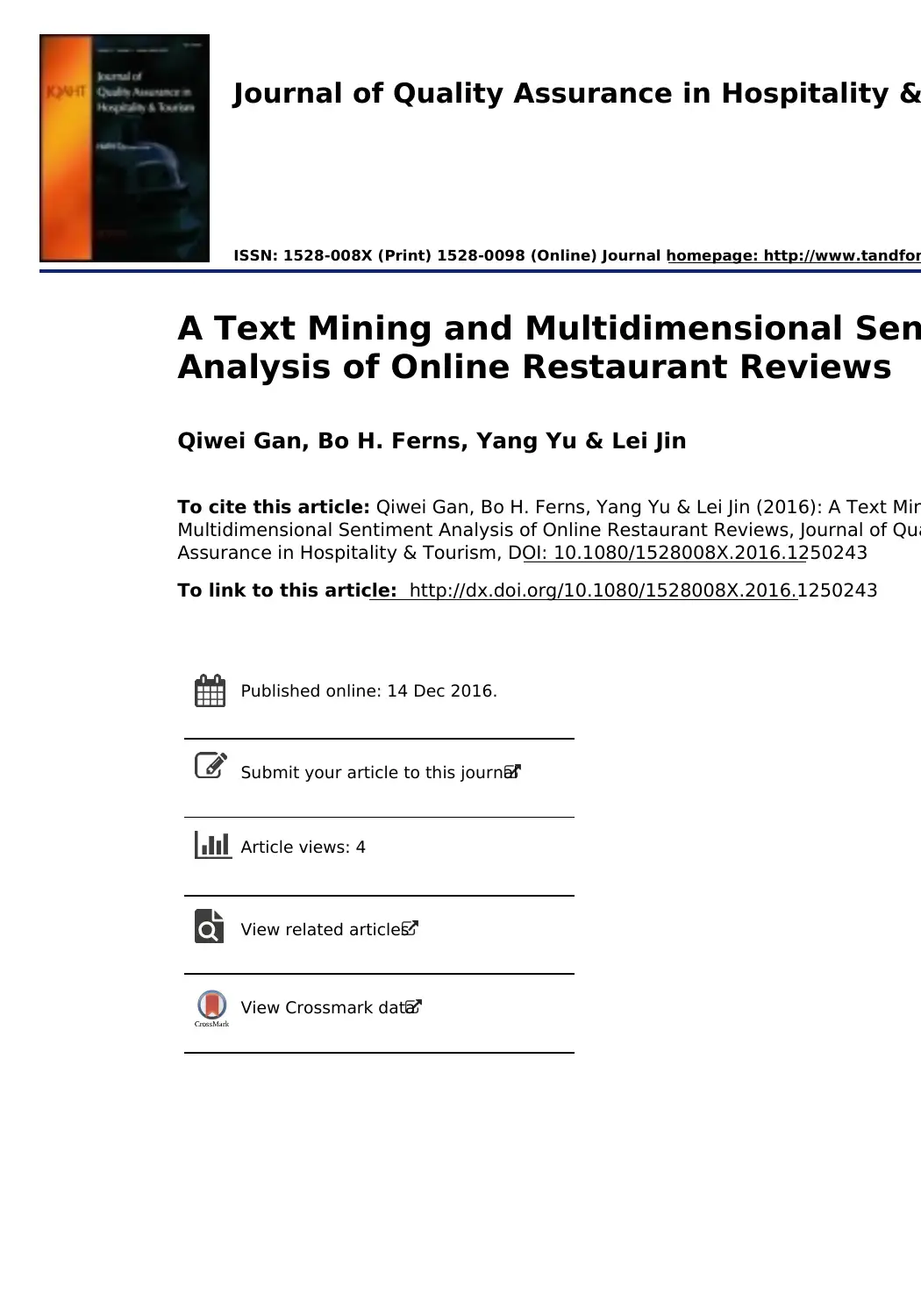
Journal of Quality Assurance in Hospitality &
ISSN: 1528-008X (Print) 1528-0098 (Online) Journal homepage: http://www.tandfon
A Text Mining and Multidimensional Sen
Analysis of Online Restaurant Reviews
Qiwei Gan, Bo H. Ferns, Yang Yu & Lei Jin
To cite this article: Qiwei Gan, Bo H. Ferns, Yang Yu & Lei Jin (2016): A Text Min
Multidimensional Sentiment Analysis of Online Restaurant Reviews, Journal of Qua
Assurance in Hospitality & Tourism, DOI: 10.1080/1528008X.2016.1250243
To link to this article: http://dx.doi.org/10.1080/1528008X.2016.1250243
Published online: 14 Dec 2016.
Submit your article to this journal
Article views: 4
View related articles
View Crossmark data
ISSN: 1528-008X (Print) 1528-0098 (Online) Journal homepage: http://www.tandfon
A Text Mining and Multidimensional Sen
Analysis of Online Restaurant Reviews
Qiwei Gan, Bo H. Ferns, Yang Yu & Lei Jin
To cite this article: Qiwei Gan, Bo H. Ferns, Yang Yu & Lei Jin (2016): A Text Min
Multidimensional Sentiment Analysis of Online Restaurant Reviews, Journal of Qua
Assurance in Hospitality & Tourism, DOI: 10.1080/1528008X.2016.1250243
To link to this article: http://dx.doi.org/10.1080/1528008X.2016.1250243
Published online: 14 Dec 2016.
Submit your article to this journal
Article views: 4
View related articles
View Crossmark data
Secure Best Marks with AI Grader
Need help grading? Try our AI Grader for instant feedback on your assignments.
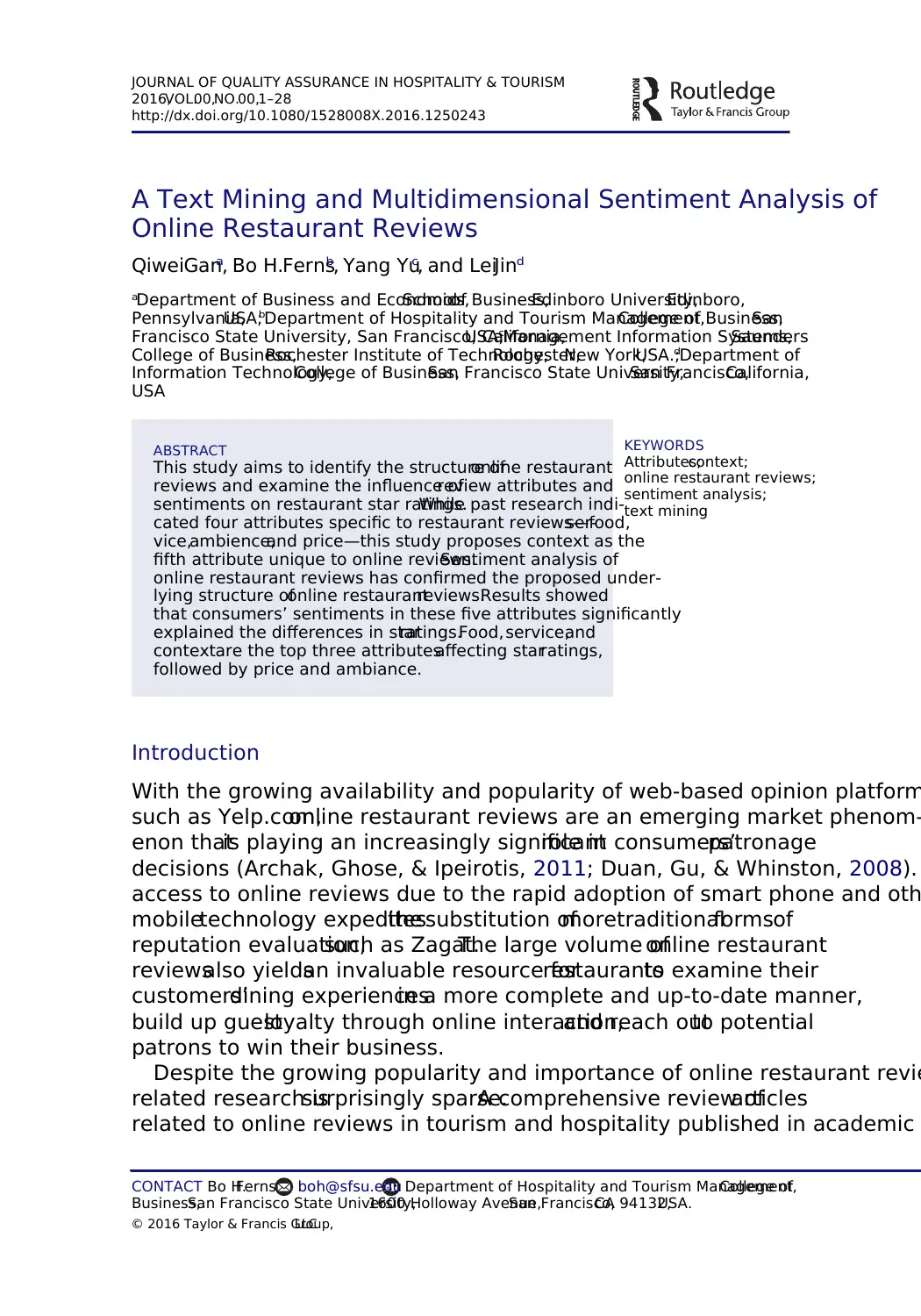
A Text Mining and Multidimensional Sentiment Analysis of
Online Restaurant Reviews
QiweiGana, Bo H.Fernsb, Yang Yuc, and LeiJind
aDepartment of Business and Economics,Schoolof Business,Edinboro University,Edinboro,
Pennsylvania,USA;bDepartment of Hospitality and Tourism Management,College of Business,San
Francisco State University, San Francisco, California,USA;cManagement Information Systems,Saunders
College of Business,Rochester Institute of Technology,Rochester,New York,USA.;dDepartment of
Information Technology,College of Business,San Francisco State University,San Francisco,California,
USA
ABSTRACT
This study aims to identify the structure ofonline restaurant
reviews and examine the influence ofreview attributes and
sentiments on restaurant star ratings.While past research indi-
cated four attributes specific to restaurant reviews—food,ser-
vice,ambience,and price—this study proposes context as the
fifth attribute unique to online reviews.Sentiment analysis of
online restaurant reviews has confirmed the proposed under-
lying structure ofonline restaurantreviews.Results showed
that consumers’ sentiments in these five attributes significantly
explained the differences in starratings.Food,service,and
contextare the top three attributesaffecting starratings,
followed by price and ambiance.
KEYWORDS
Attributes;context;
online restaurant reviews;
sentiment analysis;
text mining
Introduction
With the growing availability and popularity of web-based opinion platform
such as Yelp.com,online restaurant reviews are an emerging market phenom-
enon thatis playing an increasingly significantrole in consumers’patronage
decisions (Archak, Ghose, & Ipeirotis, 2011; Duan, Gu, & Whinston, 2008).
access to online reviews due to the rapid adoption of smart phone and oth
mobiletechnology expeditesthe substitution ofmoretraditionalformsof
reputation evaluation,such as Zagat.The large volume ofonline restaurant
reviewsalso yieldsan invaluable resource forrestaurantsto examine their
customers’dining experiencesin a more complete and up-to-date manner,
build up guestloyalty through online interaction,and reach outto potential
patrons to win their business.
Despite the growing popularity and importance of online restaurant revie
related research issurprisingly sparse.A comprehensive review ofarticles
related to online reviews in tourism and hospitality published in academic
CONTACT Bo H.Ferns boh@sfsu.edu Department of Hospitality and Tourism Management,College of
Business,San Francisco State University,1600 Holloway Avenue,San Francisco,CA 94132,USA.
JOURNAL OF QUALITY ASSURANCE IN HOSPITALITY & TOURISM
2016,VOL.00,NO.00,1–28
http://dx.doi.org/10.1080/1528008X.2016.1250243
© 2016 Taylor & Francis Group,LLC
Online Restaurant Reviews
QiweiGana, Bo H.Fernsb, Yang Yuc, and LeiJind
aDepartment of Business and Economics,Schoolof Business,Edinboro University,Edinboro,
Pennsylvania,USA;bDepartment of Hospitality and Tourism Management,College of Business,San
Francisco State University, San Francisco, California,USA;cManagement Information Systems,Saunders
College of Business,Rochester Institute of Technology,Rochester,New York,USA.;dDepartment of
Information Technology,College of Business,San Francisco State University,San Francisco,California,
USA
ABSTRACT
This study aims to identify the structure ofonline restaurant
reviews and examine the influence ofreview attributes and
sentiments on restaurant star ratings.While past research indi-
cated four attributes specific to restaurant reviews—food,ser-
vice,ambience,and price—this study proposes context as the
fifth attribute unique to online reviews.Sentiment analysis of
online restaurant reviews has confirmed the proposed under-
lying structure ofonline restaurantreviews.Results showed
that consumers’ sentiments in these five attributes significantly
explained the differences in starratings.Food,service,and
contextare the top three attributesaffecting starratings,
followed by price and ambiance.
KEYWORDS
Attributes;context;
online restaurant reviews;
sentiment analysis;
text mining
Introduction
With the growing availability and popularity of web-based opinion platform
such as Yelp.com,online restaurant reviews are an emerging market phenom-
enon thatis playing an increasingly significantrole in consumers’patronage
decisions (Archak, Ghose, & Ipeirotis, 2011; Duan, Gu, & Whinston, 2008).
access to online reviews due to the rapid adoption of smart phone and oth
mobiletechnology expeditesthe substitution ofmoretraditionalformsof
reputation evaluation,such as Zagat.The large volume ofonline restaurant
reviewsalso yieldsan invaluable resource forrestaurantsto examine their
customers’dining experiencesin a more complete and up-to-date manner,
build up guestloyalty through online interaction,and reach outto potential
patrons to win their business.
Despite the growing popularity and importance of online restaurant revie
related research issurprisingly sparse.A comprehensive review ofarticles
related to online reviews in tourism and hospitality published in academic
CONTACT Bo H.Ferns boh@sfsu.edu Department of Hospitality and Tourism Management,College of
Business,San Francisco State University,1600 Holloway Avenue,San Francisco,CA 94132,USA.
JOURNAL OF QUALITY ASSURANCE IN HOSPITALITY & TOURISM
2016,VOL.00,NO.00,1–28
http://dx.doi.org/10.1080/1528008X.2016.1250243
© 2016 Taylor & Francis Group,LLC
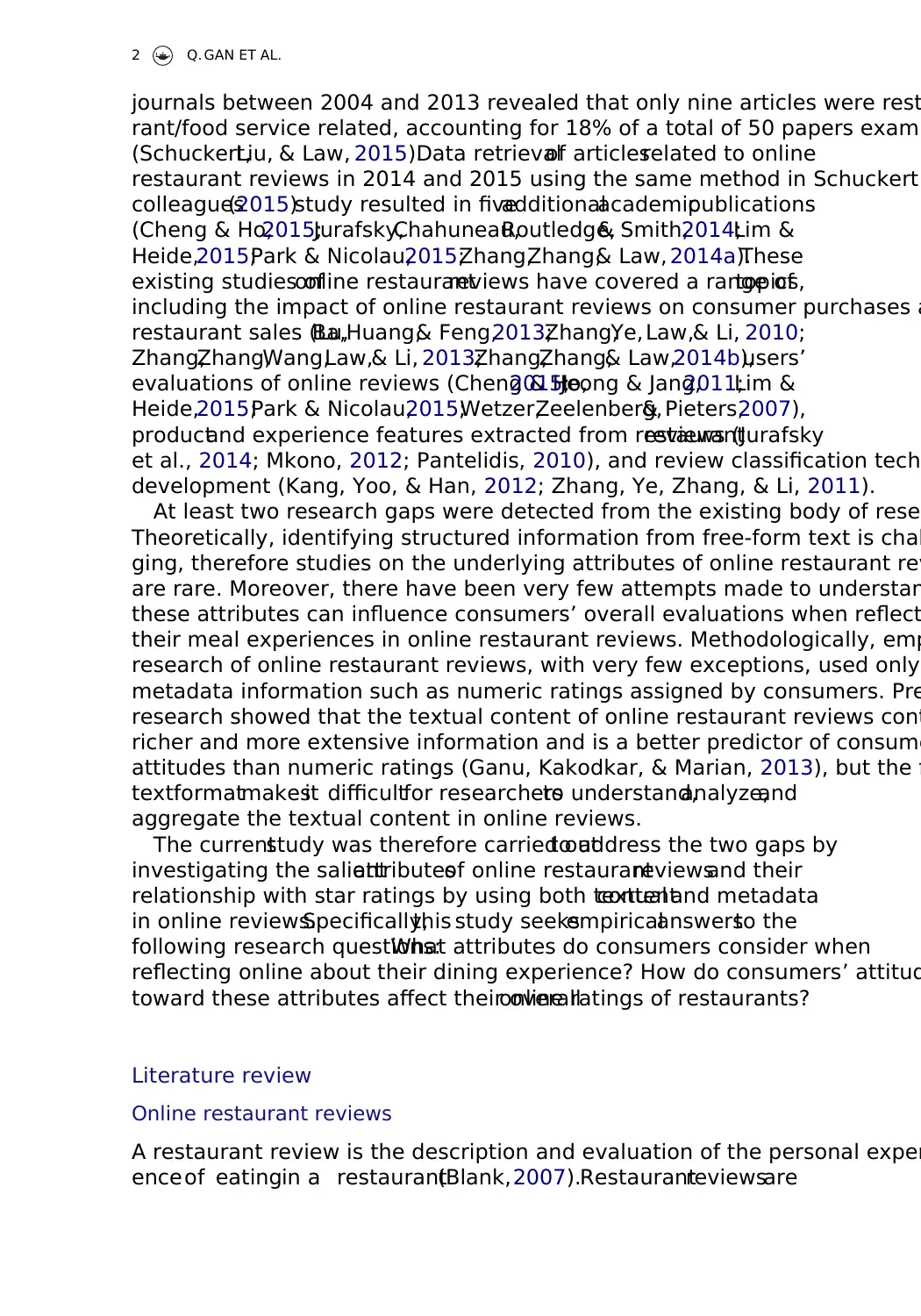
journals between 2004 and 2013 revealed that only nine articles were rest
rant/food service related, accounting for 18% of a total of 50 papers exami
(Schuckert,Liu, & Law, 2015).Data retrievalof articlesrelated to online
restaurant reviews in 2014 and 2015 using the same method in Schuckert
colleagues(2015)study resulted in fiveadditionalacademicpublications
(Cheng & Ho,2015;Jurafsky,Chahuneau,Routledge,& Smith,2014;Lim &
Heide,2015;Park & Nicolau,2015;Zhang,Zhang,& Law, 2014a).These
existing studies ofonline restaurantreviews have covered a range oftopics,
including the impact of online restaurant reviews on consumer purchases a
restaurant sales (Lu,Ba,Huang,& Feng,2013;Zhang,Ye, Law,& Li, 2010;
Zhang,Zhang,Wang,Law,& Li, 2013;Zhang,Zhang,& Law,2014b),users’
evaluations of online reviews (Cheng & Ho,2015;Jeong & Jang,2011;Lim &
Heide,2015;Park & Nicolau,2015;Wetzer,Zeelenberg,& Pieters,2007),
productand experience features extracted from restaurantreviews (Jurafsky
et al., 2014; Mkono, 2012; Pantelidis, 2010), and review classification techn
development (Kang, Yoo, & Han, 2012; Zhang, Ye, Zhang, & Li, 2011).
At least two research gaps were detected from the existing body of resea
Theoretically, identifying structured information from free-form text is chal
ging, therefore studies on the underlying attributes of online restaurant rev
are rare. Moreover, there have been very few attempts made to understan
these attributes can influence consumers’ overall evaluations when reflect
their meal experiences in online restaurant reviews. Methodologically, emp
research of online restaurant reviews, with very few exceptions, used only
metadata information such as numeric ratings assigned by consumers. Pre
research showed that the textual content of online restaurant reviews cont
richer and more extensive information and is a better predictor of consume
attitudes than numeric ratings (Ganu, Kakodkar, & Marian, 2013), but the f
textformatmakesit difficultfor researchersto understand,analyze,and
aggregate the textual content in online reviews.
The currentstudy was therefore carried outto address the two gaps by
investigating the salientattributesof online restaurantreviewsand their
relationship with star ratings by using both textualcontentand metadata
in online reviews.Specifically,this study seeksempiricalanswersto the
following research questions:What attributes do consumers consider when
reflecting online about their dining experience? How do consumers’ attitud
toward these attributes affect their overallonline ratings of restaurants?
Literature review
Online restaurant reviews
A restaurant review is the description and evaluation of the personal exper
enceof eatingin a restaurant(Blank,2007).Restaurantreviewsare
2 Q. GAN ET AL.
rant/food service related, accounting for 18% of a total of 50 papers exami
(Schuckert,Liu, & Law, 2015).Data retrievalof articlesrelated to online
restaurant reviews in 2014 and 2015 using the same method in Schuckert
colleagues(2015)study resulted in fiveadditionalacademicpublications
(Cheng & Ho,2015;Jurafsky,Chahuneau,Routledge,& Smith,2014;Lim &
Heide,2015;Park & Nicolau,2015;Zhang,Zhang,& Law, 2014a).These
existing studies ofonline restaurantreviews have covered a range oftopics,
including the impact of online restaurant reviews on consumer purchases a
restaurant sales (Lu,Ba,Huang,& Feng,2013;Zhang,Ye, Law,& Li, 2010;
Zhang,Zhang,Wang,Law,& Li, 2013;Zhang,Zhang,& Law,2014b),users’
evaluations of online reviews (Cheng & Ho,2015;Jeong & Jang,2011;Lim &
Heide,2015;Park & Nicolau,2015;Wetzer,Zeelenberg,& Pieters,2007),
productand experience features extracted from restaurantreviews (Jurafsky
et al., 2014; Mkono, 2012; Pantelidis, 2010), and review classification techn
development (Kang, Yoo, & Han, 2012; Zhang, Ye, Zhang, & Li, 2011).
At least two research gaps were detected from the existing body of resea
Theoretically, identifying structured information from free-form text is chal
ging, therefore studies on the underlying attributes of online restaurant rev
are rare. Moreover, there have been very few attempts made to understan
these attributes can influence consumers’ overall evaluations when reflect
their meal experiences in online restaurant reviews. Methodologically, emp
research of online restaurant reviews, with very few exceptions, used only
metadata information such as numeric ratings assigned by consumers. Pre
research showed that the textual content of online restaurant reviews cont
richer and more extensive information and is a better predictor of consume
attitudes than numeric ratings (Ganu, Kakodkar, & Marian, 2013), but the f
textformatmakesit difficultfor researchersto understand,analyze,and
aggregate the textual content in online reviews.
The currentstudy was therefore carried outto address the two gaps by
investigating the salientattributesof online restaurantreviewsand their
relationship with star ratings by using both textualcontentand metadata
in online reviews.Specifically,this study seeksempiricalanswersto the
following research questions:What attributes do consumers consider when
reflecting online about their dining experience? How do consumers’ attitud
toward these attributes affect their overallonline ratings of restaurants?
Literature review
Online restaurant reviews
A restaurant review is the description and evaluation of the personal exper
enceof eatingin a restaurant(Blank,2007).Restaurantreviewsare
2 Q. GAN ET AL.
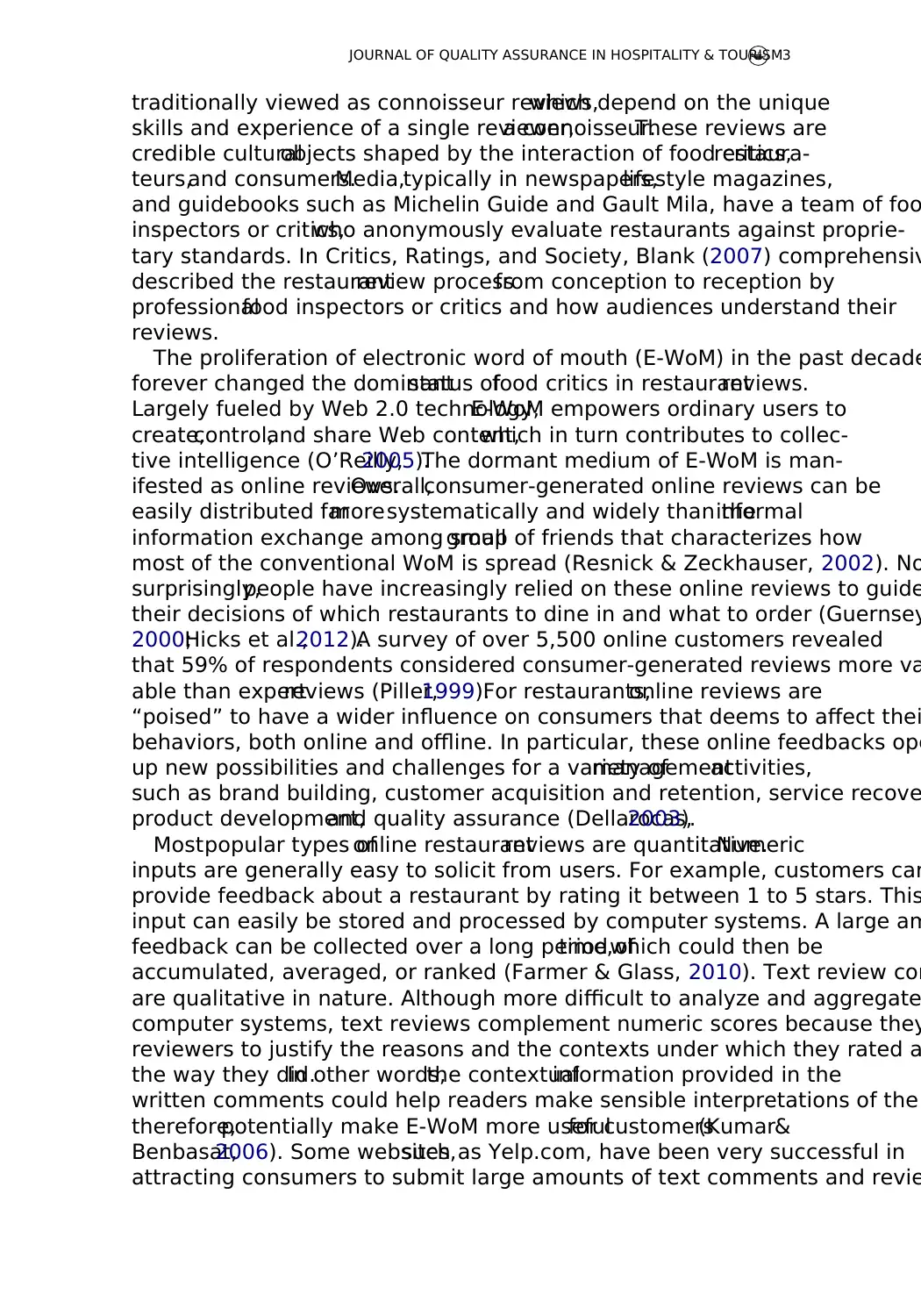
traditionally viewed as connoisseur reviews,which depend on the unique
skills and experience of a single reviewer,a connoisseur.These reviews are
credible culturalobjects shaped by the interaction of food critics,restaura-
teurs,and consumers.Media,typically in newspapers,lifestyle magazines,
and guidebooks such as Michelin Guide and Gault Mila, have a team of foo
inspectors or critics,who anonymously evaluate restaurants against proprie-
tary standards. In Critics, Ratings, and Society, Blank (2007) comprehensiv
described the restaurantreview processfrom conception to reception by
professionalfood inspectors or critics and how audiences understand their
reviews.
The proliferation of electronic word of mouth (E-WoM) in the past decade
forever changed the dominantstatus offood critics in restaurantreviews.
Largely fueled by Web 2.0 technology,E-WoM empowers ordinary users to
create,control,and share Web content,which in turn contributes to collec-
tive intelligence (O’Reilly,2005).The dormant medium of E-WoM is man-
ifested as online reviews.Overall,consumer-generated online reviews can be
easily distributed farmoresystematically and widely than theinformal
information exchange among smallgroup of friends that characterizes how
most of the conventional WoM is spread (Resnick & Zeckhauser, 2002). No
surprisingly,people have increasingly relied on these online reviews to guide
their decisions of which restaurants to dine in and what to order (Guernsey
2000;Hicks et al.,2012).A survey of over 5,500 online customers revealed
that 59% of respondents considered consumer-generated reviews more va
able than expertreviews (Piller,1999).For restaurants,online reviews are
“poised” to have a wider influence on consumers that deems to affect thei
behaviors, both online and offline. In particular, these online feedbacks ope
up new possibilities and challenges for a variety ofmanagementactivities,
such as brand building, customer acquisition and retention, service recove
product development,and quality assurance (Dellarocas,2003).
Mostpopular types ofonline restaurantreviews are quantitative.Numeric
inputs are generally easy to solicit from users. For example, customers can
provide feedback about a restaurant by rating it between 1 to 5 stars. This
input can easily be stored and processed by computer systems. A large am
feedback can be collected over a long period oftime,which could then be
accumulated, averaged, or ranked (Farmer & Glass, 2010). Text review com
are qualitative in nature. Although more difficult to analyze and aggregate
computer systems, text reviews complement numeric scores because they
reviewers to justify the reasons and the contexts under which they rated a
the way they did.In other words,the contextualinformation provided in the
written comments could help readers make sensible interpretations of the
therefore,potentially make E-WoM more usefulfor customers(Kumar&
Benbasat,2006). Some websites,such as Yelp.com, have been very successful in
attracting consumers to submit large amounts of text comments and revie
JOURNAL OF QUALITY ASSURANCE IN HOSPITALITY & TOURISM3
skills and experience of a single reviewer,a connoisseur.These reviews are
credible culturalobjects shaped by the interaction of food critics,restaura-
teurs,and consumers.Media,typically in newspapers,lifestyle magazines,
and guidebooks such as Michelin Guide and Gault Mila, have a team of foo
inspectors or critics,who anonymously evaluate restaurants against proprie-
tary standards. In Critics, Ratings, and Society, Blank (2007) comprehensiv
described the restaurantreview processfrom conception to reception by
professionalfood inspectors or critics and how audiences understand their
reviews.
The proliferation of electronic word of mouth (E-WoM) in the past decade
forever changed the dominantstatus offood critics in restaurantreviews.
Largely fueled by Web 2.0 technology,E-WoM empowers ordinary users to
create,control,and share Web content,which in turn contributes to collec-
tive intelligence (O’Reilly,2005).The dormant medium of E-WoM is man-
ifested as online reviews.Overall,consumer-generated online reviews can be
easily distributed farmoresystematically and widely than theinformal
information exchange among smallgroup of friends that characterizes how
most of the conventional WoM is spread (Resnick & Zeckhauser, 2002). No
surprisingly,people have increasingly relied on these online reviews to guide
their decisions of which restaurants to dine in and what to order (Guernsey
2000;Hicks et al.,2012).A survey of over 5,500 online customers revealed
that 59% of respondents considered consumer-generated reviews more va
able than expertreviews (Piller,1999).For restaurants,online reviews are
“poised” to have a wider influence on consumers that deems to affect thei
behaviors, both online and offline. In particular, these online feedbacks ope
up new possibilities and challenges for a variety ofmanagementactivities,
such as brand building, customer acquisition and retention, service recove
product development,and quality assurance (Dellarocas,2003).
Mostpopular types ofonline restaurantreviews are quantitative.Numeric
inputs are generally easy to solicit from users. For example, customers can
provide feedback about a restaurant by rating it between 1 to 5 stars. This
input can easily be stored and processed by computer systems. A large am
feedback can be collected over a long period oftime,which could then be
accumulated, averaged, or ranked (Farmer & Glass, 2010). Text review com
are qualitative in nature. Although more difficult to analyze and aggregate
computer systems, text reviews complement numeric scores because they
reviewers to justify the reasons and the contexts under which they rated a
the way they did.In other words,the contextualinformation provided in the
written comments could help readers make sensible interpretations of the
therefore,potentially make E-WoM more usefulfor customers(Kumar&
Benbasat,2006). Some websites,such as Yelp.com, have been very successful in
attracting consumers to submit large amounts of text comments and revie
JOURNAL OF QUALITY ASSURANCE IN HOSPITALITY & TOURISM3
Secure Best Marks with AI Grader
Need help grading? Try our AI Grader for instant feedback on your assignments.
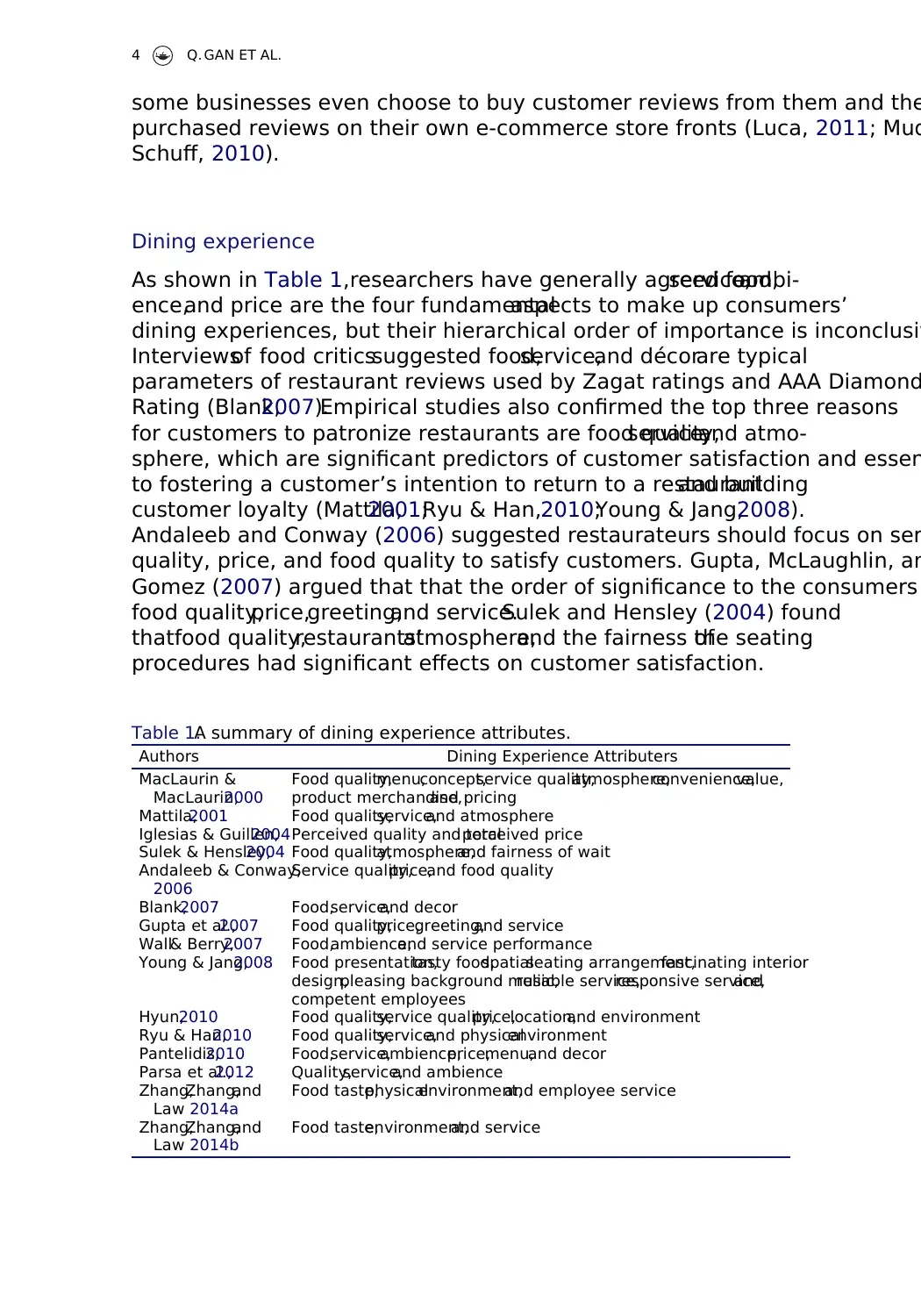
some businesses even choose to buy customer reviews from them and the
purchased reviews on their own e-commerce store fronts (Luca, 2011; Mud
Schuff, 2010).
Dining experience
As shown in Table 1,researchers have generally agreed food,service,ambi-
ence,and price are the four fundamentalaspects to make up consumers’
dining experiences, but their hierarchical order of importance is inconclusiv
Interviewsof food criticssuggested food,service,and décorare typical
parameters of restaurant reviews used by Zagat ratings and AAA Diamond
Rating (Blank,2007).Empirical studies also confirmed the top three reasons
for customers to patronize restaurants are food quality,service,and atmo-
sphere, which are significant predictors of customer satisfaction and essen
to fostering a customer’s intention to return to a restaurantand building
customer loyalty (Mattila,2001;Ryu & Han,2010;Young & Jang,2008).
Andaleeb and Conway (2006) suggested restaurateurs should focus on ser
quality, price, and food quality to satisfy customers. Gupta, McLaughlin, an
Gomez (2007) argued that that the order of significance to the consumers
food quality,price,greeting,and service.Sulek and Hensley (2004) found
thatfood quality,restaurants’atmosphere,and the fairness ofthe seating
procedures had significant effects on customer satisfaction.
Table 1.A summary of dining experience attributes.
Authors Dining Experience Attributers
MacLaurin &
MacLaurin,2000
Food quality,menu,concept,service quality,atmosphere,convenience,value,
product merchandise,and pricing
Mattila,2001 Food quality,service,and atmosphere
Iglesias & Guillen,2004Perceived quality and totalperceived price
Sulek & Hensley,2004 Food quality,atmosphere,and fairness of wait
Andaleeb & Conway,
2006
Service quality,price,and food quality
Blank,2007 Food,service,and decor
Gupta et al.,2007 Food quality,price,greeting,and service
Wall& Berry,2007 Food,ambience,and service performance
Young & Jang,2008 Food presentation,tasty food,spatialseating arrangement,fascinating interior
design,pleasing background music,reliable service,responsive service,and
competent employees
Hyun,2010 Food quality,service quality,price,location,and environment
Ryu & Han,2010 Food quality,service,and physicalenvironment
Pantelidis,2010 Food,service,ambience,price,menu,and decor
Parsa et al.,2012 Quality,service,and ambience
Zhang,Zhang,and
Law 2014a
Food taste,physicalenvironment,and employee service
Zhang,Zhang,and
Law 2014b
Food taste,environment,and service
4 Q. GAN ET AL.
purchased reviews on their own e-commerce store fronts (Luca, 2011; Mud
Schuff, 2010).
Dining experience
As shown in Table 1,researchers have generally agreed food,service,ambi-
ence,and price are the four fundamentalaspects to make up consumers’
dining experiences, but their hierarchical order of importance is inconclusiv
Interviewsof food criticssuggested food,service,and décorare typical
parameters of restaurant reviews used by Zagat ratings and AAA Diamond
Rating (Blank,2007).Empirical studies also confirmed the top three reasons
for customers to patronize restaurants are food quality,service,and atmo-
sphere, which are significant predictors of customer satisfaction and essen
to fostering a customer’s intention to return to a restaurantand building
customer loyalty (Mattila,2001;Ryu & Han,2010;Young & Jang,2008).
Andaleeb and Conway (2006) suggested restaurateurs should focus on ser
quality, price, and food quality to satisfy customers. Gupta, McLaughlin, an
Gomez (2007) argued that that the order of significance to the consumers
food quality,price,greeting,and service.Sulek and Hensley (2004) found
thatfood quality,restaurants’atmosphere,and the fairness ofthe seating
procedures had significant effects on customer satisfaction.
Table 1.A summary of dining experience attributes.
Authors Dining Experience Attributers
MacLaurin &
MacLaurin,2000
Food quality,menu,concept,service quality,atmosphere,convenience,value,
product merchandise,and pricing
Mattila,2001 Food quality,service,and atmosphere
Iglesias & Guillen,2004Perceived quality and totalperceived price
Sulek & Hensley,2004 Food quality,atmosphere,and fairness of wait
Andaleeb & Conway,
2006
Service quality,price,and food quality
Blank,2007 Food,service,and decor
Gupta et al.,2007 Food quality,price,greeting,and service
Wall& Berry,2007 Food,ambience,and service performance
Young & Jang,2008 Food presentation,tasty food,spatialseating arrangement,fascinating interior
design,pleasing background music,reliable service,responsive service,and
competent employees
Hyun,2010 Food quality,service quality,price,location,and environment
Ryu & Han,2010 Food quality,service,and physicalenvironment
Pantelidis,2010 Food,service,ambience,price,menu,and decor
Parsa et al.,2012 Quality,service,and ambience
Zhang,Zhang,and
Law 2014a
Food taste,physicalenvironment,and employee service
Zhang,Zhang,and
Law 2014b
Food taste,environment,and service
4 Q. GAN ET AL.
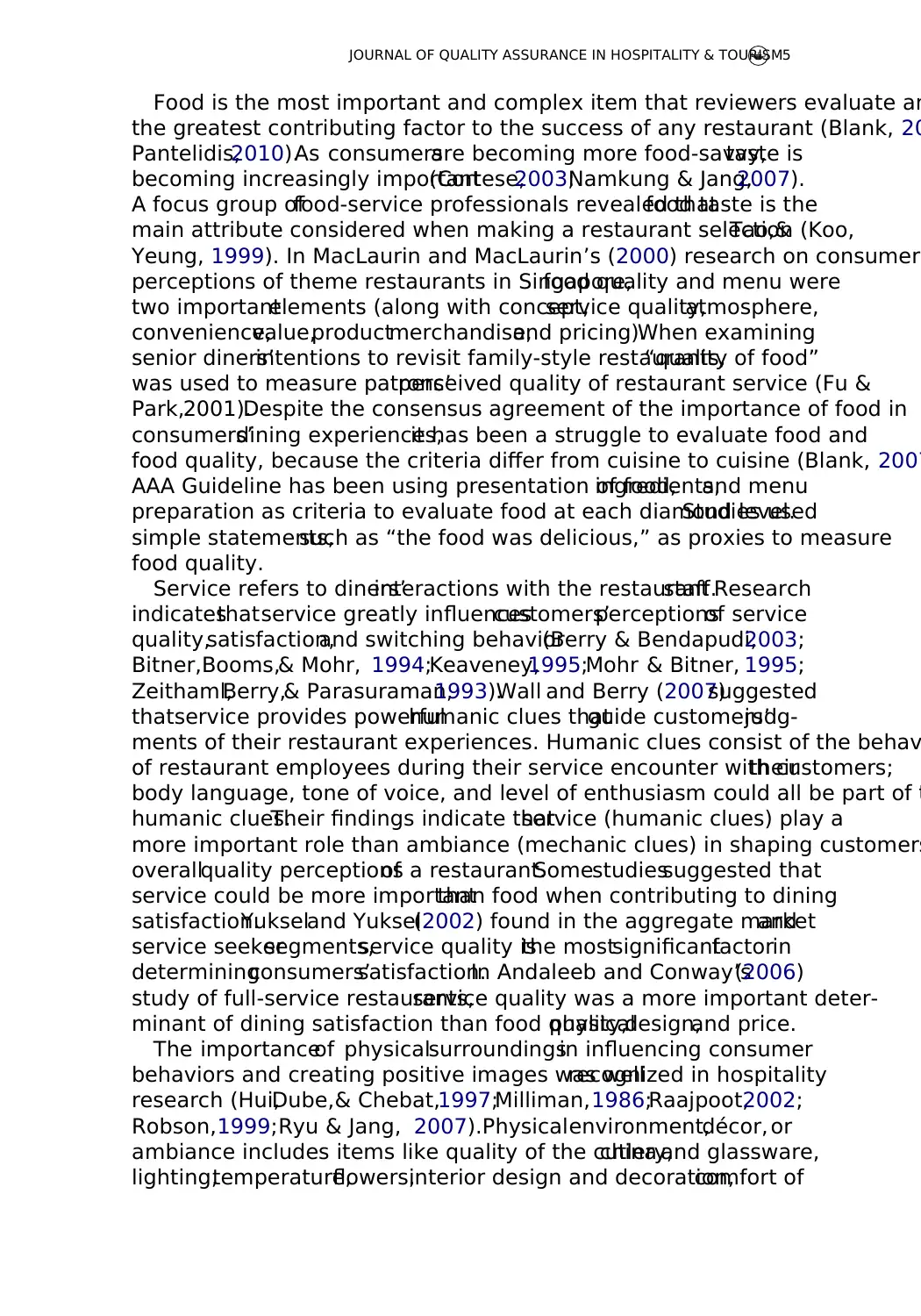
Food is the most important and complex item that reviewers evaluate an
the greatest contributing factor to the success of any restaurant (Blank, 20
Pantelidis,2010).As consumersare becoming more food-savvy,taste is
becoming increasingly important(Cortese,2003;Namkung & Jang,2007).
A focus group offood-service professionals revealed thatfood taste is the
main attribute considered when making a restaurant selection (Koo,Tao,&
Yeung, 1999). In MacLaurin and MacLaurin’s (2000) research on consumers
perceptions of theme restaurants in Singapore,food quality and menu were
two importantelements (along with concept,service quality,atmosphere,
convenience,value,productmerchandise,and pricing).When examining
senior diners’intentions to revisit family-style restaurants,“quality of food”
was used to measure patrons’perceived quality of restaurant service (Fu &
Park,2001).Despite the consensus agreement of the importance of food in
consumers’dining experiences,it has been a struggle to evaluate food and
food quality, because the criteria differ from cuisine to cuisine (Blank, 2007
AAA Guideline has been using presentation of food,ingredients,and menu
preparation as criteria to evaluate food at each diamond level.Studies used
simple statements,such as “the food was delicious,” as proxies to measure
food quality.
Service refers to diners’interactions with the restaurantstaff.Research
indicatesthatservice greatly influencescustomers’perceptionsof service
quality,satisfaction,and switching behavior(Berry & Bendapudi,2003;
Bitner,Booms,& Mohr, 1994;Keaveney,1995;Mohr & Bitner, 1995;
Zeithaml,Berry,& Parasuraman,1993).Wall and Berry (2007)suggested
thatservice provides powerfulhumanic clues thatguide customers’judg-
ments of their restaurant experiences. Humanic clues consist of the behav
of restaurant employees during their service encounter with customers;their
body language, tone of voice, and level of enthusiasm could all be part of t
humanic clues.Their findings indicate thatservice (humanic clues) play a
more important role than ambiance (mechanic clues) in shaping customers
overallquality perceptionsof a restaurant.Somestudiessuggested that
service could be more importantthan food when contributing to dining
satisfaction.Yukseland Yuksel(2002) found in the aggregate marketand
service seekersegments,service quality isthe mostsignificantfactorin
determiningconsumers’satisfaction.In Andaleeb and Conway’s(2006)
study of full-service restaurants,service quality was a more important deter-
minant of dining satisfaction than food quality,physicaldesign,and price.
The importanceof physicalsurroundingsin influencing consumer
behaviors and creating positive images was wellrecognized in hospitality
research (Hui,Dube,& Chebat,1997;Milliman,1986;Raajpoot,2002;
Robson,1999;Ryu & Jang, 2007).Physicalenvironment,décor, or
ambiance includes items like quality of the cutlery,china,and glassware,
lighting,temperature,flowers,interior design and decoration,comfort of
JOURNAL OF QUALITY ASSURANCE IN HOSPITALITY & TOURISM5
the greatest contributing factor to the success of any restaurant (Blank, 20
Pantelidis,2010).As consumersare becoming more food-savvy,taste is
becoming increasingly important(Cortese,2003;Namkung & Jang,2007).
A focus group offood-service professionals revealed thatfood taste is the
main attribute considered when making a restaurant selection (Koo,Tao,&
Yeung, 1999). In MacLaurin and MacLaurin’s (2000) research on consumers
perceptions of theme restaurants in Singapore,food quality and menu were
two importantelements (along with concept,service quality,atmosphere,
convenience,value,productmerchandise,and pricing).When examining
senior diners’intentions to revisit family-style restaurants,“quality of food”
was used to measure patrons’perceived quality of restaurant service (Fu &
Park,2001).Despite the consensus agreement of the importance of food in
consumers’dining experiences,it has been a struggle to evaluate food and
food quality, because the criteria differ from cuisine to cuisine (Blank, 2007
AAA Guideline has been using presentation of food,ingredients,and menu
preparation as criteria to evaluate food at each diamond level.Studies used
simple statements,such as “the food was delicious,” as proxies to measure
food quality.
Service refers to diners’interactions with the restaurantstaff.Research
indicatesthatservice greatly influencescustomers’perceptionsof service
quality,satisfaction,and switching behavior(Berry & Bendapudi,2003;
Bitner,Booms,& Mohr, 1994;Keaveney,1995;Mohr & Bitner, 1995;
Zeithaml,Berry,& Parasuraman,1993).Wall and Berry (2007)suggested
thatservice provides powerfulhumanic clues thatguide customers’judg-
ments of their restaurant experiences. Humanic clues consist of the behav
of restaurant employees during their service encounter with customers;their
body language, tone of voice, and level of enthusiasm could all be part of t
humanic clues.Their findings indicate thatservice (humanic clues) play a
more important role than ambiance (mechanic clues) in shaping customers
overallquality perceptionsof a restaurant.Somestudiessuggested that
service could be more importantthan food when contributing to dining
satisfaction.Yukseland Yuksel(2002) found in the aggregate marketand
service seekersegments,service quality isthe mostsignificantfactorin
determiningconsumers’satisfaction.In Andaleeb and Conway’s(2006)
study of full-service restaurants,service quality was a more important deter-
minant of dining satisfaction than food quality,physicaldesign,and price.
The importanceof physicalsurroundingsin influencing consumer
behaviors and creating positive images was wellrecognized in hospitality
research (Hui,Dube,& Chebat,1997;Milliman,1986;Raajpoot,2002;
Robson,1999;Ryu & Jang, 2007).Physicalenvironment,décor, or
ambiance includes items like quality of the cutlery,china,and glassware,
lighting,temperature,flowers,interior design and decoration,comfort of
JOURNAL OF QUALITY ASSURANCE IN HOSPITALITY & TOURISM5
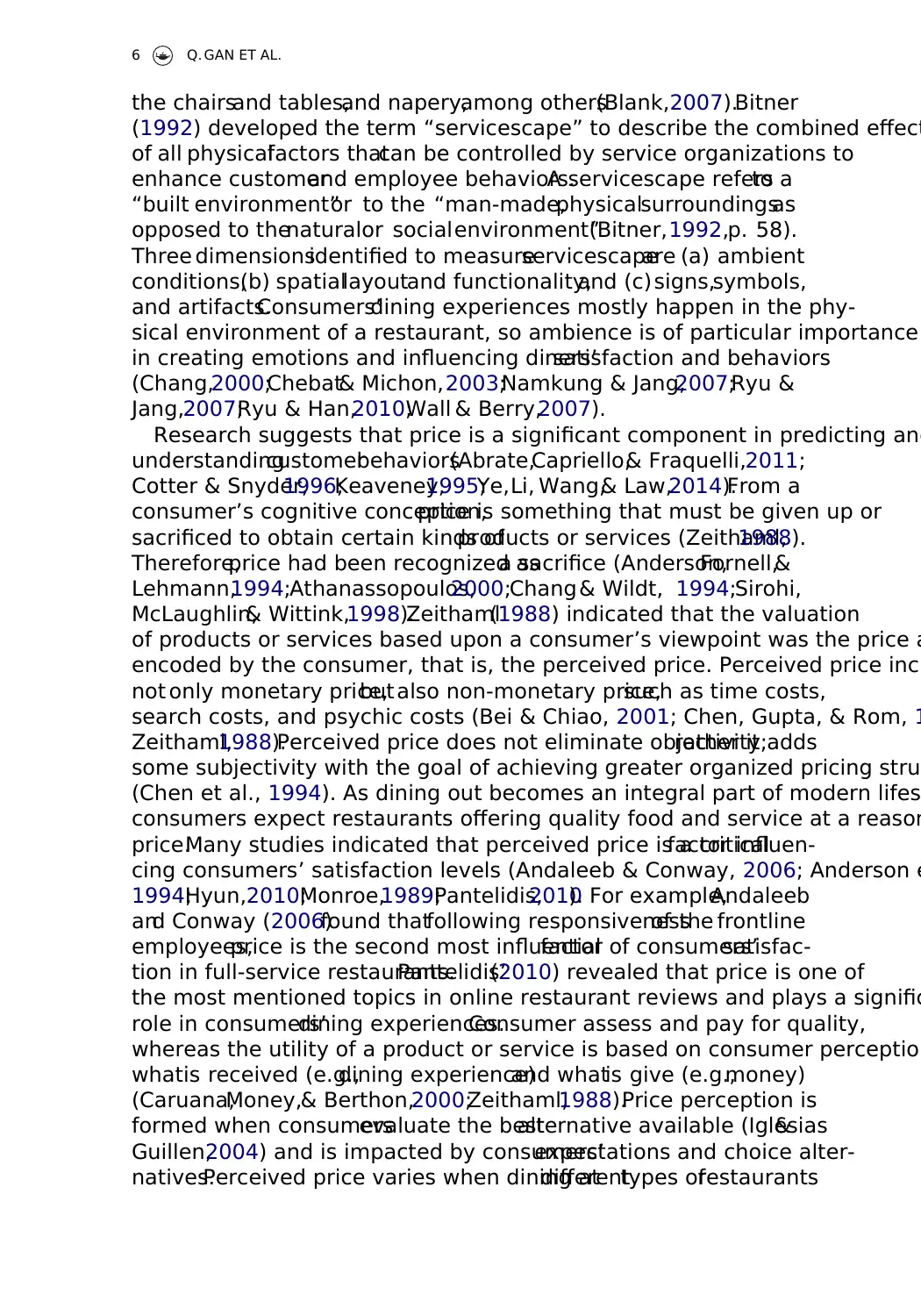
the chairsand tables,and napery,among others(Blank,2007).Bitner
(1992) developed the term “servicescape” to describe the combined effect
of all physicalfactors thatcan be controlled by service organizations to
enhance customerand employee behaviors.A servicescape refersto a
“built environment”or to the “man-made,physicalsurroundingsas
opposed to thenaturalor socialenvironment”(Bitner,1992,p. 58).
Three dimensionsidentified to measureservicescapeare (a) ambient
conditions,(b) spatiallayoutand functionality,and (c)signs,symbols,
and artifacts.Consumers’dining experiences mostly happen in the phy-
sical environment of a restaurant, so ambience is of particular importance
in creating emotions and influencing diners’satisfaction and behaviors
(Chang,2000;Chebat& Michon,2003;Namkung & Jang,2007;Ryu &
Jang,2007;Ryu & Han,2010;Wall & Berry,2007).
Research suggests that price is a significant component in predicting and
understandingcustomerbehaviors(Abrate,Capriello,& Fraquelli,2011;
Cotter & Snyder,1996;Keaveney,1995;Ye,Li, Wang,& Law,2014).From a
consumer’s cognitive conception,price is something that must be given up or
sacrificed to obtain certain kinds ofproducts or services (Zeithaml,1988).
Therefore,price had been recognized asa sacrifice (Anderson,Fornell,&
Lehmann,1994;Athanassopoulos,2000;Chang& Wildt, 1994;Sirohi,
McLaughlin,& Wittink,1998).Zeithaml(1988) indicated that the valuation
of products or services based upon a consumer’s viewpoint was the price a
encoded by the consumer, that is, the perceived price. Perceived price incl
not only monetary price,but also non-monetary price,such as time costs,
search costs, and psychic costs (Bei & Chiao, 2001; Chen, Gupta, & Rom, 1
Zeithaml,1988).Perceived price does not eliminate objectivity;rather it adds
some subjectivity with the goal of achieving greater organized pricing struc
(Chen et al., 1994). As dining out becomes an integral part of modern lifes
consumers expect restaurants offering quality food and service at a reason
price.Many studies indicated that perceived price is a criticalfactor influen-
cing consumers’ satisfaction levels (Andaleeb & Conway, 2006; Anderson e
1994;Hyun,2010;Monroe,1989;Pantelidis,2010). For example,Andaleeb
and Conway (2006)found thatfollowing responsivenessof the frontline
employees,price is the second most influentialfactor of consumers’satisfac-
tion in full-service restaurants.Pantelidis’(2010) revealed that price is one of
the most mentioned topics in online restaurant reviews and plays a signific
role in consumers’dining experiences.Consumer assess and pay for quality,
whereas the utility of a product or service is based on consumer perception
whatis received (e.g.,dining experience)and whatis give (e.g.,money)
(Caruana,Money,& Berthon,2000;Zeithaml,1988).Price perception is
formed when consumersevaluate the bestalternative available (Iglesias&
Guillen,2004) and is impacted by consumers’expectations and choice alter-
natives.Perceived price varies when dining atdifferenttypes ofrestaurants
6 Q. GAN ET AL.
(1992) developed the term “servicescape” to describe the combined effect
of all physicalfactors thatcan be controlled by service organizations to
enhance customerand employee behaviors.A servicescape refersto a
“built environment”or to the “man-made,physicalsurroundingsas
opposed to thenaturalor socialenvironment”(Bitner,1992,p. 58).
Three dimensionsidentified to measureservicescapeare (a) ambient
conditions,(b) spatiallayoutand functionality,and (c)signs,symbols,
and artifacts.Consumers’dining experiences mostly happen in the phy-
sical environment of a restaurant, so ambience is of particular importance
in creating emotions and influencing diners’satisfaction and behaviors
(Chang,2000;Chebat& Michon,2003;Namkung & Jang,2007;Ryu &
Jang,2007;Ryu & Han,2010;Wall & Berry,2007).
Research suggests that price is a significant component in predicting and
understandingcustomerbehaviors(Abrate,Capriello,& Fraquelli,2011;
Cotter & Snyder,1996;Keaveney,1995;Ye,Li, Wang,& Law,2014).From a
consumer’s cognitive conception,price is something that must be given up or
sacrificed to obtain certain kinds ofproducts or services (Zeithaml,1988).
Therefore,price had been recognized asa sacrifice (Anderson,Fornell,&
Lehmann,1994;Athanassopoulos,2000;Chang& Wildt, 1994;Sirohi,
McLaughlin,& Wittink,1998).Zeithaml(1988) indicated that the valuation
of products or services based upon a consumer’s viewpoint was the price a
encoded by the consumer, that is, the perceived price. Perceived price incl
not only monetary price,but also non-monetary price,such as time costs,
search costs, and psychic costs (Bei & Chiao, 2001; Chen, Gupta, & Rom, 1
Zeithaml,1988).Perceived price does not eliminate objectivity;rather it adds
some subjectivity with the goal of achieving greater organized pricing struc
(Chen et al., 1994). As dining out becomes an integral part of modern lifes
consumers expect restaurants offering quality food and service at a reason
price.Many studies indicated that perceived price is a criticalfactor influen-
cing consumers’ satisfaction levels (Andaleeb & Conway, 2006; Anderson e
1994;Hyun,2010;Monroe,1989;Pantelidis,2010). For example,Andaleeb
and Conway (2006)found thatfollowing responsivenessof the frontline
employees,price is the second most influentialfactor of consumers’satisfac-
tion in full-service restaurants.Pantelidis’(2010) revealed that price is one of
the most mentioned topics in online restaurant reviews and plays a signific
role in consumers’dining experiences.Consumer assess and pay for quality,
whereas the utility of a product or service is based on consumer perception
whatis received (e.g.,dining experience)and whatis give (e.g.,money)
(Caruana,Money,& Berthon,2000;Zeithaml,1988).Price perception is
formed when consumersevaluate the bestalternative available (Iglesias&
Guillen,2004) and is impacted by consumers’expectations and choice alter-
natives.Perceived price varies when dining atdifferenttypes ofrestaurants
6 Q. GAN ET AL.
Paraphrase This Document
Need a fresh take? Get an instant paraphrase of this document with our AI Paraphraser
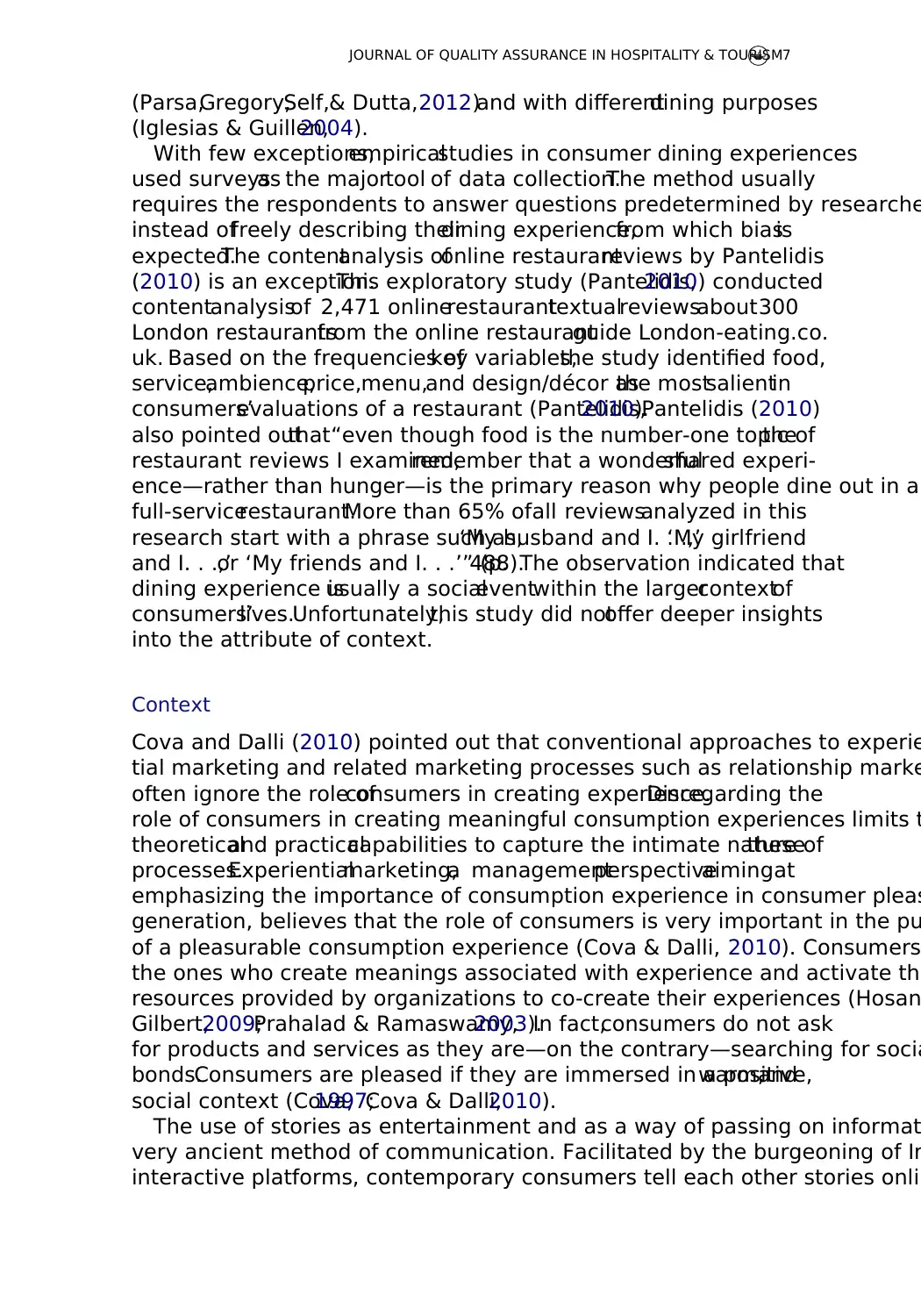
(Parsa,Gregory,Self,& Dutta,2012)and with differentdining purposes
(Iglesias & Guillen,2004).
With few exceptions,empiricalstudies in consumer dining experiences
used surveysas the majortool of data collection.The method usually
requires the respondents to answer questions predetermined by researche
instead offreely describing theirdining experience,from which biasis
expected.The contentanalysis ofonline restaurantreviews by Pantelidis
(2010) is an exception.This exploratory study (Pantelidis,2010) conducted
contentanalysisof 2,471 onlinerestauranttextualreviewsabout300
London restaurantsfrom the online restaurantguide London-eating.co.
uk. Based on the frequencies ofkey variables,the study identified food,
service,ambience,price,menu,and design/décor asthe mostsalientin
consumers’evaluations of a restaurant (Pantelidis,2010).Pantelidis (2010)
also pointed outthat“even though food is the number-one topic ofthe
restaurant reviews I examined,remember that a wonderfulshared experi-
ence—rather than hunger—is the primary reason why people dine out in a
full-servicerestaurant.More than 65% ofall reviewsanalyzed in this
research start with a phrase such as,‘My husband and I. . .,’‘My girlfriend
and I. . .,’or ‘My friends and I. . .’” (p.488).The observation indicated that
dining experience isusually a socialeventwithin the largercontextof
consumers’lives.Unfortunately,this study did notoffer deeper insights
into the attribute of context.
Context
Cova and Dalli (2010) pointed out that conventional approaches to experie
tial marketing and related marketing processes such as relationship marke
often ignore the role ofconsumers in creating experience.Disregarding the
role of consumers in creating meaningful consumption experiences limits t
theoreticaland practicalcapabilities to capture the intimate nature ofthese
processes.Experientialmarketing,a managementperspectiveaimingat
emphasizing the importance of consumption experience in consumer pleas
generation, believes that the role of consumers is very important in the pu
of a pleasurable consumption experience (Cova & Dalli, 2010). Consumers
the ones who create meanings associated with experience and activate the
resources provided by organizations to co-create their experiences (Hosan
Gilbert,2009;Prahalad & Ramaswamy,2003).In fact,consumers do not ask
for products and services as they are—on the contrary—searching for socia
bonds.Consumers are pleased if they are immersed in a positive,warm,and
social context (Cova,1997;Cova & Dalli,2010).
The use of stories as entertainment and as a way of passing on informat
very ancient method of communication. Facilitated by the burgeoning of In
interactive platforms, contemporary consumers tell each other stories onlin
JOURNAL OF QUALITY ASSURANCE IN HOSPITALITY & TOURISM7
(Iglesias & Guillen,2004).
With few exceptions,empiricalstudies in consumer dining experiences
used surveysas the majortool of data collection.The method usually
requires the respondents to answer questions predetermined by researche
instead offreely describing theirdining experience,from which biasis
expected.The contentanalysis ofonline restaurantreviews by Pantelidis
(2010) is an exception.This exploratory study (Pantelidis,2010) conducted
contentanalysisof 2,471 onlinerestauranttextualreviewsabout300
London restaurantsfrom the online restaurantguide London-eating.co.
uk. Based on the frequencies ofkey variables,the study identified food,
service,ambience,price,menu,and design/décor asthe mostsalientin
consumers’evaluations of a restaurant (Pantelidis,2010).Pantelidis (2010)
also pointed outthat“even though food is the number-one topic ofthe
restaurant reviews I examined,remember that a wonderfulshared experi-
ence—rather than hunger—is the primary reason why people dine out in a
full-servicerestaurant.More than 65% ofall reviewsanalyzed in this
research start with a phrase such as,‘My husband and I. . .,’‘My girlfriend
and I. . .,’or ‘My friends and I. . .’” (p.488).The observation indicated that
dining experience isusually a socialeventwithin the largercontextof
consumers’lives.Unfortunately,this study did notoffer deeper insights
into the attribute of context.
Context
Cova and Dalli (2010) pointed out that conventional approaches to experie
tial marketing and related marketing processes such as relationship marke
often ignore the role ofconsumers in creating experience.Disregarding the
role of consumers in creating meaningful consumption experiences limits t
theoreticaland practicalcapabilities to capture the intimate nature ofthese
processes.Experientialmarketing,a managementperspectiveaimingat
emphasizing the importance of consumption experience in consumer pleas
generation, believes that the role of consumers is very important in the pu
of a pleasurable consumption experience (Cova & Dalli, 2010). Consumers
the ones who create meanings associated with experience and activate the
resources provided by organizations to co-create their experiences (Hosan
Gilbert,2009;Prahalad & Ramaswamy,2003).In fact,consumers do not ask
for products and services as they are—on the contrary—searching for socia
bonds.Consumers are pleased if they are immersed in a positive,warm,and
social context (Cova,1997;Cova & Dalli,2010).
The use of stories as entertainment and as a way of passing on informat
very ancient method of communication. Facilitated by the burgeoning of In
interactive platforms, contemporary consumers tell each other stories onlin
JOURNAL OF QUALITY ASSURANCE IN HOSPITALITY & TOURISM7
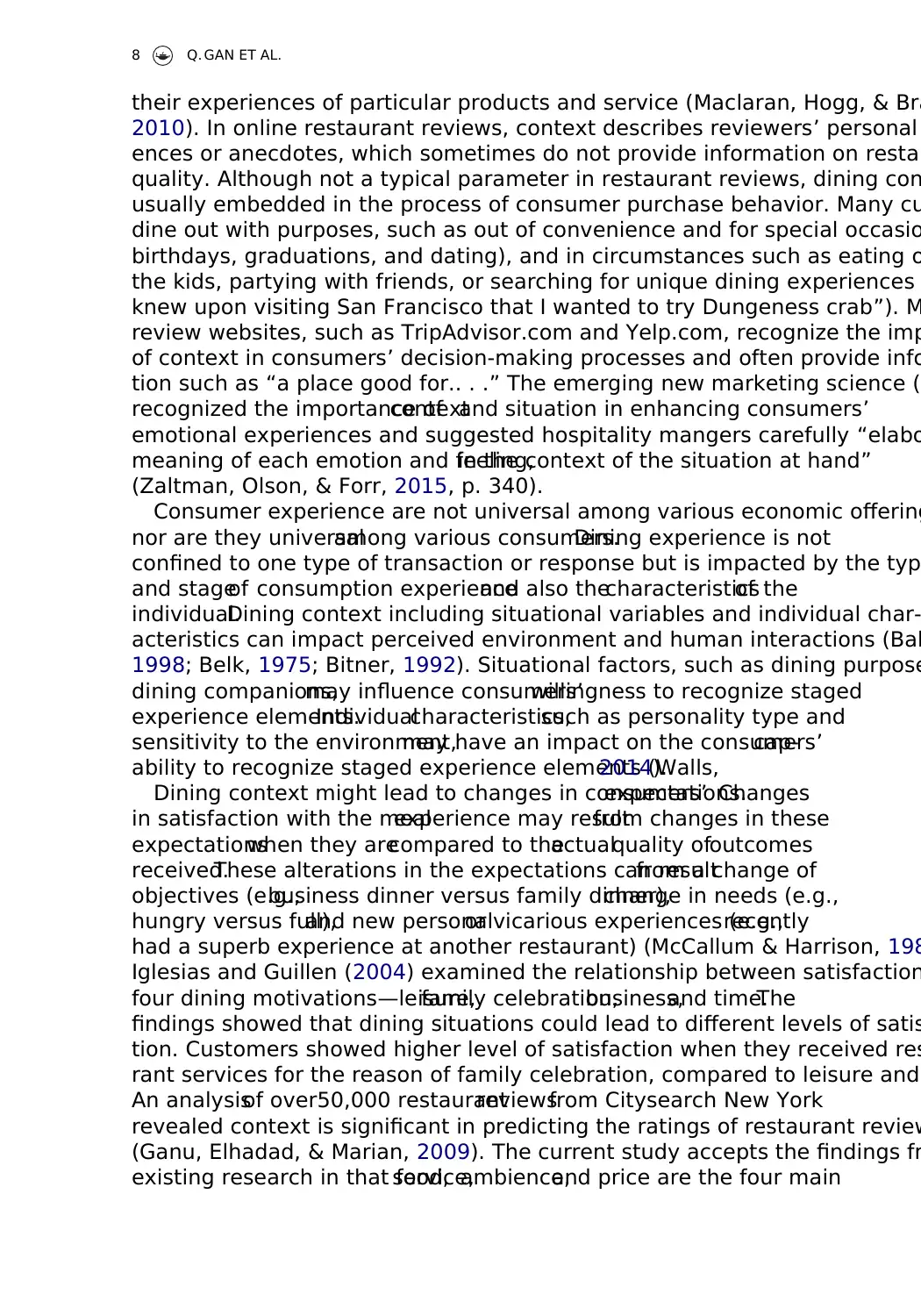
their experiences of particular products and service (Maclaran, Hogg, & Bra
2010). In online restaurant reviews, context describes reviewers’ personal
ences or anecdotes, which sometimes do not provide information on restau
quality. Although not a typical parameter in restaurant reviews, dining con
usually embedded in the process of consumer purchase behavior. Many cu
dine out with purposes, such as out of convenience and for special occasio
birthdays, graduations, and dating), and in circumstances such as eating o
the kids, partying with friends, or searching for unique dining experiences
knew upon visiting San Francisco that I wanted to try Dungeness crab”). M
review websites, such as TripAdvisor.com and Yelp.com, recognize the imp
of context in consumers’ decision-making processes and often provide info
tion such as “a place good for.. . .” The emerging new marketing science (N
recognized the importance ofcontextand situation in enhancing consumers’
emotional experiences and suggested hospitality mangers carefully “elabo
meaning of each emotion and feeling,in the context of the situation at hand”
(Zaltman, Olson, & Forr, 2015, p. 340).
Consumer experience are not universal among various economic offering
nor are they universalamong various consumers.Dining experience is not
confined to one type of transaction or response but is impacted by the typ
and stageof consumption experienceand also thecharacteristicsof the
individual.Dining context including situational variables and individual char-
acteristics can impact perceived environment and human interactions (Bak
1998; Belk, 1975; Bitner, 1992). Situational factors, such as dining purpose
dining companions,may influence consumers’willingness to recognize staged
experience elements.Individualcharacteristics,such as personality type and
sensitivity to the environment,may have an impact on the consumers’cap-
ability to recognize staged experience elements (Walls,2014).
Dining context might lead to changes in consumers’expectations.Changes
in satisfaction with the mealexperience may resultfrom changes in these
expectationswhen they arecompared to theactualquality ofoutcomes
received.These alterations in the expectations can resultfrom a change of
objectives (e.g.,business dinner versus family dinner),change in needs (e.g.,
hungry versus full),and new personalor vicarious experiences (e.g.,recently
had a superb experience at another restaurant) (McCallum & Harrison, 198
Iglesias and Guillen (2004) examined the relationship between satisfaction
four dining motivations—leisure,family celebration,business,and time.The
findings showed that dining situations could lead to different levels of satis
tion. Customers showed higher level of satisfaction when they received res
rant services for the reason of family celebration, compared to leisure and
An analysisof over50,000 restaurantreviewsfrom Citysearch New York
revealed context is significant in predicting the ratings of restaurant review
(Ganu, Elhadad, & Marian, 2009). The current study accepts the findings fr
existing research in that food,service,ambience,and price are the four main
8 Q. GAN ET AL.
2010). In online restaurant reviews, context describes reviewers’ personal
ences or anecdotes, which sometimes do not provide information on restau
quality. Although not a typical parameter in restaurant reviews, dining con
usually embedded in the process of consumer purchase behavior. Many cu
dine out with purposes, such as out of convenience and for special occasio
birthdays, graduations, and dating), and in circumstances such as eating o
the kids, partying with friends, or searching for unique dining experiences
knew upon visiting San Francisco that I wanted to try Dungeness crab”). M
review websites, such as TripAdvisor.com and Yelp.com, recognize the imp
of context in consumers’ decision-making processes and often provide info
tion such as “a place good for.. . .” The emerging new marketing science (N
recognized the importance ofcontextand situation in enhancing consumers’
emotional experiences and suggested hospitality mangers carefully “elabo
meaning of each emotion and feeling,in the context of the situation at hand”
(Zaltman, Olson, & Forr, 2015, p. 340).
Consumer experience are not universal among various economic offering
nor are they universalamong various consumers.Dining experience is not
confined to one type of transaction or response but is impacted by the typ
and stageof consumption experienceand also thecharacteristicsof the
individual.Dining context including situational variables and individual char-
acteristics can impact perceived environment and human interactions (Bak
1998; Belk, 1975; Bitner, 1992). Situational factors, such as dining purpose
dining companions,may influence consumers’willingness to recognize staged
experience elements.Individualcharacteristics,such as personality type and
sensitivity to the environment,may have an impact on the consumers’cap-
ability to recognize staged experience elements (Walls,2014).
Dining context might lead to changes in consumers’expectations.Changes
in satisfaction with the mealexperience may resultfrom changes in these
expectationswhen they arecompared to theactualquality ofoutcomes
received.These alterations in the expectations can resultfrom a change of
objectives (e.g.,business dinner versus family dinner),change in needs (e.g.,
hungry versus full),and new personalor vicarious experiences (e.g.,recently
had a superb experience at another restaurant) (McCallum & Harrison, 198
Iglesias and Guillen (2004) examined the relationship between satisfaction
four dining motivations—leisure,family celebration,business,and time.The
findings showed that dining situations could lead to different levels of satis
tion. Customers showed higher level of satisfaction when they received res
rant services for the reason of family celebration, compared to leisure and
An analysisof over50,000 restaurantreviewsfrom Citysearch New York
revealed context is significant in predicting the ratings of restaurant review
(Ganu, Elhadad, & Marian, 2009). The current study accepts the findings fr
existing research in that food,service,ambience,and price are the four main
8 Q. GAN ET AL.
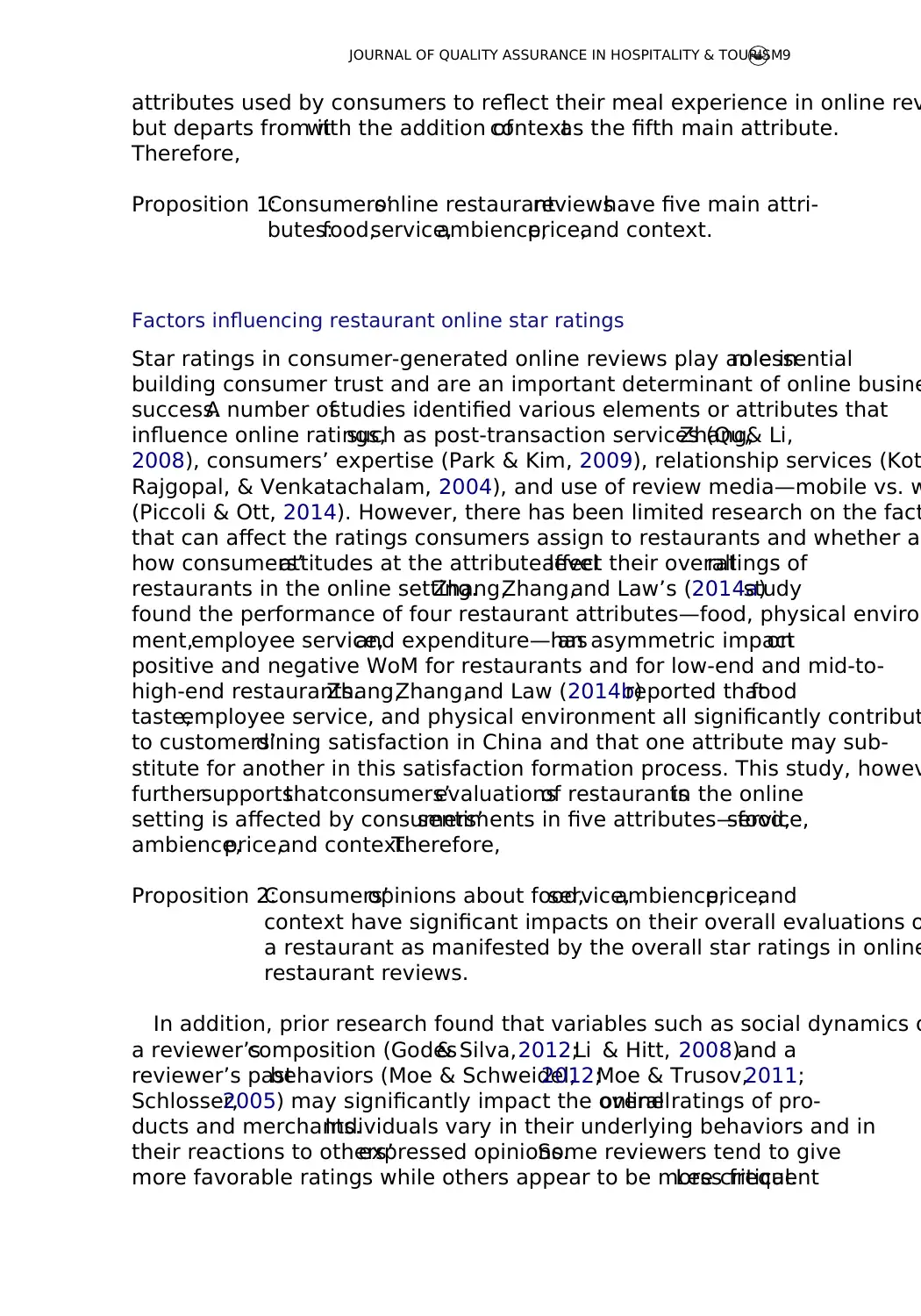
attributes used by consumers to reflect their meal experience in online rev
but departs from itwith the addition ofcontextas the fifth main attribute.
Therefore,
Proposition 1:Consumers’online restaurantreviewshave five main attri-
butes:food,service,ambience,price,and context.
Factors influencing restaurant online star ratings
Star ratings in consumer-generated online reviews play an essentialrole in
building consumer trust and are an important determinant of online busine
success.A number ofstudies identified various elements or attributes that
influence online ratings,such as post-transaction services (Qu,Zhang,& Li,
2008), consumers’ expertise (Park & Kim, 2009), relationship services (Kot
Rajgopal, & Venkatachalam, 2004), and use of review media—mobile vs. w
(Piccoli & Ott, 2014). However, there has been limited research on the fact
that can affect the ratings consumers assign to restaurants and whether an
how consumers’attitudes at the attribute levelaffect their overallratings of
restaurants in the online setting.Zhang,Zhang,and Law’s (2014a)study
found the performance of four restaurant attributes—food, physical environ
ment,employee service,and expenditure—hasan asymmetric impacton
positive and negative WoM for restaurants and for low-end and mid-to-
high-end restaurants.Zhang,Zhang,and Law (2014b)reported thatfood
taste,employee service, and physical environment all significantly contribut
to customers’dining satisfaction in China and that one attribute may sub-
stitute for another in this satisfaction formation process. This study, howev
furthersupportsthatconsumers’evaluationsof restaurantsin the online
setting is affected by consumers’sentiments in five attributes—food,service,
ambience,price,and context.Therefore,
Proposition 2:Consumers’opinions about food,service,ambience,price,and
context have significant impacts on their overall evaluations o
a restaurant as manifested by the overall star ratings in online
restaurant reviews.
In addition, prior research found that variables such as social dynamics o
a reviewer’scomposition (Godes& Silva,2012;Li & Hitt, 2008)and a
reviewer’s pastbehaviors (Moe & Schweidel,2012;Moe & Trusov,2011;
Schlosser,2005) may significantly impact the overallonline ratings of pro-
ducts and merchants.Individuals vary in their underlying behaviors and in
their reactions to others’expressed opinions.Some reviewers tend to give
more favorable ratings while others appear to be more critical.Less frequent
JOURNAL OF QUALITY ASSURANCE IN HOSPITALITY & TOURISM9
but departs from itwith the addition ofcontextas the fifth main attribute.
Therefore,
Proposition 1:Consumers’online restaurantreviewshave five main attri-
butes:food,service,ambience,price,and context.
Factors influencing restaurant online star ratings
Star ratings in consumer-generated online reviews play an essentialrole in
building consumer trust and are an important determinant of online busine
success.A number ofstudies identified various elements or attributes that
influence online ratings,such as post-transaction services (Qu,Zhang,& Li,
2008), consumers’ expertise (Park & Kim, 2009), relationship services (Kot
Rajgopal, & Venkatachalam, 2004), and use of review media—mobile vs. w
(Piccoli & Ott, 2014). However, there has been limited research on the fact
that can affect the ratings consumers assign to restaurants and whether an
how consumers’attitudes at the attribute levelaffect their overallratings of
restaurants in the online setting.Zhang,Zhang,and Law’s (2014a)study
found the performance of four restaurant attributes—food, physical environ
ment,employee service,and expenditure—hasan asymmetric impacton
positive and negative WoM for restaurants and for low-end and mid-to-
high-end restaurants.Zhang,Zhang,and Law (2014b)reported thatfood
taste,employee service, and physical environment all significantly contribut
to customers’dining satisfaction in China and that one attribute may sub-
stitute for another in this satisfaction formation process. This study, howev
furthersupportsthatconsumers’evaluationsof restaurantsin the online
setting is affected by consumers’sentiments in five attributes—food,service,
ambience,price,and context.Therefore,
Proposition 2:Consumers’opinions about food,service,ambience,price,and
context have significant impacts on their overall evaluations o
a restaurant as manifested by the overall star ratings in online
restaurant reviews.
In addition, prior research found that variables such as social dynamics o
a reviewer’scomposition (Godes& Silva,2012;Li & Hitt, 2008)and a
reviewer’s pastbehaviors (Moe & Schweidel,2012;Moe & Trusov,2011;
Schlosser,2005) may significantly impact the overallonline ratings of pro-
ducts and merchants.Individuals vary in their underlying behaviors and in
their reactions to others’expressed opinions.Some reviewers tend to give
more favorable ratings while others appear to be more critical.Less frequent
JOURNAL OF QUALITY ASSURANCE IN HOSPITALITY & TOURISM9
Secure Best Marks with AI Grader
Need help grading? Try our AI Grader for instant feedback on your assignments.
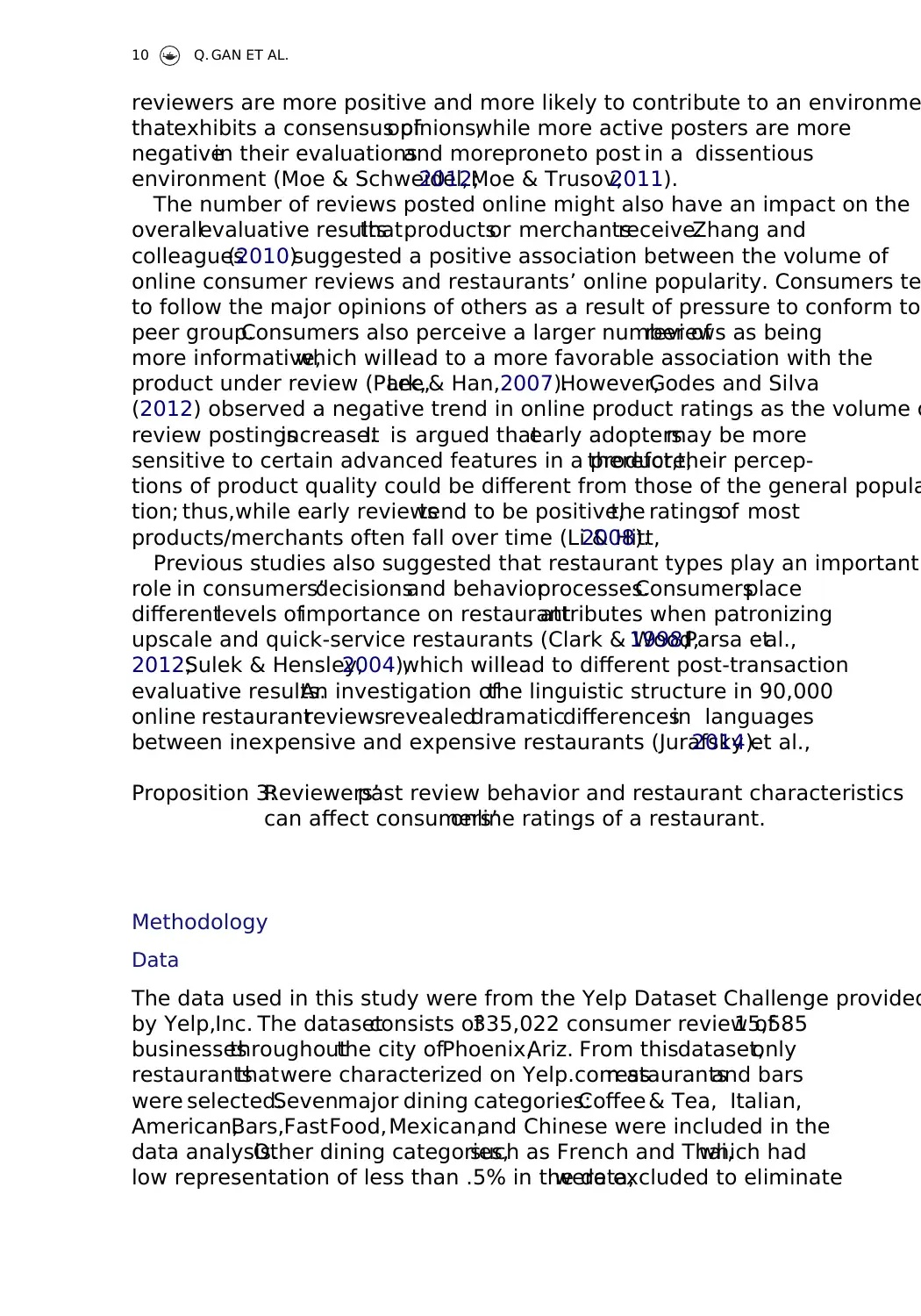
reviewers are more positive and more likely to contribute to an environme
thatexhibits a consensus ofopinions,while more active posters are more
negativein their evaluationsand moreproneto post in a dissentious
environment (Moe & Schweidel,2012;Moe & Trusov,2011).
The number of reviews posted online might also have an impact on the
overallevaluative resultsthatproductsor merchantsreceive.Zhang and
colleagues(2010)suggested a positive association between the volume of
online consumer reviews and restaurants’ online popularity. Consumers te
to follow the major opinions of others as a result of pressure to conform to
peer group.Consumers also perceive a larger number ofreviews as being
more informative,which willlead to a more favorable association with the
product under review (Park,Lee,& Han,2007).However,Godes and Silva
(2012) observed a negative trend in online product ratings as the volume o
review postingsincrease.It is argued thatearly adoptersmay be more
sensitive to certain advanced features in a product,therefore,their percep-
tions of product quality could be different from those of the general popula
tion; thus,while early reviewstend to be positive,the ratingsof most
products/merchants often fall over time (Li & Hitt,2008).
Previous studies also suggested that restaurant types play an important
role in consumers’decisionsand behaviorprocesses.Consumersplace
differentlevels ofimportance on restaurantattributes when patronizing
upscale and quick-service restaurants (Clark & Wood,1998;Parsa etal.,
2012;Sulek & Hensley,2004),which willlead to different post-transaction
evaluative results.An investigation ofthe linguistic structure in 90,000
online restaurantreviewsrevealeddramaticdifferencesin languages
between inexpensive and expensive restaurants (Jurafsky et al.,2014).
Proposition 3:Reviewers’past review behavior and restaurant characteristics
can affect consumers’online ratings of a restaurant.
Methodology
Data
The data used in this study were from the Yelp Dataset Challenge provided
by Yelp,Inc. The datasetconsists of335,022 consumer review of15,585
businessesthroughoutthe city ofPhoenix,Ariz. From thisdataset,only
restaurantsthatwere characterized on Yelp.com asrestaurantsand bars
were selected.Sevenmajor dining categories:Coffee & Tea, Italian,
American,Bars,FastFood,Mexican,and Chinese were included in the
data analysis.Other dining categories,such as French and Thai,which had
low representation of less than .5% in the data,were excluded to eliminate
10 Q. GAN ET AL.
thatexhibits a consensus ofopinions,while more active posters are more
negativein their evaluationsand moreproneto post in a dissentious
environment (Moe & Schweidel,2012;Moe & Trusov,2011).
The number of reviews posted online might also have an impact on the
overallevaluative resultsthatproductsor merchantsreceive.Zhang and
colleagues(2010)suggested a positive association between the volume of
online consumer reviews and restaurants’ online popularity. Consumers te
to follow the major opinions of others as a result of pressure to conform to
peer group.Consumers also perceive a larger number ofreviews as being
more informative,which willlead to a more favorable association with the
product under review (Park,Lee,& Han,2007).However,Godes and Silva
(2012) observed a negative trend in online product ratings as the volume o
review postingsincrease.It is argued thatearly adoptersmay be more
sensitive to certain advanced features in a product,therefore,their percep-
tions of product quality could be different from those of the general popula
tion; thus,while early reviewstend to be positive,the ratingsof most
products/merchants often fall over time (Li & Hitt,2008).
Previous studies also suggested that restaurant types play an important
role in consumers’decisionsand behaviorprocesses.Consumersplace
differentlevels ofimportance on restaurantattributes when patronizing
upscale and quick-service restaurants (Clark & Wood,1998;Parsa etal.,
2012;Sulek & Hensley,2004),which willlead to different post-transaction
evaluative results.An investigation ofthe linguistic structure in 90,000
online restaurantreviewsrevealeddramaticdifferencesin languages
between inexpensive and expensive restaurants (Jurafsky et al.,2014).
Proposition 3:Reviewers’past review behavior and restaurant characteristics
can affect consumers’online ratings of a restaurant.
Methodology
Data
The data used in this study were from the Yelp Dataset Challenge provided
by Yelp,Inc. The datasetconsists of335,022 consumer review of15,585
businessesthroughoutthe city ofPhoenix,Ariz. From thisdataset,only
restaurantsthatwere characterized on Yelp.com asrestaurantsand bars
were selected.Sevenmajor dining categories:Coffee & Tea, Italian,
American,Bars,FastFood,Mexican,and Chinese were included in the
data analysis.Other dining categories,such as French and Thai,which had
low representation of less than .5% in the data,were excluded to eliminate
10 Q. GAN ET AL.
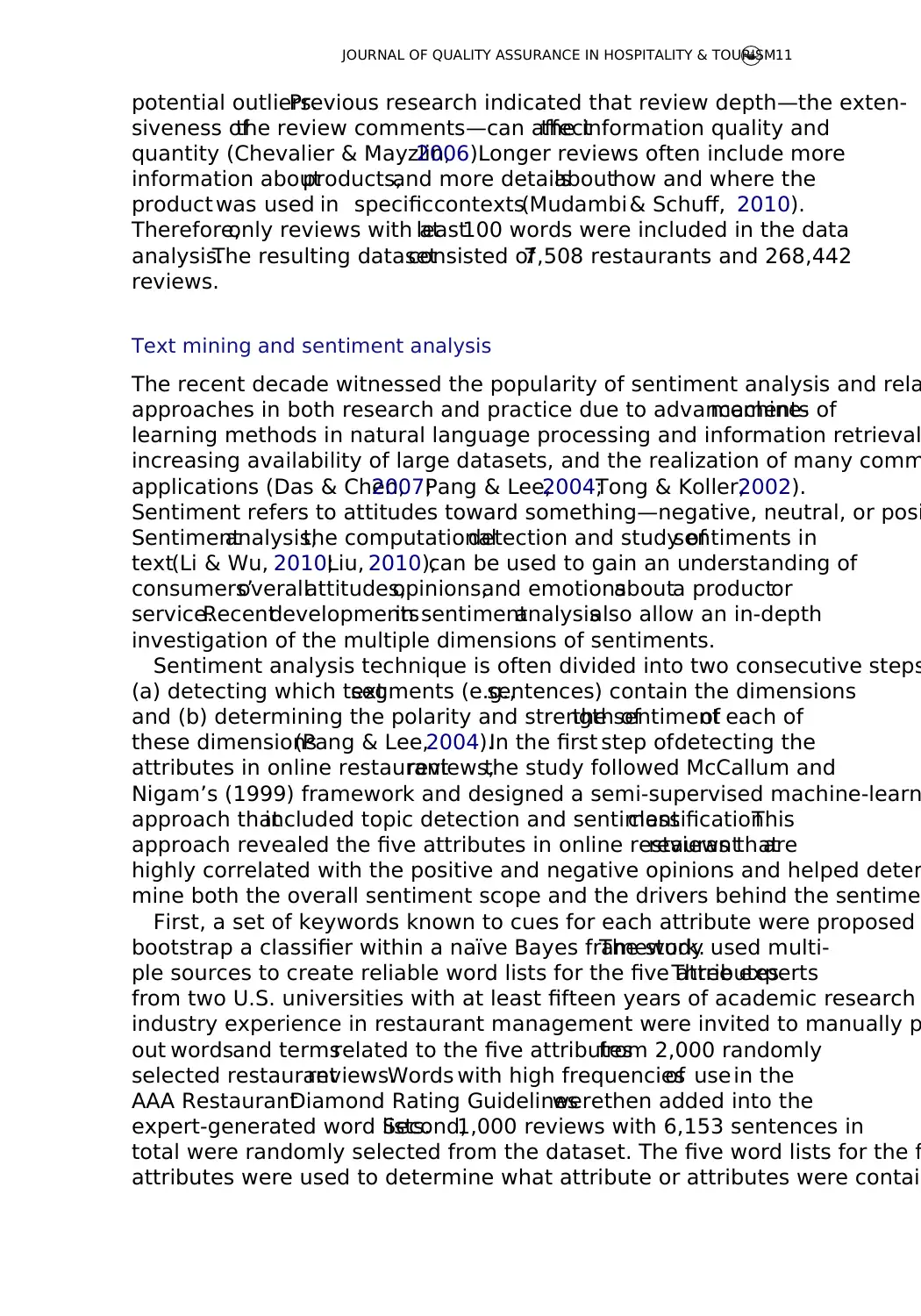
potential outliers.Previous research indicated that review depth—the exten-
siveness ofthe review comments—can affectthe information quality and
quantity (Chevalier & Mayzlin,2006).Longer reviews often include more
information aboutproducts,and more detailsabouthow and where the
product was used in specificcontexts(Mudambi & Schuff, 2010).
Therefore,only reviews with atleast100 words were included in the data
analysis.The resulting datasetconsisted of7,508 restaurants and 268,442
reviews.
Text mining and sentiment analysis
The recent decade witnessed the popularity of sentiment analysis and rela
approaches in both research and practice due to advancements ofmachine-
learning methods in natural language processing and information retrieval
increasing availability of large datasets, and the realization of many comm
applications (Das & Chen,2007;Pang & Lee,2004;Tong & Koller,2002).
Sentiment refers to attitudes toward something—negative, neutral, or posi
Sentimentanalysis,the computationaldetection and study ofsentiments in
text(Li & Wu, 2010;Liu, 2010),can be used to gain an understanding of
consumers’overallattitudes,opinions,and emotionsabouta productor
service.Recentdevelopmentsin sentimentanalysisalso allow an in-depth
investigation of the multiple dimensions of sentiments.
Sentiment analysis technique is often divided into two consecutive steps
(a) detecting which textsegments (e.g.,sentences) contain the dimensions
and (b) determining the polarity and strength ofthe sentimentof each of
these dimensions(Pang & Lee,2004).In the first step ofdetecting the
attributes in online restaurantreviews,the study followed McCallum and
Nigam’s (1999) framework and designed a semi-supervised machine-learn
approach thatincluded topic detection and sentimentclassification.This
approach revealed the five attributes in online restaurantreviews thatare
highly correlated with the positive and negative opinions and helped deter
mine both the overall sentiment scope and the drivers behind the sentimen
First, a set of keywords known to cues for each attribute were proposed
bootstrap a classifier within a naïve Bayes framework.The study used multi-
ple sources to create reliable word lists for the five attributes.Three experts
from two U.S. universities with at least fifteen years of academic research
industry experience in restaurant management were invited to manually p
out wordsand termsrelated to the five attributesfrom 2,000 randomly
selected restaurantreviews.Words with high frequenciesof use in the
AAA RestaurantDiamond Rating Guidelineswerethen added into the
expert-generated word lists.Second,1,000 reviews with 6,153 sentences in
total were randomly selected from the dataset. The five word lists for the fi
attributes were used to determine what attribute or attributes were contain
JOURNAL OF QUALITY ASSURANCE IN HOSPITALITY & TOURISM11
siveness ofthe review comments—can affectthe information quality and
quantity (Chevalier & Mayzlin,2006).Longer reviews often include more
information aboutproducts,and more detailsabouthow and where the
product was used in specificcontexts(Mudambi & Schuff, 2010).
Therefore,only reviews with atleast100 words were included in the data
analysis.The resulting datasetconsisted of7,508 restaurants and 268,442
reviews.
Text mining and sentiment analysis
The recent decade witnessed the popularity of sentiment analysis and rela
approaches in both research and practice due to advancements ofmachine-
learning methods in natural language processing and information retrieval
increasing availability of large datasets, and the realization of many comm
applications (Das & Chen,2007;Pang & Lee,2004;Tong & Koller,2002).
Sentiment refers to attitudes toward something—negative, neutral, or posi
Sentimentanalysis,the computationaldetection and study ofsentiments in
text(Li & Wu, 2010;Liu, 2010),can be used to gain an understanding of
consumers’overallattitudes,opinions,and emotionsabouta productor
service.Recentdevelopmentsin sentimentanalysisalso allow an in-depth
investigation of the multiple dimensions of sentiments.
Sentiment analysis technique is often divided into two consecutive steps
(a) detecting which textsegments (e.g.,sentences) contain the dimensions
and (b) determining the polarity and strength ofthe sentimentof each of
these dimensions(Pang & Lee,2004).In the first step ofdetecting the
attributes in online restaurantreviews,the study followed McCallum and
Nigam’s (1999) framework and designed a semi-supervised machine-learn
approach thatincluded topic detection and sentimentclassification.This
approach revealed the five attributes in online restaurantreviews thatare
highly correlated with the positive and negative opinions and helped deter
mine both the overall sentiment scope and the drivers behind the sentimen
First, a set of keywords known to cues for each attribute were proposed
bootstrap a classifier within a naïve Bayes framework.The study used multi-
ple sources to create reliable word lists for the five attributes.Three experts
from two U.S. universities with at least fifteen years of academic research
industry experience in restaurant management were invited to manually p
out wordsand termsrelated to the five attributesfrom 2,000 randomly
selected restaurantreviews.Words with high frequenciesof use in the
AAA RestaurantDiamond Rating Guidelineswerethen added into the
expert-generated word lists.Second,1,000 reviews with 6,153 sentences in
total were randomly selected from the dataset. The five word lists for the fi
attributes were used to determine what attribute or attributes were contain
JOURNAL OF QUALITY ASSURANCE IN HOSPITALITY & TOURISM11
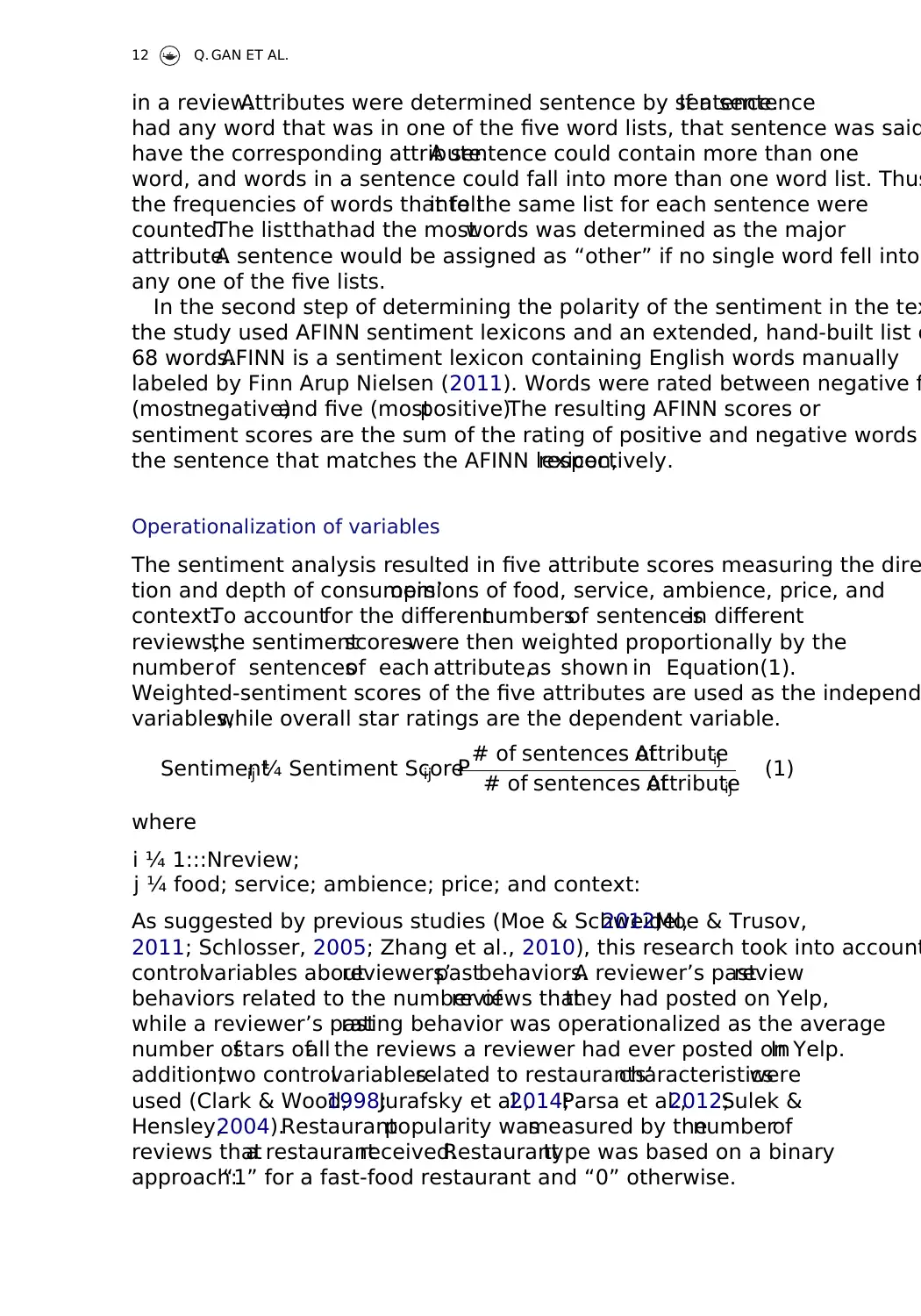
in a review.Attributes were determined sentence by sentence.If a sentence
had any word that was in one of the five word lists, that sentence was said
have the corresponding attribute.A sentence could contain more than one
word, and words in a sentence could fall into more than one word list. Thus
the frequencies of words that fellinto the same list for each sentence were
counted.The listthathad the mostwords was determined as the major
attribute.A sentence would be assigned as “other” if no single word fell into
any one of the five lists.
In the second step of determining the polarity of the sentiment in the tex
the study used AFINN sentiment lexicons and an extended, hand-built list o
68 words.AFINN is a sentiment lexicon containing English words manually
labeled by Finn Arup Nielsen (2011). Words were rated between negative fi
(mostnegative)and five (mostpositive).The resulting AFINN scores or
sentiment scores are the sum of the rating of positive and negative words
the sentence that matches the AFINN lexicon,respectively.
Operationalization of variables
The sentiment analysis resulted in five attribute scores measuring the dire
tion and depth of consumers’opinions of food, service, ambience, price, and
context.To accountfor the differentnumbersof sentencesin different
reviews,the sentimentscoreswere then weighted proportionally by the
numberof sentencesof each attribute,as shown in Equation(1).
Weighted-sentiment scores of the five attributes are used as the independ
variables,while overall star ratings are the dependent variable.
Sentimentij ¼ Sentiment Scoreij
# of sentences ofAttributeij
P # of sentences ofAttributeij
(1)
where
i ¼ 1:::Nreview;
j ¼ food; service; ambience; price; and context:
As suggested by previous studies (Moe & Schweidel,2012;Moe & Trusov,
2011; Schlosser, 2005; Zhang et al., 2010), this research took into account
controlvariables aboutreviewers’pastbehaviors.A reviewer’s pastreview
behaviors related to the number ofreviews thatthey had posted on Yelp,
while a reviewer’s pastrating behavior was operationalized as the average
number ofstars ofall the reviews a reviewer had ever posted on Yelp.In
addition,two controlvariablesrelated to restaurants’characteristicswere
used (Clark & Wood,1998;Jurafsky et al.,2014;Parsa et al.,2012;Sulek &
Hensley,2004).Restaurantpopularity wasmeasured by thenumberof
reviews thata restaurantreceived.Restauranttype was based on a binary
approach:“1” for a fast-food restaurant and “0” otherwise.
12 Q. GAN ET AL.
had any word that was in one of the five word lists, that sentence was said
have the corresponding attribute.A sentence could contain more than one
word, and words in a sentence could fall into more than one word list. Thus
the frequencies of words that fellinto the same list for each sentence were
counted.The listthathad the mostwords was determined as the major
attribute.A sentence would be assigned as “other” if no single word fell into
any one of the five lists.
In the second step of determining the polarity of the sentiment in the tex
the study used AFINN sentiment lexicons and an extended, hand-built list o
68 words.AFINN is a sentiment lexicon containing English words manually
labeled by Finn Arup Nielsen (2011). Words were rated between negative fi
(mostnegative)and five (mostpositive).The resulting AFINN scores or
sentiment scores are the sum of the rating of positive and negative words
the sentence that matches the AFINN lexicon,respectively.
Operationalization of variables
The sentiment analysis resulted in five attribute scores measuring the dire
tion and depth of consumers’opinions of food, service, ambience, price, and
context.To accountfor the differentnumbersof sentencesin different
reviews,the sentimentscoreswere then weighted proportionally by the
numberof sentencesof each attribute,as shown in Equation(1).
Weighted-sentiment scores of the five attributes are used as the independ
variables,while overall star ratings are the dependent variable.
Sentimentij ¼ Sentiment Scoreij
# of sentences ofAttributeij
P # of sentences ofAttributeij
(1)
where
i ¼ 1:::Nreview;
j ¼ food; service; ambience; price; and context:
As suggested by previous studies (Moe & Schweidel,2012;Moe & Trusov,
2011; Schlosser, 2005; Zhang et al., 2010), this research took into account
controlvariables aboutreviewers’pastbehaviors.A reviewer’s pastreview
behaviors related to the number ofreviews thatthey had posted on Yelp,
while a reviewer’s pastrating behavior was operationalized as the average
number ofstars ofall the reviews a reviewer had ever posted on Yelp.In
addition,two controlvariablesrelated to restaurants’characteristicswere
used (Clark & Wood,1998;Jurafsky et al.,2014;Parsa et al.,2012;Sulek &
Hensley,2004).Restaurantpopularity wasmeasured by thenumberof
reviews thata restaurantreceived.Restauranttype was based on a binary
approach:“1” for a fast-food restaurant and “0” otherwise.
12 Q. GAN ET AL.
Paraphrase This Document
Need a fresh take? Get an instant paraphrase of this document with our AI Paraphraser
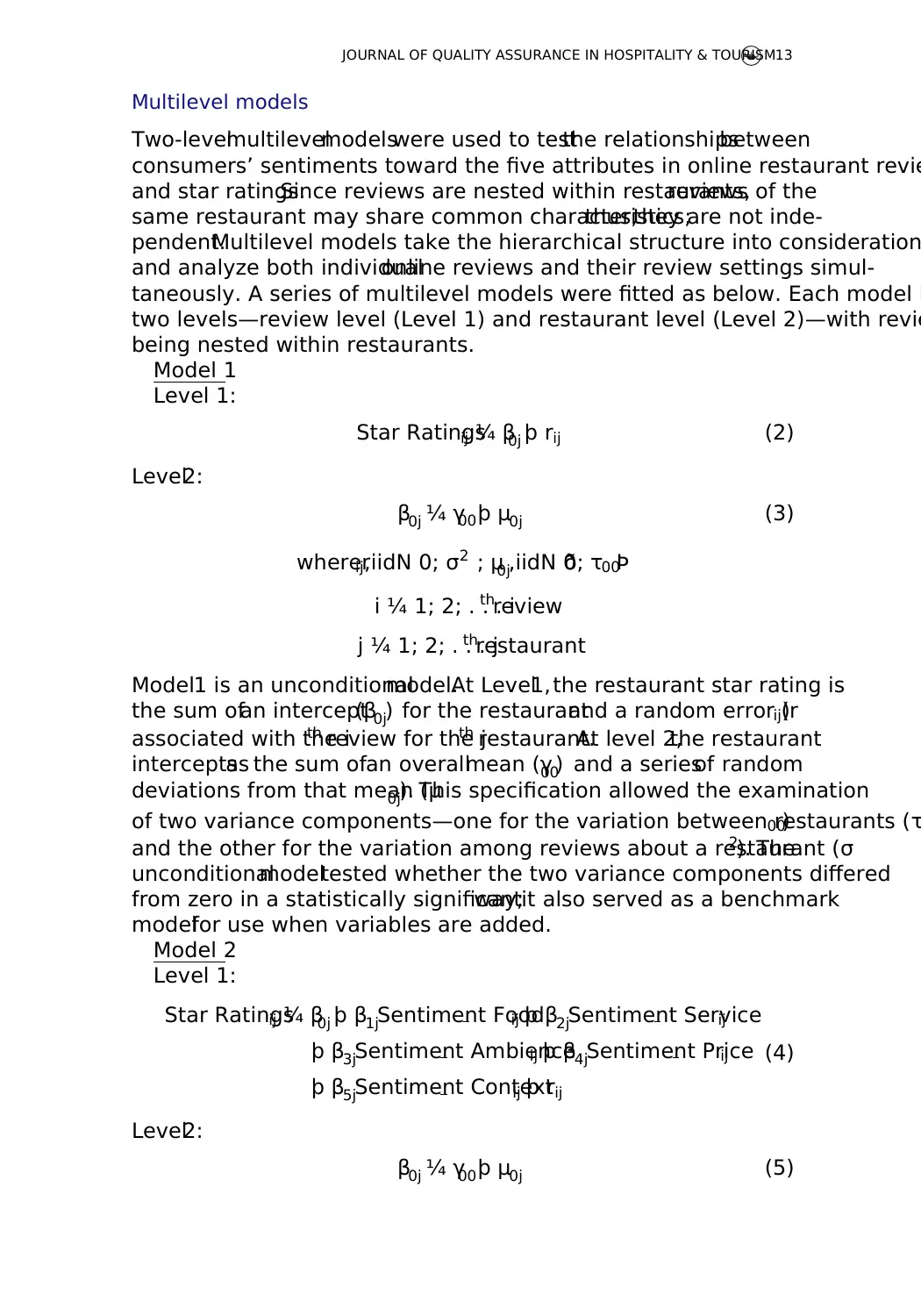
Multilevel models
Two-levelmultilevelmodelswere used to testthe relationshipsbetween
consumers’ sentiments toward the five attributes in online restaurant revie
and star ratings.Since reviews are nested within restaurants,reviews of the
same restaurant may share common characteristics;thus,they are not inde-
pendent.Multilevel models take the hierarchical structure into consideration
and analyze both individualonline reviews and their review settings simul-
taneously. A series of multilevel models were fitted as below. Each model h
two levels—review level (Level 1) and restaurant level (Level 2)—with revie
being nested within restaurants.
Model 1
Level 1:
Star Ratingsij ¼ β0j þ rij (2)
Level2:
β0j ¼ γ00þ μ0j (3)
whererij,iidN 0; σ2 ; μ0j,iidN 0; τ00ð Þ
i ¼ 1; 2; . . . ithreview
j ¼ 1; 2; . . . jthrestaurant
Model1 is an unconditionalmodel.At Level1,the restaurant star rating is
the sum ofan intercept(β0j) for the restaurantand a random error (rij)
associated with the ith review for the jth restaurant.At level 2,the restaurant
interceptsas the sum ofan overallmean (γ00) and a seriesof random
deviations from that mean (μ0j). This specification allowed the examination
of two variance components—one for the variation between restaurants (τ00)
and the other for the variation among reviews about a restaurant (σ2). The
unconditionalmodeltested whether the two variance components differed
from zero in a statistically significantway;it also served as a benchmark
modelfor use when variables are added.
Model 2
Level 1:
Star Ratingsij ¼ β0j þ β1jSentiment Foodij þ β2jSentiment Serviceij
þ β3jSentiment Ambienceij þ β4jSentiment Priceij
þ β5jSentiment Contextij þ rij
(4)
Level2:
β0j ¼ γ00þ μ0j (5)
JOURNAL OF QUALITY ASSURANCE IN HOSPITALITY & TOURISM13
Two-levelmultilevelmodelswere used to testthe relationshipsbetween
consumers’ sentiments toward the five attributes in online restaurant revie
and star ratings.Since reviews are nested within restaurants,reviews of the
same restaurant may share common characteristics;thus,they are not inde-
pendent.Multilevel models take the hierarchical structure into consideration
and analyze both individualonline reviews and their review settings simul-
taneously. A series of multilevel models were fitted as below. Each model h
two levels—review level (Level 1) and restaurant level (Level 2)—with revie
being nested within restaurants.
Model 1
Level 1:
Star Ratingsij ¼ β0j þ rij (2)
Level2:
β0j ¼ γ00þ μ0j (3)
whererij,iidN 0; σ2 ; μ0j,iidN 0; τ00ð Þ
i ¼ 1; 2; . . . ithreview
j ¼ 1; 2; . . . jthrestaurant
Model1 is an unconditionalmodel.At Level1,the restaurant star rating is
the sum ofan intercept(β0j) for the restaurantand a random error (rij)
associated with the ith review for the jth restaurant.At level 2,the restaurant
interceptsas the sum ofan overallmean (γ00) and a seriesof random
deviations from that mean (μ0j). This specification allowed the examination
of two variance components—one for the variation between restaurants (τ00)
and the other for the variation among reviews about a restaurant (σ2). The
unconditionalmodeltested whether the two variance components differed
from zero in a statistically significantway;it also served as a benchmark
modelfor use when variables are added.
Model 2
Level 1:
Star Ratingsij ¼ β0j þ β1jSentiment Foodij þ β2jSentiment Serviceij
þ β3jSentiment Ambienceij þ β4jSentiment Priceij
þ β5jSentiment Contextij þ rij
(4)
Level2:
β0j ¼ γ00þ μ0j (5)
JOURNAL OF QUALITY ASSURANCE IN HOSPITALITY & TOURISM13
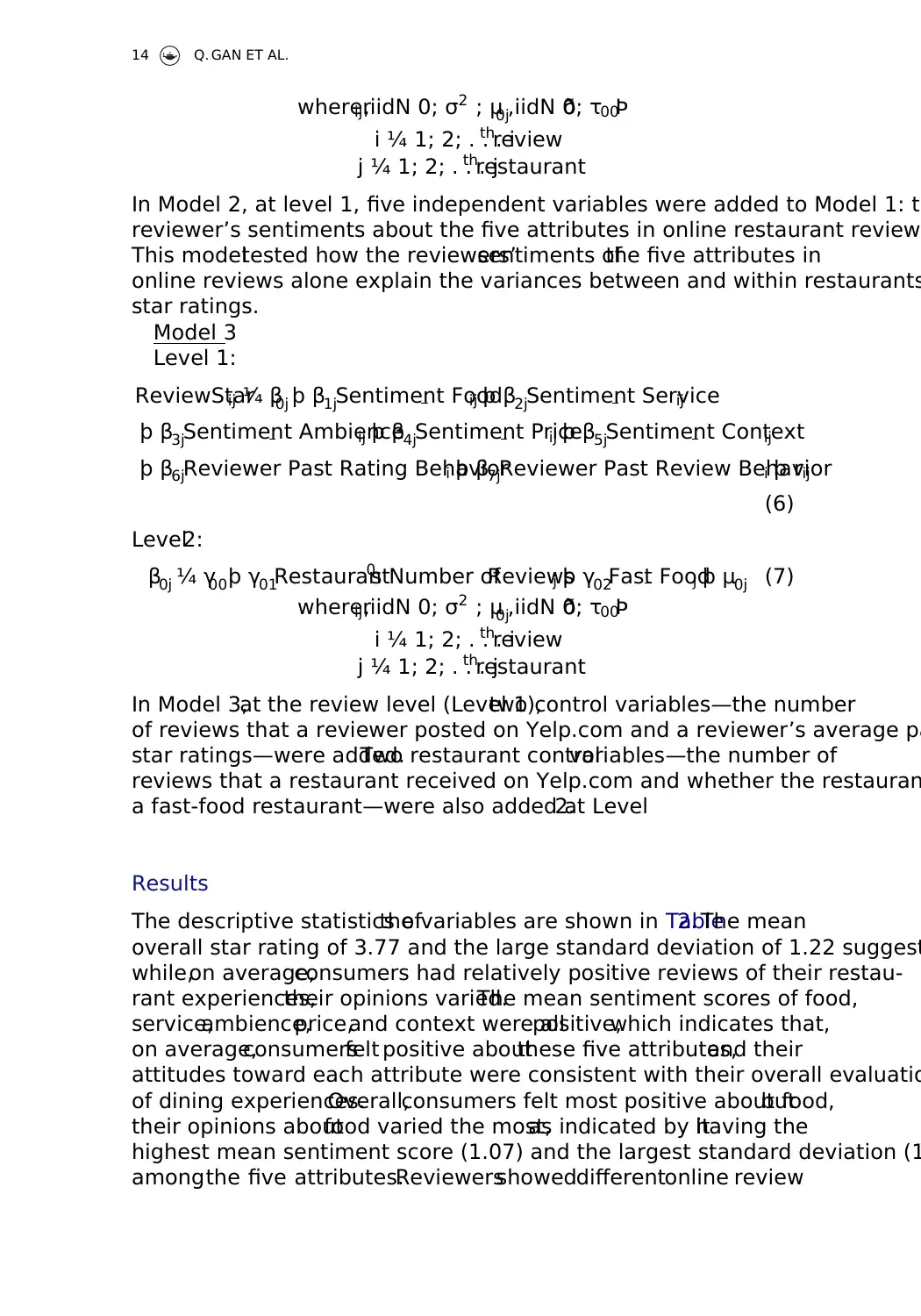
whererij,iidN 0; σ2 ; μ0j,iidN 0; τ00ð Þ
i ¼ 1; 2; . . . ithreview
j ¼ 1; 2; . . . jthrestaurant
In Model 2, at level 1, five independent variables were added to Model 1: th
reviewer’s sentiments about the five attributes in online restaurant reviews
This modeltested how the reviewers’sentiments ofthe five attributes in
online reviews alone explain the variances between and within restaurants
star ratings.
Model 3
Level 1:
ReviewStarij ¼ β0j þ β1jSentiment Foodij þ β2jSentiment Serviceij
þ β3jSentiment Ambienceij þ β4jSentiment Priceij þ β5jSentiment Contextij
þ β6jReviewer Past Rating Behaviori þ β7jReviewer Past Review Behaviori þ rij
(6)
Level2:
β0j ¼ γ00þ γ01Restaurant0
s Number ofReviewsj þ γ02Fast Foodj þ μ0j (7)
whererij,iidN 0; σ2 ; μ0j,iidN 0; τ00ð Þ
i ¼ 1; 2; . . . ithreview
j ¼ 1; 2; . . . jthrestaurant
In Model 3,at the review level (Level 1),two control variables—the number
of reviews that a reviewer posted on Yelp.com and a reviewer’s average pa
star ratings—were added.Two restaurant controlvariables—the number of
reviews that a restaurant received on Yelp.com and whether the restauran
a fast-food restaurant—were also added at Level2.
Results
The descriptive statistics ofthe variables are shown in Table2. The mean
overall star rating of 3.77 and the large standard deviation of 1.22 suggest
while,on average,consumers had relatively positive reviews of their restau-
rant experiences,their opinions varied.The mean sentiment scores of food,
service,ambience,price,and context were allpositive,which indicates that,
on average,consumersfelt positive aboutthese five attributes,and their
attitudes toward each attribute were consistent with their overall evaluatio
of dining experiences.Overall,consumers felt most positive about food,but
their opinions aboutfood varied the most,as indicated by ithaving the
highest mean sentiment score (1.07) and the largest standard deviation (1
amongthe five attributes.Reviewersshoweddifferentonline review
14 Q. GAN ET AL.
i ¼ 1; 2; . . . ithreview
j ¼ 1; 2; . . . jthrestaurant
In Model 2, at level 1, five independent variables were added to Model 1: th
reviewer’s sentiments about the five attributes in online restaurant reviews
This modeltested how the reviewers’sentiments ofthe five attributes in
online reviews alone explain the variances between and within restaurants
star ratings.
Model 3
Level 1:
ReviewStarij ¼ β0j þ β1jSentiment Foodij þ β2jSentiment Serviceij
þ β3jSentiment Ambienceij þ β4jSentiment Priceij þ β5jSentiment Contextij
þ β6jReviewer Past Rating Behaviori þ β7jReviewer Past Review Behaviori þ rij
(6)
Level2:
β0j ¼ γ00þ γ01Restaurant0
s Number ofReviewsj þ γ02Fast Foodj þ μ0j (7)
whererij,iidN 0; σ2 ; μ0j,iidN 0; τ00ð Þ
i ¼ 1; 2; . . . ithreview
j ¼ 1; 2; . . . jthrestaurant
In Model 3,at the review level (Level 1),two control variables—the number
of reviews that a reviewer posted on Yelp.com and a reviewer’s average pa
star ratings—were added.Two restaurant controlvariables—the number of
reviews that a restaurant received on Yelp.com and whether the restauran
a fast-food restaurant—were also added at Level2.
Results
The descriptive statistics ofthe variables are shown in Table2. The mean
overall star rating of 3.77 and the large standard deviation of 1.22 suggest
while,on average,consumers had relatively positive reviews of their restau-
rant experiences,their opinions varied.The mean sentiment scores of food,
service,ambience,price,and context were allpositive,which indicates that,
on average,consumersfelt positive aboutthese five attributes,and their
attitudes toward each attribute were consistent with their overall evaluatio
of dining experiences.Overall,consumers felt most positive about food,but
their opinions aboutfood varied the most,as indicated by ithaving the
highest mean sentiment score (1.07) and the largest standard deviation (1
amongthe five attributes.Reviewersshoweddifferentonline review
14 Q. GAN ET AL.
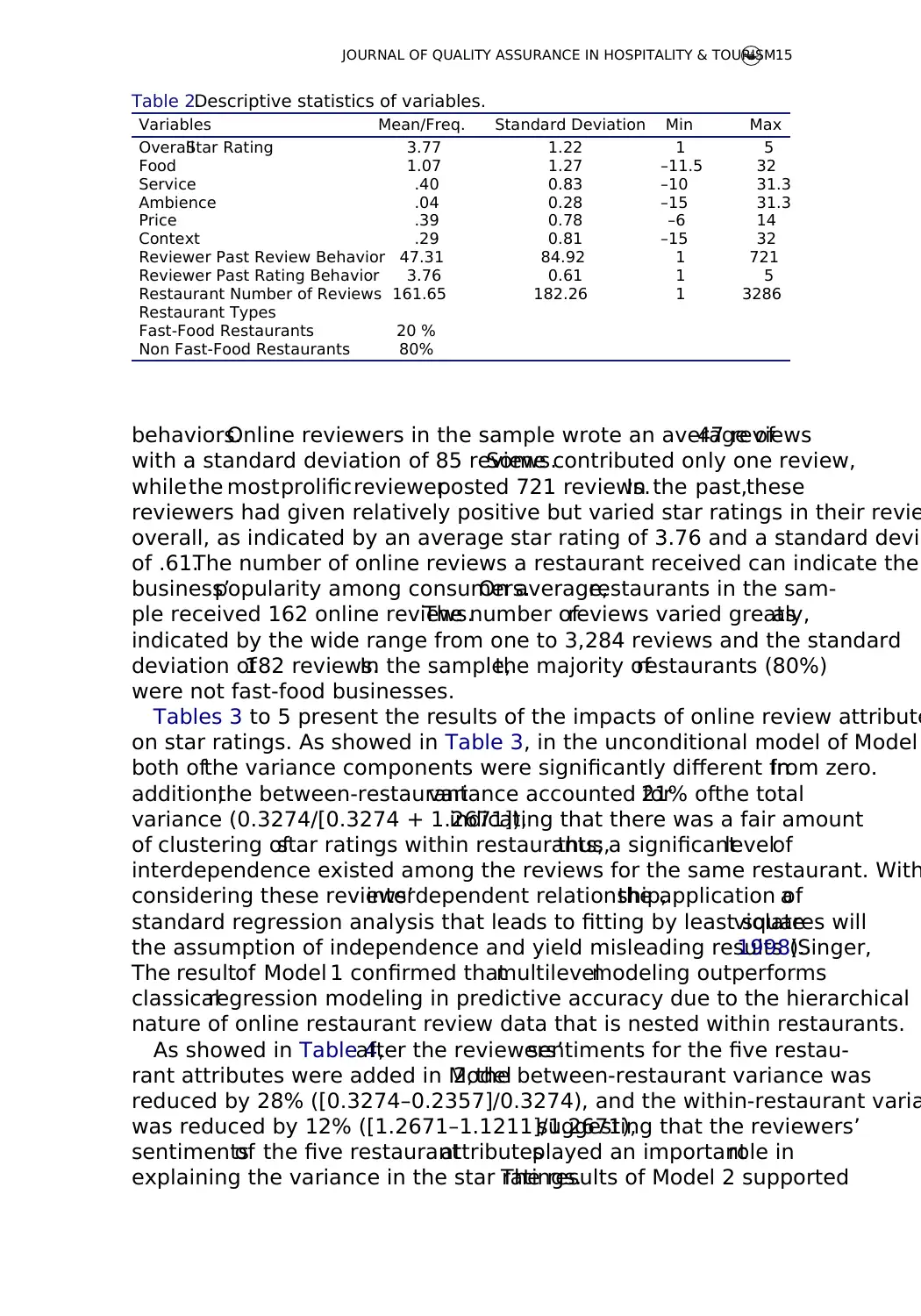
behaviors.Online reviewers in the sample wrote an average of47 reviews
with a standard deviation of 85 reviews.Some contributed only one review,
whilethe mostprolificreviewerposted 721 reviews.In the past,these
reviewers had given relatively positive but varied star ratings in their revie
overall, as indicated by an average star rating of 3.76 and a standard devia
of .61.The number of online reviews a restaurant received can indicate the
business’popularity among consumers.On average,restaurants in the sam-
ple received 162 online reviews.The number ofreviews varied greatly,as
indicated by the wide range from one to 3,284 reviews and the standard
deviation of182 reviews.In the sample,the majority ofrestaurants (80%)
were not fast-food businesses.
Tables 3 to 5 present the results of the impacts of online review attribute
on star ratings. As showed in Table 3, in the unconditional model of Model
both ofthe variance components were significantly different from zero.In
addition,the between-restaurantvariance accounted for21% ofthe total
variance (0.3274/[0.3274 + 1.2671]),indicating that there was a fair amount
of clustering ofstar ratings within restaurants;thus,a significantlevelof
interdependence existed among the reviews for the same restaurant. With
considering these reviews’interdependent relationship,the application ofa
standard regression analysis that leads to fitting by least squares willviolate
the assumption of independence and yield misleading results (Singer,1998).
The resultof Model 1 confirmed thatmultilevelmodeling outperforms
classicalregression modeling in predictive accuracy due to the hierarchical
nature of online restaurant review data that is nested within restaurants.
As showed in Table 4,after the reviewers’sentiments for the five restau-
rant attributes were added in Model2, the between-restaurant variance was
reduced by 28% ([0.3274–0.2357]/0.3274), and the within-restaurant varia
was reduced by 12% ([1.2671–1.1211]/1.2671),suggesting that the reviewers’
sentimentsof the five restaurantattributesplayed an importantrole in
explaining the variance in the star ratings.The results of Model 2 supported
Table 2.Descriptive statistics of variables.
Variables Mean/Freq. Standard Deviation Min Max
OverallStar Rating 3.77 1.22 1 5
Food 1.07 1.27 –11.5 32
Service .40 0.83 –10 31.3
Ambience .04 0.28 –15 31.3
Price .39 0.78 –6 14
Context .29 0.81 –15 32
Reviewer Past Review Behavior 47.31 84.92 1 721
Reviewer Past Rating Behavior 3.76 0.61 1 5
Restaurant Number of Reviews 161.65 182.26 1 3286
Restaurant Types
Fast-Food Restaurants 20 %
Non Fast-Food Restaurants 80%
JOURNAL OF QUALITY ASSURANCE IN HOSPITALITY & TOURISM15
with a standard deviation of 85 reviews.Some contributed only one review,
whilethe mostprolificreviewerposted 721 reviews.In the past,these
reviewers had given relatively positive but varied star ratings in their revie
overall, as indicated by an average star rating of 3.76 and a standard devia
of .61.The number of online reviews a restaurant received can indicate the
business’popularity among consumers.On average,restaurants in the sam-
ple received 162 online reviews.The number ofreviews varied greatly,as
indicated by the wide range from one to 3,284 reviews and the standard
deviation of182 reviews.In the sample,the majority ofrestaurants (80%)
were not fast-food businesses.
Tables 3 to 5 present the results of the impacts of online review attribute
on star ratings. As showed in Table 3, in the unconditional model of Model
both ofthe variance components were significantly different from zero.In
addition,the between-restaurantvariance accounted for21% ofthe total
variance (0.3274/[0.3274 + 1.2671]),indicating that there was a fair amount
of clustering ofstar ratings within restaurants;thus,a significantlevelof
interdependence existed among the reviews for the same restaurant. With
considering these reviews’interdependent relationship,the application ofa
standard regression analysis that leads to fitting by least squares willviolate
the assumption of independence and yield misleading results (Singer,1998).
The resultof Model 1 confirmed thatmultilevelmodeling outperforms
classicalregression modeling in predictive accuracy due to the hierarchical
nature of online restaurant review data that is nested within restaurants.
As showed in Table 4,after the reviewers’sentiments for the five restau-
rant attributes were added in Model2, the between-restaurant variance was
reduced by 28% ([0.3274–0.2357]/0.3274), and the within-restaurant varia
was reduced by 12% ([1.2671–1.1211]/1.2671),suggesting that the reviewers’
sentimentsof the five restaurantattributesplayed an importantrole in
explaining the variance in the star ratings.The results of Model 2 supported
Table 2.Descriptive statistics of variables.
Variables Mean/Freq. Standard Deviation Min Max
OverallStar Rating 3.77 1.22 1 5
Food 1.07 1.27 –11.5 32
Service .40 0.83 –10 31.3
Ambience .04 0.28 –15 31.3
Price .39 0.78 –6 14
Context .29 0.81 –15 32
Reviewer Past Review Behavior 47.31 84.92 1 721
Reviewer Past Rating Behavior 3.76 0.61 1 5
Restaurant Number of Reviews 161.65 182.26 1 3286
Restaurant Types
Fast-Food Restaurants 20 %
Non Fast-Food Restaurants 80%
JOURNAL OF QUALITY ASSURANCE IN HOSPITALITY & TOURISM15
Secure Best Marks with AI Grader
Need help grading? Try our AI Grader for instant feedback on your assignments.
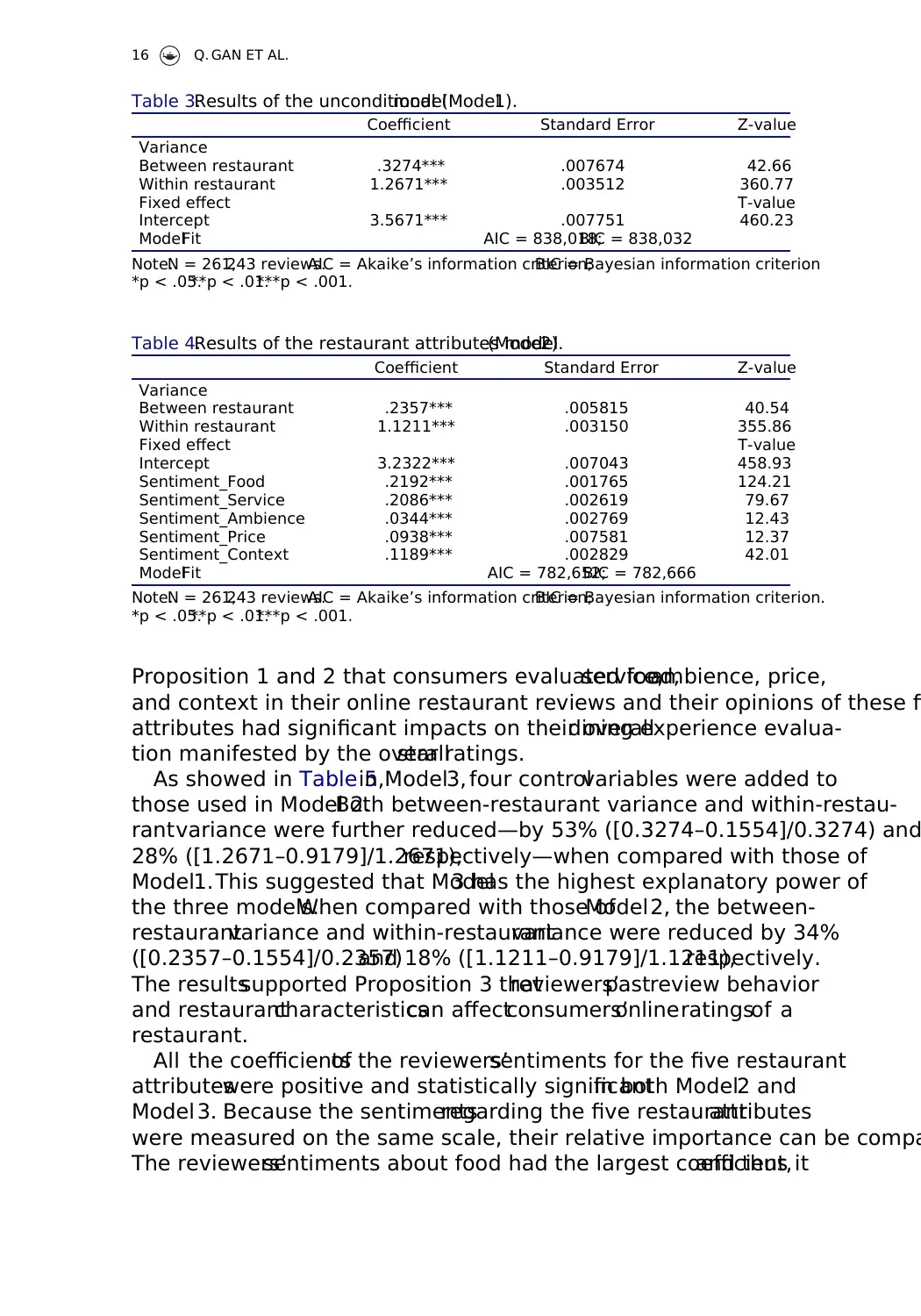
Proposition 1 and 2 that consumers evaluated food,service,ambience, price,
and context in their online restaurant reviews and their opinions of these fi
attributes had significant impacts on their overalldining experience evalua-
tion manifested by the overallstar ratings.
As showed in Table 5,in Model3, four controlvariables were added to
those used in Model 2.Both between-restaurant variance and within-restau-
rantvariance were further reduced—by 53% ([0.3274–0.1554]/0.3274) and
28% ([1.2671–0.9179]/1.2671),respectively—when compared with those of
Model1.This suggested that Model3 has the highest explanatory power of
the three models.When compared with those ofModel2, the between-
restaurantvariance and within-restaurantvariance were reduced by 34%
([0.2357–0.1554]/0.2357)and 18% ([1.1211–0.9179]/1.1211),respectively.
The resultssupported Proposition 3 thatreviewers’pastreview behavior
and restaurantcharacteristicscan affectconsumers’onlineratingsof a
restaurant.
All the coefficientsof the reviewers’sentiments for the five restaurant
attributeswere positive and statistically significantin both Model2 and
Model 3. Because the sentimentsregarding the five restaurantattributes
were measured on the same scale, their relative importance can be compa
The reviewers’sentiments about food had the largest coefficient,and thus it
Table 3.Results of the unconditionalmodel(Model1).
Coefficient Standard Error Z-value
Variance
Between restaurant .3274*** .007674 42.66
Within restaurant 1.2671*** .003512 360.77
Fixed effect T-value
Intercept 3.5671*** .007751 460.23
ModelFit AIC = 838,018;BIC = 838,032
Note.N = 261,243 reviews.AIC = Akaike’s information criterion;BIC = Bayesian information criterion
*p < .05.**p < .01.***p < .001.
Table 4.Results of the restaurant attributes model(Model2).
Coefficient Standard Error Z-value
Variance
Between restaurant .2357*** .005815 40.54
Within restaurant 1.1211*** .003150 355.86
Fixed effect T-value
Intercept 3.2322*** .007043 458.93
Sentiment_Food .2192*** .001765 124.21
Sentiment_Service .2086*** .002619 79.67
Sentiment_Ambience .0344*** .002769 12.43
Sentiment_Price .0938*** .007581 12.37
Sentiment_Context .1189*** .002829 42.01
ModelFit AIC = 782,652;BIC = 782,666
Note.N = 261,243 reviews.AIC = Akaike’s information criterion;BIC = Bayesian information criterion.
*p < .05.**p < .01.***p < .001.
16 Q. GAN ET AL.
and context in their online restaurant reviews and their opinions of these fi
attributes had significant impacts on their overalldining experience evalua-
tion manifested by the overallstar ratings.
As showed in Table 5,in Model3, four controlvariables were added to
those used in Model 2.Both between-restaurant variance and within-restau-
rantvariance were further reduced—by 53% ([0.3274–0.1554]/0.3274) and
28% ([1.2671–0.9179]/1.2671),respectively—when compared with those of
Model1.This suggested that Model3 has the highest explanatory power of
the three models.When compared with those ofModel2, the between-
restaurantvariance and within-restaurantvariance were reduced by 34%
([0.2357–0.1554]/0.2357)and 18% ([1.1211–0.9179]/1.1211),respectively.
The resultssupported Proposition 3 thatreviewers’pastreview behavior
and restaurantcharacteristicscan affectconsumers’onlineratingsof a
restaurant.
All the coefficientsof the reviewers’sentiments for the five restaurant
attributeswere positive and statistically significantin both Model2 and
Model 3. Because the sentimentsregarding the five restaurantattributes
were measured on the same scale, their relative importance can be compa
The reviewers’sentiments about food had the largest coefficient,and thus it
Table 3.Results of the unconditionalmodel(Model1).
Coefficient Standard Error Z-value
Variance
Between restaurant .3274*** .007674 42.66
Within restaurant 1.2671*** .003512 360.77
Fixed effect T-value
Intercept 3.5671*** .007751 460.23
ModelFit AIC = 838,018;BIC = 838,032
Note.N = 261,243 reviews.AIC = Akaike’s information criterion;BIC = Bayesian information criterion
*p < .05.**p < .01.***p < .001.
Table 4.Results of the restaurant attributes model(Model2).
Coefficient Standard Error Z-value
Variance
Between restaurant .2357*** .005815 40.54
Within restaurant 1.1211*** .003150 355.86
Fixed effect T-value
Intercept 3.2322*** .007043 458.93
Sentiment_Food .2192*** .001765 124.21
Sentiment_Service .2086*** .002619 79.67
Sentiment_Ambience .0344*** .002769 12.43
Sentiment_Price .0938*** .007581 12.37
Sentiment_Context .1189*** .002829 42.01
ModelFit AIC = 782,652;BIC = 782,666
Note.N = 261,243 reviews.AIC = Akaike’s information criterion;BIC = Bayesian information criterion.
*p < .05.**p < .01.***p < .001.
16 Q. GAN ET AL.
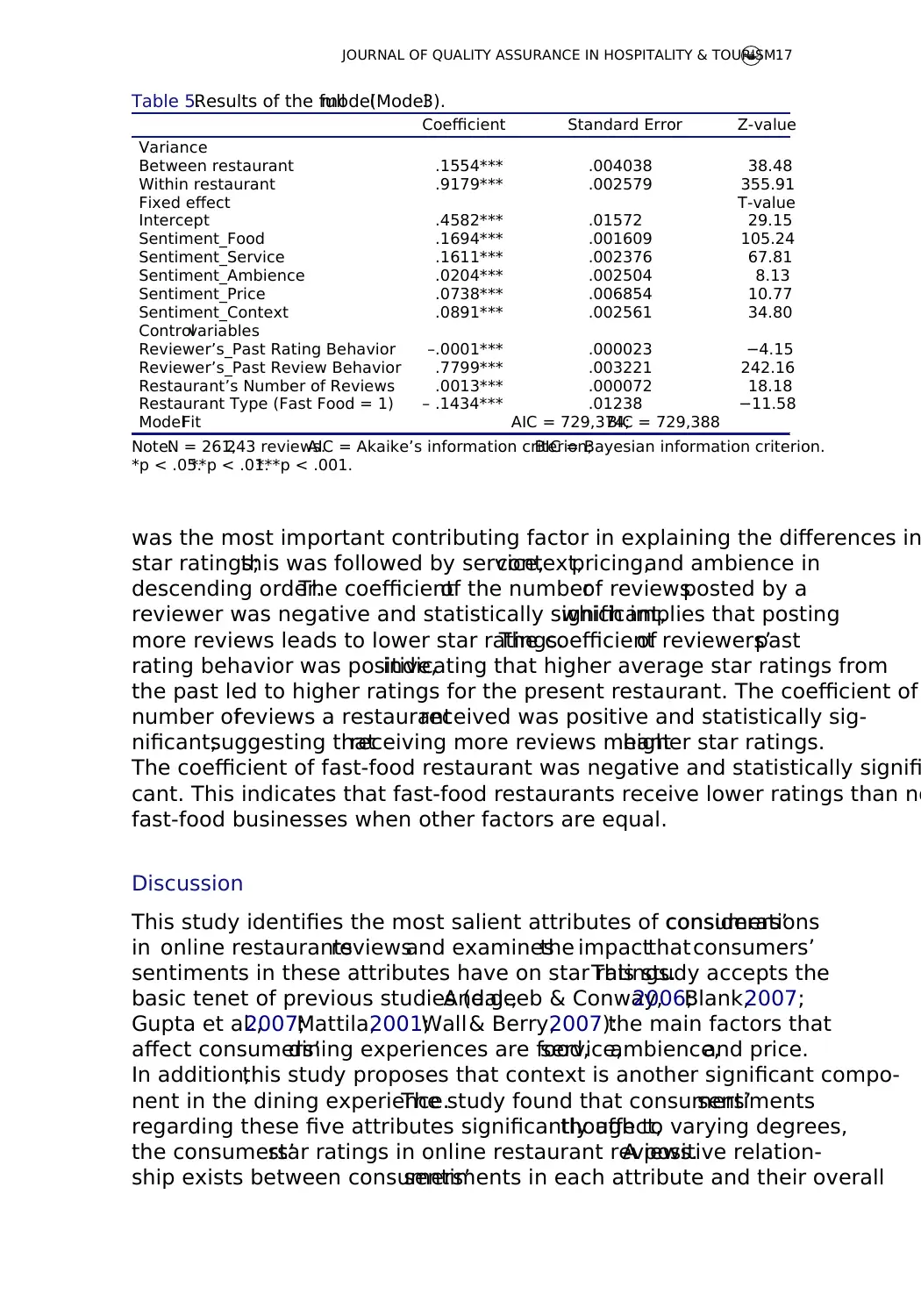
was the most important contributing factor in explaining the differences in
star ratings;this was followed by service,context,pricing,and ambience in
descending order.The coefficientof the numberof reviewsposted by a
reviewer was negative and statistically significant,which implies that posting
more reviews leads to lower star ratings.The coefficientof reviewers’past
rating behavior was positive,indicating that higher average star ratings from
the past led to higher ratings for the present restaurant. The coefficient of
number ofreviews a restaurantreceived was positive and statistically sig-
nificant,suggesting thatreceiving more reviews meanthigher star ratings.
The coefficient of fast-food restaurant was negative and statistically signifi
cant. This indicates that fast-food restaurants receive lower ratings than no
fast-food businesses when other factors are equal.
Discussion
This study identifies the most salient attributes of consumers’considerations
in online restaurantsreviewsand examinesthe impactthat consumers’
sentiments in these attributes have on star ratings.This study accepts the
basic tenet of previous studies (e.g.,Andaleeb & Conway,2006;Blank,2007;
Gupta et al.,2007;Mattila,2001;Wall& Berry,2007):the main factors that
affect consumers’dining experiences are food,service,ambience,and price.
In addition,this study proposes that context is another significant compo-
nent in the dining experience.The study found that consumers’sentiments
regarding these five attributes significantly affect,though to varying degrees,
the consumers’star ratings in online restaurant reviews.A positive relation-
ship exists between consumers’sentiments in each attribute and their overall
Table 5.Results of the fullmodel(Model3).
Coefficient Standard Error Z-value
Variance
Between restaurant .1554*** .004038 38.48
Within restaurant .9179*** .002579 355.91
Fixed effect T-value
Intercept .4582*** .01572 29.15
Sentiment_Food .1694*** .001609 105.24
Sentiment_Service .1611*** .002376 67.81
Sentiment_Ambience .0204*** .002504 8.13
Sentiment_Price .0738*** .006854 10.77
Sentiment_Context .0891*** .002561 34.80
Controlvariables
Reviewer’s_Past Rating Behavior –.0001*** .000023 −4.15
Reviewer’s_Past Review Behavior .7799*** .003221 242.16
Restaurant’s Number of Reviews .0013*** .000072 18.18
Restaurant Type (Fast Food = 1) – .1434*** .01238 −11.58
ModelFit AIC = 729,374;BIC = 729,388
Note.N = 261,243 reviews.AIC = Akaike’s information criterion;BIC = Bayesian information criterion.
*p < .05.**p < .01.***p < .001.
JOURNAL OF QUALITY ASSURANCE IN HOSPITALITY & TOURISM17
star ratings;this was followed by service,context,pricing,and ambience in
descending order.The coefficientof the numberof reviewsposted by a
reviewer was negative and statistically significant,which implies that posting
more reviews leads to lower star ratings.The coefficientof reviewers’past
rating behavior was positive,indicating that higher average star ratings from
the past led to higher ratings for the present restaurant. The coefficient of
number ofreviews a restaurantreceived was positive and statistically sig-
nificant,suggesting thatreceiving more reviews meanthigher star ratings.
The coefficient of fast-food restaurant was negative and statistically signifi
cant. This indicates that fast-food restaurants receive lower ratings than no
fast-food businesses when other factors are equal.
Discussion
This study identifies the most salient attributes of consumers’considerations
in online restaurantsreviewsand examinesthe impactthat consumers’
sentiments in these attributes have on star ratings.This study accepts the
basic tenet of previous studies (e.g.,Andaleeb & Conway,2006;Blank,2007;
Gupta et al.,2007;Mattila,2001;Wall& Berry,2007):the main factors that
affect consumers’dining experiences are food,service,ambience,and price.
In addition,this study proposes that context is another significant compo-
nent in the dining experience.The study found that consumers’sentiments
regarding these five attributes significantly affect,though to varying degrees,
the consumers’star ratings in online restaurant reviews.A positive relation-
ship exists between consumers’sentiments in each attribute and their overall
Table 5.Results of the fullmodel(Model3).
Coefficient Standard Error Z-value
Variance
Between restaurant .1554*** .004038 38.48
Within restaurant .9179*** .002579 355.91
Fixed effect T-value
Intercept .4582*** .01572 29.15
Sentiment_Food .1694*** .001609 105.24
Sentiment_Service .1611*** .002376 67.81
Sentiment_Ambience .0204*** .002504 8.13
Sentiment_Price .0738*** .006854 10.77
Sentiment_Context .0891*** .002561 34.80
Controlvariables
Reviewer’s_Past Rating Behavior –.0001*** .000023 −4.15
Reviewer’s_Past Review Behavior .7799*** .003221 242.16
Restaurant’s Number of Reviews .0013*** .000072 18.18
Restaurant Type (Fast Food = 1) – .1434*** .01238 −11.58
ModelFit AIC = 729,374;BIC = 729,388
Note.N = 261,243 reviews.AIC = Akaike’s information criterion;BIC = Bayesian information criterion.
*p < .05.**p < .01.***p < .001.
JOURNAL OF QUALITY ASSURANCE IN HOSPITALITY & TOURISM17
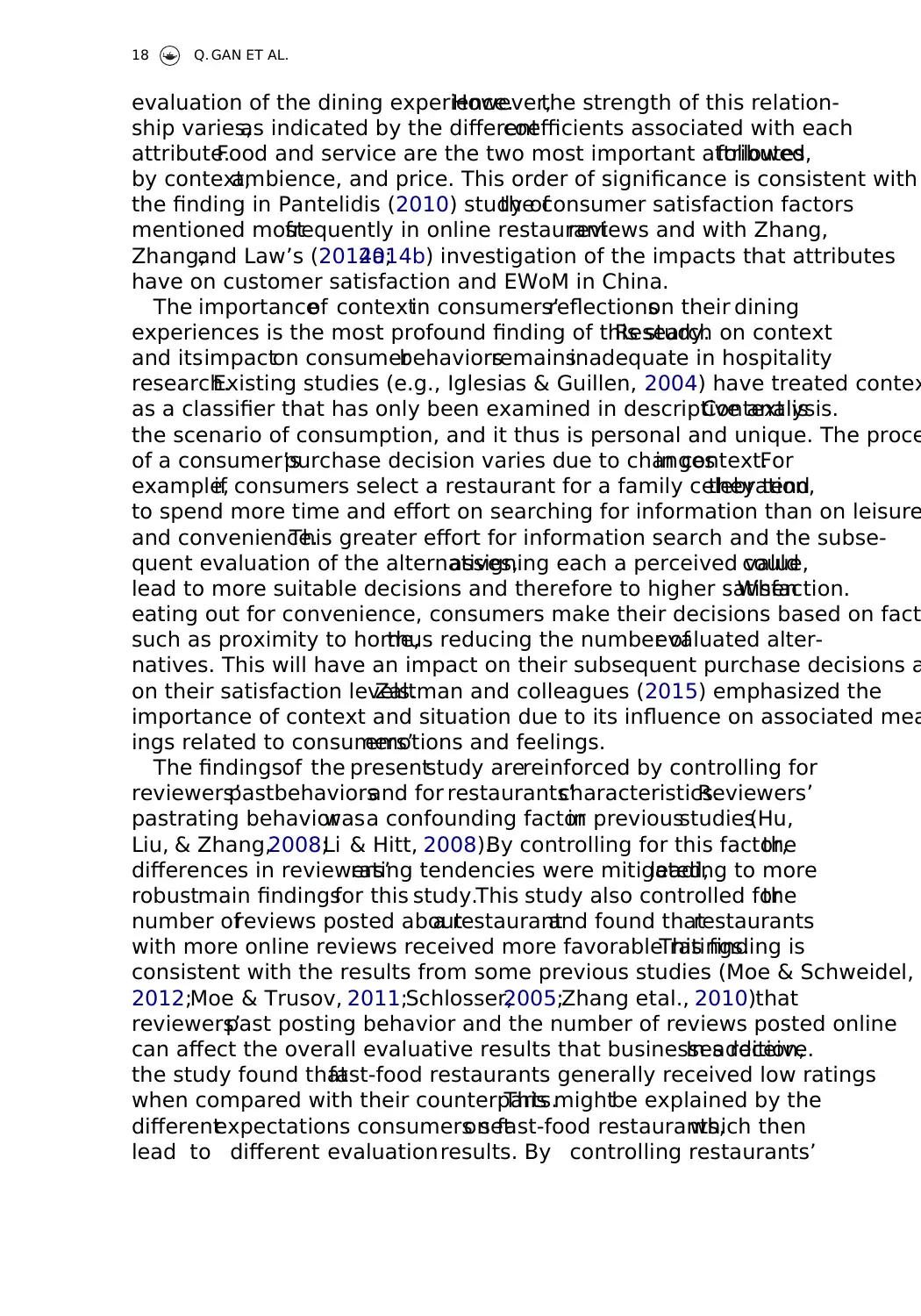
evaluation of the dining experience.However,the strength of this relation-
ship varies,as indicated by the differentcoefficients associated with each
attribute.Food and service are the two most important attributes,followed
by context,ambience, and price. This order of significance is consistent with
the finding in Pantelidis (2010) study ofthe consumer satisfaction factors
mentioned mostfrequently in online restaurantreviews and with Zhang,
Zhang,and Law’s (2014a;2014b) investigation of the impacts that attributes
have on customer satisfaction and EWoM in China.
The importanceof contextin consumers’reflectionson their dining
experiences is the most profound finding of this study.Research on context
and itsimpacton consumerbehaviorsremainsinadequate in hospitality
research.Existing studies (e.g., Iglesias & Guillen, 2004) have treated contex
as a classifier that has only been examined in descriptive analysis.Context is
the scenario of consumption, and it thus is personal and unique. The proce
of a consumer’spurchase decision varies due to changesin context.For
example,if consumers select a restaurant for a family celebration,they tend
to spend more time and effort on searching for information than on leisure
and convenience.This greater effort for information search and the subse-
quent evaluation of the alternatives,assigning each a perceived value,could
lead to more suitable decisions and therefore to higher satisfaction.When
eating out for convenience, consumers make their decisions based on fact
such as proximity to home,thus reducing the number ofevaluated alter-
natives. This will have an impact on their subsequent purchase decisions a
on their satisfaction levels.Zaltman and colleagues (2015) emphasized the
importance of context and situation due to its influence on associated mea
ings related to consumers’emotions and feelings.
The findingsof the presentstudy arereinforced by controlling for
reviewers’pastbehaviorsand for restaurants’characteristics.Reviewers’
pastrating behaviorwasa confounding factorin previousstudies(Hu,
Liu, & Zhang,2008;Li & Hitt, 2008).By controlling for this factor,the
differences in reviewers’rating tendencies were mitigated,leading to more
robustmain findingsfor this study.This study also controlled forthe
number ofreviews posted abouta restaurantand found thatrestaurants
with more online reviews received more favorable ratings.This finding is
consistent with the results from some previous studies (Moe & Schweidel,
2012;Moe & Trusov, 2011;Schlosser,2005;Zhang etal., 2010)that
reviewers’past posting behavior and the number of reviews posted online
can affect the overall evaluative results that businesses receive.In addition,
the study found thatfast-food restaurants generally received low ratings
when compared with their counterparts.This mightbe explained by the
differentexpectations consumers seton fast-food restaurants,which then
lead to different evaluationresults. By controlling restaurants’
18 Q. GAN ET AL.
ship varies,as indicated by the differentcoefficients associated with each
attribute.Food and service are the two most important attributes,followed
by context,ambience, and price. This order of significance is consistent with
the finding in Pantelidis (2010) study ofthe consumer satisfaction factors
mentioned mostfrequently in online restaurantreviews and with Zhang,
Zhang,and Law’s (2014a;2014b) investigation of the impacts that attributes
have on customer satisfaction and EWoM in China.
The importanceof contextin consumers’reflectionson their dining
experiences is the most profound finding of this study.Research on context
and itsimpacton consumerbehaviorsremainsinadequate in hospitality
research.Existing studies (e.g., Iglesias & Guillen, 2004) have treated contex
as a classifier that has only been examined in descriptive analysis.Context is
the scenario of consumption, and it thus is personal and unique. The proce
of a consumer’spurchase decision varies due to changesin context.For
example,if consumers select a restaurant for a family celebration,they tend
to spend more time and effort on searching for information than on leisure
and convenience.This greater effort for information search and the subse-
quent evaluation of the alternatives,assigning each a perceived value,could
lead to more suitable decisions and therefore to higher satisfaction.When
eating out for convenience, consumers make their decisions based on fact
such as proximity to home,thus reducing the number ofevaluated alter-
natives. This will have an impact on their subsequent purchase decisions a
on their satisfaction levels.Zaltman and colleagues (2015) emphasized the
importance of context and situation due to its influence on associated mea
ings related to consumers’emotions and feelings.
The findingsof the presentstudy arereinforced by controlling for
reviewers’pastbehaviorsand for restaurants’characteristics.Reviewers’
pastrating behaviorwasa confounding factorin previousstudies(Hu,
Liu, & Zhang,2008;Li & Hitt, 2008).By controlling for this factor,the
differences in reviewers’rating tendencies were mitigated,leading to more
robustmain findingsfor this study.This study also controlled forthe
number ofreviews posted abouta restaurantand found thatrestaurants
with more online reviews received more favorable ratings.This finding is
consistent with the results from some previous studies (Moe & Schweidel,
2012;Moe & Trusov, 2011;Schlosser,2005;Zhang etal., 2010)that
reviewers’past posting behavior and the number of reviews posted online
can affect the overall evaluative results that businesses receive.In addition,
the study found thatfast-food restaurants generally received low ratings
when compared with their counterparts.This mightbe explained by the
differentexpectations consumers seton fast-food restaurants,which then
lead to different evaluationresults. By controlling restaurants’
18 Q. GAN ET AL.
Paraphrase This Document
Need a fresh take? Get an instant paraphrase of this document with our AI Paraphraser
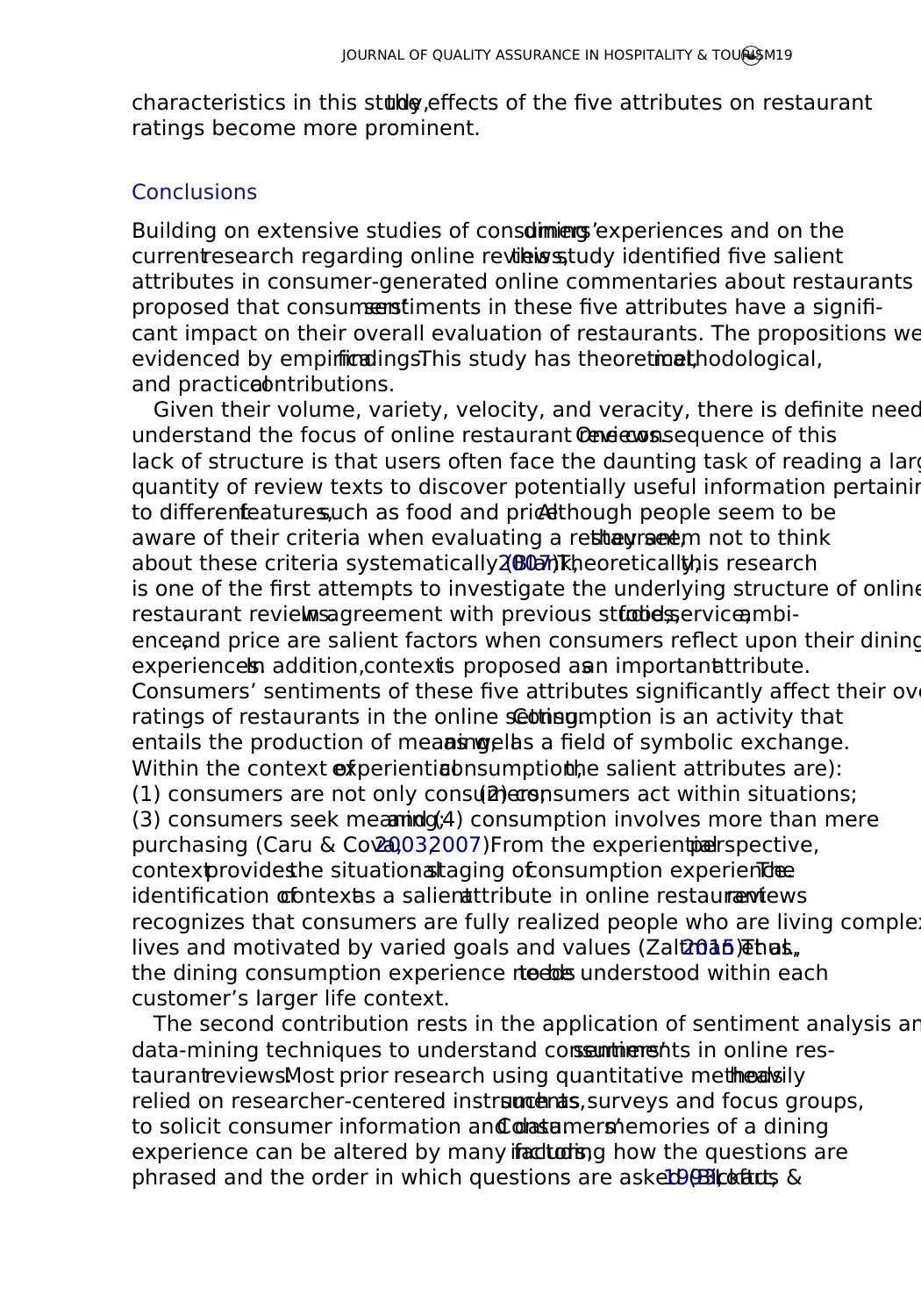
characteristics in this study,the effects of the five attributes on restaurant
ratings become more prominent.
Conclusions
Building on extensive studies of consumers’dining experiences and on the
currentresearch regarding online reviews,this study identified five salient
attributes in consumer-generated online commentaries about restaurants a
proposed that consumers’sentiments in these five attributes have a signifi-
cant impact on their overall evaluation of restaurants. The propositions we
evidenced by empiricalfindings.This study has theoretical,methodological,
and practicalcontributions.
Given their volume, variety, velocity, and veracity, there is definite need
understand the focus of online restaurant reviews.One consequence of this
lack of structure is that users often face the daunting task of reading a larg
quantity of review texts to discover potentially useful information pertainin
to differentfeatures,such as food and price.Although people seem to be
aware of their criteria when evaluating a restaurant,they seem not to think
about these criteria systematically (Blank,2007).Theoretically,this research
is one of the first attempts to investigate the underlying structure of online
restaurant reviews.In agreement with previous studies,food,service,ambi-
ence,and price are salient factors when consumers reflect upon their dining
experiences.In addition,contextis proposed asan importantattribute.
Consumers’ sentiments of these five attributes significantly affect their ove
ratings of restaurants in the online setting.Consumption is an activity that
entails the production of meaning,as wellas a field of symbolic exchange.
Within the context ofexperientialconsumption,the salient attributes are):
(1) consumers are not only consumers;(2) consumers act within situations;
(3) consumers seek meaning;and (4) consumption involves more than mere
purchasing (Caru & Cova,2003,2007).From the experientialperspective,
contextprovidesthe situationalstaging ofconsumption experience.The
identification ofcontextas a salientattribute in online restaurantreviews
recognizes that consumers are fully realized people who are living complex
lives and motivated by varied goals and values (Zaltman et al.,2015).Thus,
the dining consumption experience needsto be understood within each
customer’s larger life context.
The second contribution rests in the application of sentiment analysis an
data-mining techniques to understand consumers’sentiments in online res-
taurantreviews.Most prior research using quantitative methodsheavily
relied on researcher-centered instruments,such as surveys and focus groups,
to solicit consumer information and data.Consumers’memories of a dining
experience can be altered by many factors,including how the questions are
phrased and the order in which questions are asked (Bickart,1993;Loftus &
JOURNAL OF QUALITY ASSURANCE IN HOSPITALITY & TOURISM19
ratings become more prominent.
Conclusions
Building on extensive studies of consumers’dining experiences and on the
currentresearch regarding online reviews,this study identified five salient
attributes in consumer-generated online commentaries about restaurants a
proposed that consumers’sentiments in these five attributes have a signifi-
cant impact on their overall evaluation of restaurants. The propositions we
evidenced by empiricalfindings.This study has theoretical,methodological,
and practicalcontributions.
Given their volume, variety, velocity, and veracity, there is definite need
understand the focus of online restaurant reviews.One consequence of this
lack of structure is that users often face the daunting task of reading a larg
quantity of review texts to discover potentially useful information pertainin
to differentfeatures,such as food and price.Although people seem to be
aware of their criteria when evaluating a restaurant,they seem not to think
about these criteria systematically (Blank,2007).Theoretically,this research
is one of the first attempts to investigate the underlying structure of online
restaurant reviews.In agreement with previous studies,food,service,ambi-
ence,and price are salient factors when consumers reflect upon their dining
experiences.In addition,contextis proposed asan importantattribute.
Consumers’ sentiments of these five attributes significantly affect their ove
ratings of restaurants in the online setting.Consumption is an activity that
entails the production of meaning,as wellas a field of symbolic exchange.
Within the context ofexperientialconsumption,the salient attributes are):
(1) consumers are not only consumers;(2) consumers act within situations;
(3) consumers seek meaning;and (4) consumption involves more than mere
purchasing (Caru & Cova,2003,2007).From the experientialperspective,
contextprovidesthe situationalstaging ofconsumption experience.The
identification ofcontextas a salientattribute in online restaurantreviews
recognizes that consumers are fully realized people who are living complex
lives and motivated by varied goals and values (Zaltman et al.,2015).Thus,
the dining consumption experience needsto be understood within each
customer’s larger life context.
The second contribution rests in the application of sentiment analysis an
data-mining techniques to understand consumers’sentiments in online res-
taurantreviews.Most prior research using quantitative methodsheavily
relied on researcher-centered instruments,such as surveys and focus groups,
to solicit consumer information and data.Consumers’memories of a dining
experience can be altered by many factors,including how the questions are
phrased and the order in which questions are asked (Bickart,1993;Loftus &
JOURNAL OF QUALITY ASSURANCE IN HOSPITALITY & TOURISM19
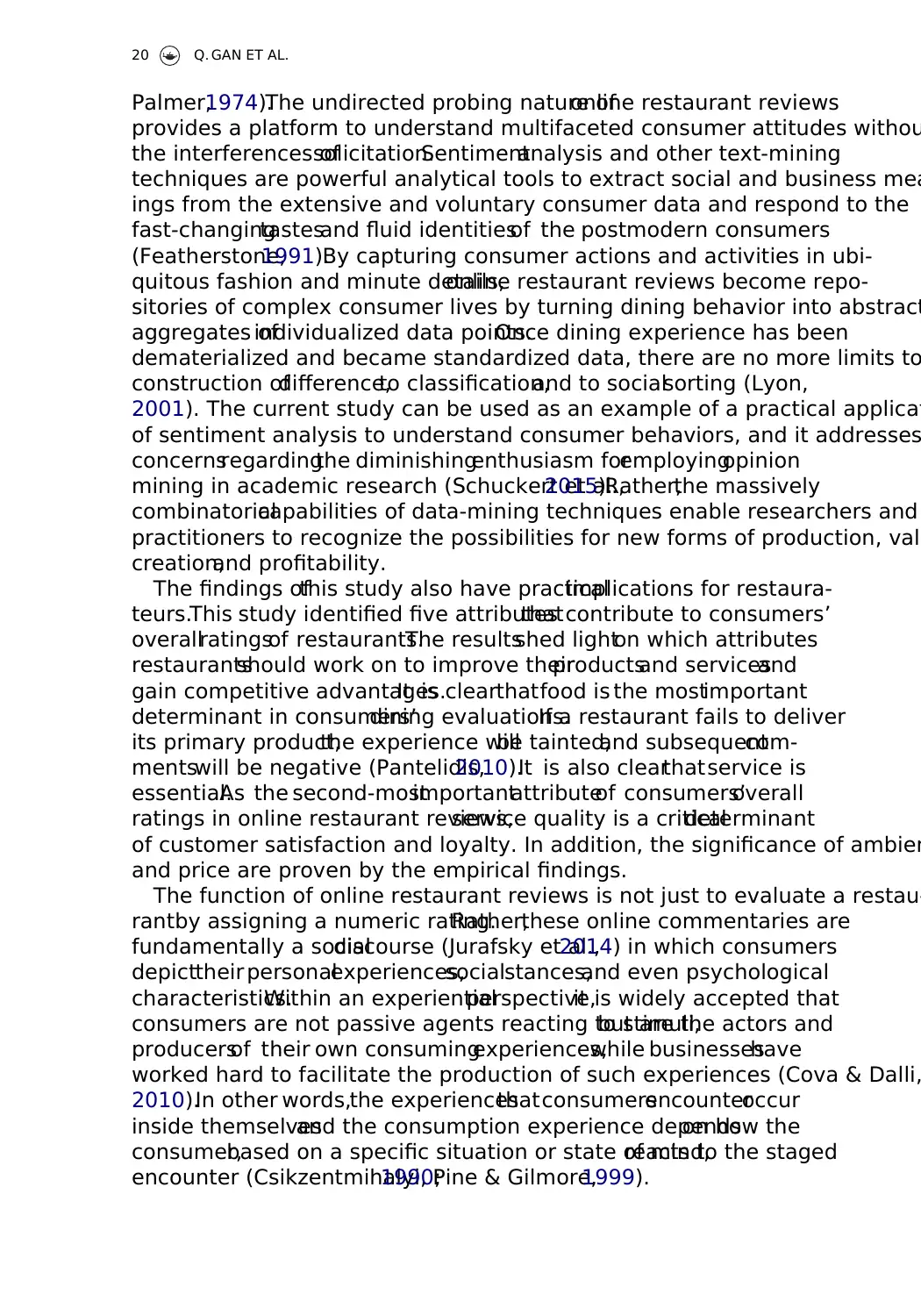
Palmer,1974).The undirected probing nature ofonline restaurant reviews
provides a platform to understand multifaceted consumer attitudes withou
the interferences ofsolicitation.Sentimentanalysis and other text-mining
techniques are powerful analytical tools to extract social and business mea
ings from the extensive and voluntary consumer data and respond to the
fast-changingtastesand fluid identitiesof the postmodern consumers
(Featherstone,1991).By capturing consumer actions and activities in ubi-
quitous fashion and minute details,online restaurant reviews become repo-
sitories of complex consumer lives by turning dining behavior into abstract
aggregates ofindividualized data points.Once dining experience has been
dematerialized and became standardized data, there are no more limits to
construction ofdifference,to classification,and to socialsorting (Lyon,
2001). The current study can be used as an example of a practical applicat
of sentiment analysis to understand consumer behaviors, and it addresses
concernsregardingthe diminishingenthusiasm foremployingopinion
mining in academic research (Schuckert et al.,2015).Rather,the massively
combinatorialcapabilities of data-mining techniques enable researchers and
practitioners to recognize the possibilities for new forms of production, valu
creation,and profitability.
The findings ofthis study also have practicalimplications for restaura-
teurs.This study identified five attributesthatcontribute to consumers’
overallratingsof restaurants.The resultsshed lighton which attributes
restaurantsshould work on to improve theirproductsand servicesand
gain competitive advantages.It is clearthatfood is the mostimportant
determinant in consumers’dining evaluations.If a restaurant fails to deliver
its primary product,the experience willbe tainted,and subsequentcom-
mentswill be negative (Pantelidis,2010).It is also clearthatservice is
essential.As the second-mostimportantattributeof consumers’overall
ratings in online restaurant reviews,service quality is a criticaldeterminant
of customer satisfaction and loyalty. In addition, the significance of ambien
and price are proven by the empirical findings.
The function of online restaurant reviews is not just to evaluate a restau-
rantby assigning a numeric rating.Rather,these online commentaries are
fundamentally a socialdiscourse (Jurafsky et al.,2014) in which consumers
depicttheir personalexperiences,socialstances,and even psychological
characteristics.Within an experientialperspective,it is widely accepted that
consumers are not passive agents reacting to stimuli,but are the actors and
producersof their own consumingexperiences,while businesseshave
worked hard to facilitate the production of such experiences (Cova & Dalli,
2010).In other words,the experiencesthatconsumersencounteroccur
inside themselvesand the consumption experience dependson how the
consumer,based on a specific situation or state of mind,reacts to the staged
encounter (Csikzentmihalyi,1990;Pine & Gilmore,1999).
20 Q. GAN ET AL.
provides a platform to understand multifaceted consumer attitudes withou
the interferences ofsolicitation.Sentimentanalysis and other text-mining
techniques are powerful analytical tools to extract social and business mea
ings from the extensive and voluntary consumer data and respond to the
fast-changingtastesand fluid identitiesof the postmodern consumers
(Featherstone,1991).By capturing consumer actions and activities in ubi-
quitous fashion and minute details,online restaurant reviews become repo-
sitories of complex consumer lives by turning dining behavior into abstract
aggregates ofindividualized data points.Once dining experience has been
dematerialized and became standardized data, there are no more limits to
construction ofdifference,to classification,and to socialsorting (Lyon,
2001). The current study can be used as an example of a practical applicat
of sentiment analysis to understand consumer behaviors, and it addresses
concernsregardingthe diminishingenthusiasm foremployingopinion
mining in academic research (Schuckert et al.,2015).Rather,the massively
combinatorialcapabilities of data-mining techniques enable researchers and
practitioners to recognize the possibilities for new forms of production, valu
creation,and profitability.
The findings ofthis study also have practicalimplications for restaura-
teurs.This study identified five attributesthatcontribute to consumers’
overallratingsof restaurants.The resultsshed lighton which attributes
restaurantsshould work on to improve theirproductsand servicesand
gain competitive advantages.It is clearthatfood is the mostimportant
determinant in consumers’dining evaluations.If a restaurant fails to deliver
its primary product,the experience willbe tainted,and subsequentcom-
mentswill be negative (Pantelidis,2010).It is also clearthatservice is
essential.As the second-mostimportantattributeof consumers’overall
ratings in online restaurant reviews,service quality is a criticaldeterminant
of customer satisfaction and loyalty. In addition, the significance of ambien
and price are proven by the empirical findings.
The function of online restaurant reviews is not just to evaluate a restau-
rantby assigning a numeric rating.Rather,these online commentaries are
fundamentally a socialdiscourse (Jurafsky et al.,2014) in which consumers
depicttheir personalexperiences,socialstances,and even psychological
characteristics.Within an experientialperspective,it is widely accepted that
consumers are not passive agents reacting to stimuli,but are the actors and
producersof their own consumingexperiences,while businesseshave
worked hard to facilitate the production of such experiences (Cova & Dalli,
2010).In other words,the experiencesthatconsumersencounteroccur
inside themselvesand the consumption experience dependson how the
consumer,based on a specific situation or state of mind,reacts to the staged
encounter (Csikzentmihalyi,1990;Pine & Gilmore,1999).
20 Q. GAN ET AL.
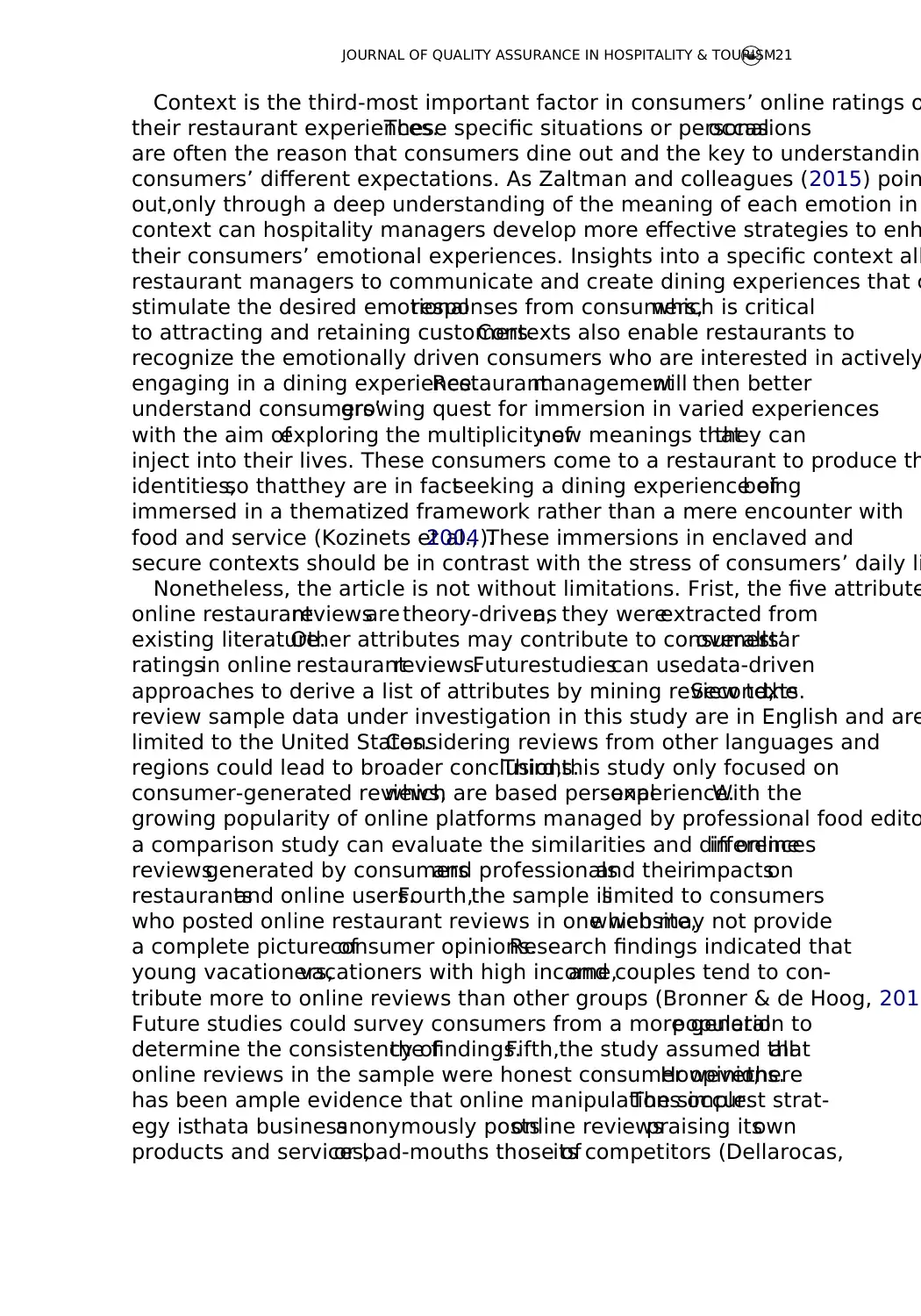
Context is the third-most important factor in consumers’ online ratings o
their restaurant experiences.These specific situations or personaloccasions
are often the reason that consumers dine out and the key to understanding
consumers’ different expectations. As Zaltman and colleagues (2015) poin
out,only through a deep understanding of the meaning of each emotion in
context can hospitality managers develop more effective strategies to enh
their consumers’ emotional experiences. Insights into a specific context all
restaurant managers to communicate and create dining experiences that c
stimulate the desired emotionalresponses from consumers,which is critical
to attracting and retaining customers.Contexts also enable restaurants to
recognize the emotionally driven consumers who are interested in actively
engaging in a dining experience.Restaurantmanagementwill then better
understand consumers’growing quest for immersion in varied experiences
with the aim ofexploring the multiplicity ofnew meanings thatthey can
inject into their lives. These consumers come to a restaurant to produce th
identities,so thatthey are in factseeking a dining experience ofbeing
immersed in a thematized framework rather than a mere encounter with
food and service (Kozinets et al.,2004).These immersions in enclaved and
secure contexts should be in contrast with the stress of consumers’ daily li
Nonetheless, the article is not without limitations. Frist, the five attribute
online restaurantreviewsare theory-driven,as they wereextracted from
existing literature.Other attributes may contribute to consumers’overallstar
ratingsin online restaurantreviews.Futurestudiescan usedata-driven
approaches to derive a list of attributes by mining review texts.Second,the
review sample data under investigation in this study are in English and are
limited to the United States.Considering reviews from other languages and
regions could lead to broader conclusions.Third,this study only focused on
consumer-generated reviews,which are based personalexperience.With the
growing popularity of online platforms managed by professional food edito
a comparison study can evaluate the similarities and differencesin online
reviewsgenerated by consumersand professionalsand theirimpactson
restaurantsand online users.Fourth,the sample islimited to consumers
who posted online restaurant reviews in one website,which may not provide
a complete picture ofconsumer opinions.Research findings indicated that
young vacationers,vacationers with high income,and couples tend to con-
tribute more to online reviews than other groups (Bronner & de Hoog, 2010
Future studies could survey consumers from a more generalpopulation to
determine the consistency ofthe findings.Fifth,the study assumed thatall
online reviews in the sample were honest consumer opinions.However,there
has been ample evidence that online manipulations occur.The simplest strat-
egy isthata businessanonymously postsonline reviewspraising itsown
products and services,or bad-mouths those ofits competitors (Dellarocas,
JOURNAL OF QUALITY ASSURANCE IN HOSPITALITY & TOURISM21
their restaurant experiences.These specific situations or personaloccasions
are often the reason that consumers dine out and the key to understanding
consumers’ different expectations. As Zaltman and colleagues (2015) poin
out,only through a deep understanding of the meaning of each emotion in
context can hospitality managers develop more effective strategies to enh
their consumers’ emotional experiences. Insights into a specific context all
restaurant managers to communicate and create dining experiences that c
stimulate the desired emotionalresponses from consumers,which is critical
to attracting and retaining customers.Contexts also enable restaurants to
recognize the emotionally driven consumers who are interested in actively
engaging in a dining experience.Restaurantmanagementwill then better
understand consumers’growing quest for immersion in varied experiences
with the aim ofexploring the multiplicity ofnew meanings thatthey can
inject into their lives. These consumers come to a restaurant to produce th
identities,so thatthey are in factseeking a dining experience ofbeing
immersed in a thematized framework rather than a mere encounter with
food and service (Kozinets et al.,2004).These immersions in enclaved and
secure contexts should be in contrast with the stress of consumers’ daily li
Nonetheless, the article is not without limitations. Frist, the five attribute
online restaurantreviewsare theory-driven,as they wereextracted from
existing literature.Other attributes may contribute to consumers’overallstar
ratingsin online restaurantreviews.Futurestudiescan usedata-driven
approaches to derive a list of attributes by mining review texts.Second,the
review sample data under investigation in this study are in English and are
limited to the United States.Considering reviews from other languages and
regions could lead to broader conclusions.Third,this study only focused on
consumer-generated reviews,which are based personalexperience.With the
growing popularity of online platforms managed by professional food edito
a comparison study can evaluate the similarities and differencesin online
reviewsgenerated by consumersand professionalsand theirimpactson
restaurantsand online users.Fourth,the sample islimited to consumers
who posted online restaurant reviews in one website,which may not provide
a complete picture ofconsumer opinions.Research findings indicated that
young vacationers,vacationers with high income,and couples tend to con-
tribute more to online reviews than other groups (Bronner & de Hoog, 2010
Future studies could survey consumers from a more generalpopulation to
determine the consistency ofthe findings.Fifth,the study assumed thatall
online reviews in the sample were honest consumer opinions.However,there
has been ample evidence that online manipulations occur.The simplest strat-
egy isthata businessanonymously postsonline reviewspraising itsown
products and services,or bad-mouths those ofits competitors (Dellarocas,
JOURNAL OF QUALITY ASSURANCE IN HOSPITALITY & TOURISM21
Secure Best Marks with AI Grader
Need help grading? Try our AI Grader for instant feedback on your assignments.
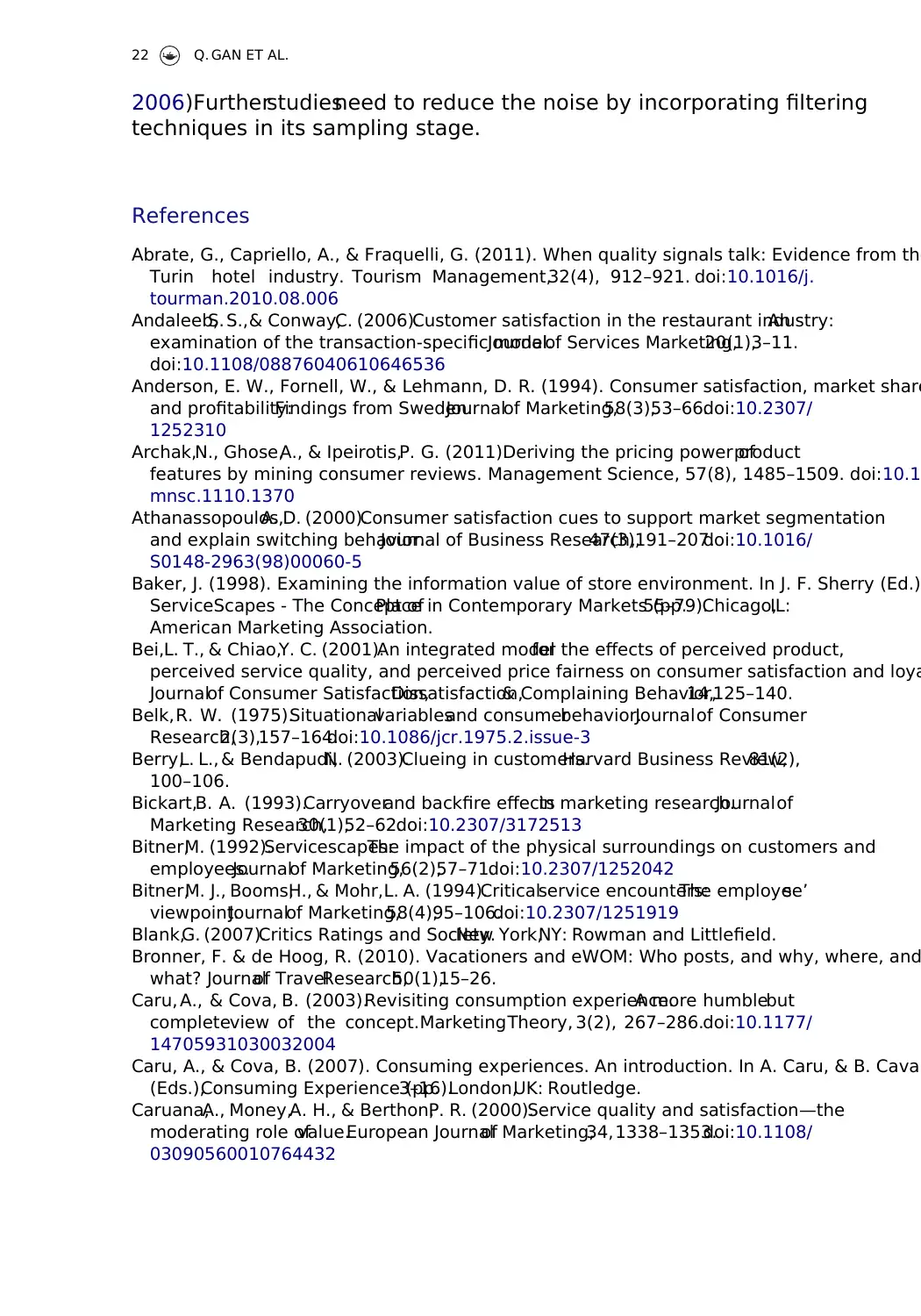
2006).Furtherstudiesneed to reduce the noise by incorporating filtering
techniques in its sampling stage.
References
Abrate, G., Capriello, A., & Fraquelli, G. (2011). When quality signals talk: Evidence from the
Turin hotel industry. Tourism Management,32(4), 912–921. doi:10.1016/j.
tourman.2010.08.006
Andaleeb,S. S.,& Conway,C. (2006).Customer satisfaction in the restaurant industry:An
examination of the transaction-specific model.Journalof Services Marketing,20(1),3–11.
doi:10.1108/08876040610646536
Anderson, E. W., Fornell, W., & Lehmann, D. R. (1994). Consumer satisfaction, market share
and profitability:Findings from Sweden.Journalof Marketing,58(3),53–66.doi:10.2307/
1252310
Archak,N., Ghose,A., & Ipeirotis,P. G. (2011).Deriving the pricing power ofproduct
features by mining consumer reviews. Management Science, 57(8), 1485–1509. doi:10.12
mnsc.1110.1370
Athanassopoulos,A. D. (2000).Consumer satisfaction cues to support market segmentation
and explain switching behavior.Journal of Business Research,47(3),191–207.doi:10.1016/
S0148-2963(98)00060-5
Baker, J. (1998). Examining the information value of store environment. In J. F. Sherry (Ed.),
ServiceScapes - The Concept ofPlace in Contemporary Markets (pp.55–79).Chicago,IL:
American Marketing Association.
Bei,L. T., & Chiao,Y. C. (2001).An integrated modelfor the effects of perceived product,
perceived service quality, and perceived price fairness on consumer satisfaction and loya
Journalof Consumer Satisfaction,Dissatisfaction,& Complaining Behavior,14,125–140.
Belk,R. W. (1975).Situationalvariablesand consumerbehavior.Journalof Consumer
Research,2(3),157–164.doi:10.1086/jcr.1975.2.issue-3
Berry,L. L., & Bendapudi,N. (2003).Clueing in customers.Harvard Business Review,81(2),
100–106.
Bickart,B. A. (1993).Carryoverand backfire effectsin marketing research.Journalof
Marketing Research,30(1),52–62.doi:10.2307/3172513
Bitner,M. (1992).Servicescapes:The impact of the physical surroundings on customers and
employees.Journalof Marketing,56(2),57–71.doi:10.2307/1252042
Bitner,M. J., Booms,H., & Mohr,L. A. (1994).Criticalservice encounters:The employee’s
viewpoint.Journalof Marketing,58(4),95–106.doi:10.2307/1251919
Blank,G. (2007).Critics Ratings and Society.New York,NY: Rowman and Littlefield.
Bronner, F. & de Hoog, R. (2010). Vacationers and eWOM: Who posts, and why, where, and
what? Journalof TravelResearch,50(1),15–26.
Caru, A., & Cova, B. (2003).Revisiting consumption experience.A more humblebut
completeview of the concept.MarketingTheory, 3(2), 267–286.doi:10.1177/
14705931030032004
Caru, A., & Cova, B. (2007). Consuming experiences. An introduction. In A. Caru, & B. Cava
(Eds.),Consuming Experience (pp.3–16).London,UK: Routledge.
Caruana,A., Money,A. H., & Berthon,P. R. (2000).Service quality and satisfaction—the
moderating role ofvalue.European Journalof Marketing,34,1338–1353.doi:10.1108/
03090560010764432
22 Q. GAN ET AL.
techniques in its sampling stage.
References
Abrate, G., Capriello, A., & Fraquelli, G. (2011). When quality signals talk: Evidence from the
Turin hotel industry. Tourism Management,32(4), 912–921. doi:10.1016/j.
tourman.2010.08.006
Andaleeb,S. S.,& Conway,C. (2006).Customer satisfaction in the restaurant industry:An
examination of the transaction-specific model.Journalof Services Marketing,20(1),3–11.
doi:10.1108/08876040610646536
Anderson, E. W., Fornell, W., & Lehmann, D. R. (1994). Consumer satisfaction, market share
and profitability:Findings from Sweden.Journalof Marketing,58(3),53–66.doi:10.2307/
1252310
Archak,N., Ghose,A., & Ipeirotis,P. G. (2011).Deriving the pricing power ofproduct
features by mining consumer reviews. Management Science, 57(8), 1485–1509. doi:10.12
mnsc.1110.1370
Athanassopoulos,A. D. (2000).Consumer satisfaction cues to support market segmentation
and explain switching behavior.Journal of Business Research,47(3),191–207.doi:10.1016/
S0148-2963(98)00060-5
Baker, J. (1998). Examining the information value of store environment. In J. F. Sherry (Ed.),
ServiceScapes - The Concept ofPlace in Contemporary Markets (pp.55–79).Chicago,IL:
American Marketing Association.
Bei,L. T., & Chiao,Y. C. (2001).An integrated modelfor the effects of perceived product,
perceived service quality, and perceived price fairness on consumer satisfaction and loya
Journalof Consumer Satisfaction,Dissatisfaction,& Complaining Behavior,14,125–140.
Belk,R. W. (1975).Situationalvariablesand consumerbehavior.Journalof Consumer
Research,2(3),157–164.doi:10.1086/jcr.1975.2.issue-3
Berry,L. L., & Bendapudi,N. (2003).Clueing in customers.Harvard Business Review,81(2),
100–106.
Bickart,B. A. (1993).Carryoverand backfire effectsin marketing research.Journalof
Marketing Research,30(1),52–62.doi:10.2307/3172513
Bitner,M. (1992).Servicescapes:The impact of the physical surroundings on customers and
employees.Journalof Marketing,56(2),57–71.doi:10.2307/1252042
Bitner,M. J., Booms,H., & Mohr,L. A. (1994).Criticalservice encounters:The employee’s
viewpoint.Journalof Marketing,58(4),95–106.doi:10.2307/1251919
Blank,G. (2007).Critics Ratings and Society.New York,NY: Rowman and Littlefield.
Bronner, F. & de Hoog, R. (2010). Vacationers and eWOM: Who posts, and why, where, and
what? Journalof TravelResearch,50(1),15–26.
Caru, A., & Cova, B. (2003).Revisiting consumption experience.A more humblebut
completeview of the concept.MarketingTheory, 3(2), 267–286.doi:10.1177/
14705931030032004
Caru, A., & Cova, B. (2007). Consuming experiences. An introduction. In A. Caru, & B. Cava
(Eds.),Consuming Experience (pp.3–16).London,UK: Routledge.
Caruana,A., Money,A. H., & Berthon,P. R. (2000).Service quality and satisfaction—the
moderating role ofvalue.European Journalof Marketing,34,1338–1353.doi:10.1108/
03090560010764432
22 Q. GAN ET AL.
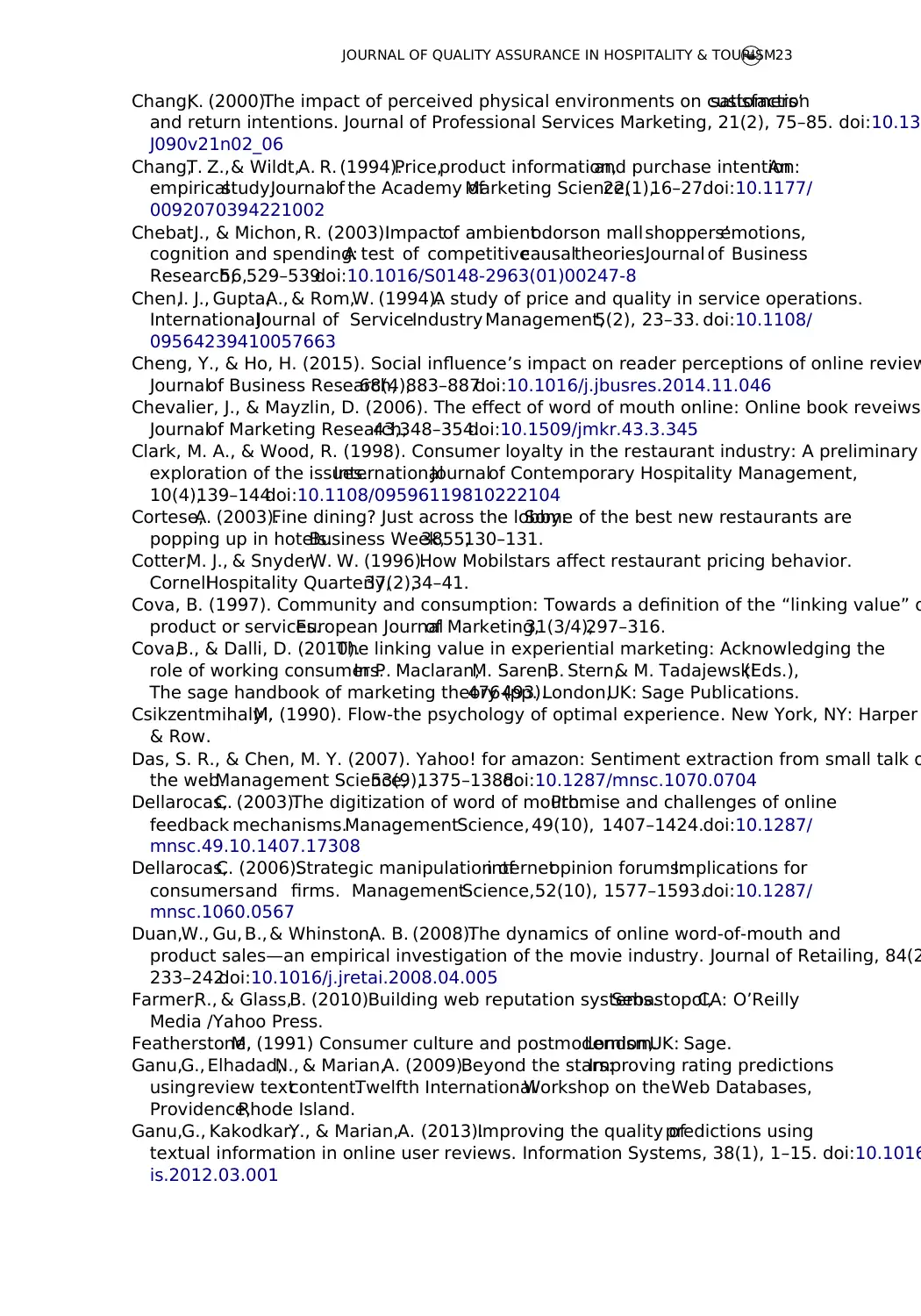
Chang,K. (2000).The impact of perceived physical environments on customers’satisfaction
and return intentions. Journal of Professional Services Marketing, 21(2), 75–85. doi:10.130
J090v21n02_06
Chang,T. Z.,& Wildt,A. R. (1994).Price,product information,and purchase intention:An
empiricalstudy.Journalof the Academy ofMarketing Science,22(1),16–27.doi:10.1177/
0092070394221002
Chebat,J., & Michon, R. (2003).Impactof ambientodorson mall shoppers’emotions,
cognition and spending:A test of competitivecausaltheories.Journal of Business
Research,56,529–539.doi:10.1016/S0148-2963(01)00247-8
Chen,I. J., Gupta,A., & Rom,W. (1994).A study of price and quality in service operations.
InternationalJournal of ServiceIndustry Management,5(2), 23–33. doi:10.1108/
09564239410057663
Cheng, Y., & Ho, H. (2015). Social influence’s impact on reader perceptions of online review
Journalof Business Research,68(4),883–887.doi:10.1016/j.jbusres.2014.11.046
Chevalier, J., & Mayzlin, D. (2006). The effect of word of mouth online: Online book reveiws.
Journalof Marketing Research,43,348–354.doi:10.1509/jmkr.43.3.345
Clark, M. A., & Wood, R. (1998). Consumer loyalty in the restaurant industry: A preliminary
exploration of the issues.InternationalJournalof Contemporary Hospitality Management,
10(4),139–144.doi:10.1108/09596119810222104
Cortese,A. (2003).Fine dining? Just across the lobby:Some of the best new restaurants are
popping up in hotels.Business Week,3855,130–131.
Cotter,M. J., & Snyder,W. W. (1996).How Mobilstars affect restaurant pricing behavior.
CornellHospitality Quarterly,37(2),34–41.
Cova, B. (1997). Community and consumption: Towards a definition of the “linking value” o
product or services.European Journalof Marketing,31(3/4),297–316.
Cova,B., & Dalli, D. (2010).The linking value in experiential marketing: Acknowledging the
role of working consumers.In P. Maclaran,M. Saren,B. Stern,& M. Tadajewski(Eds.),
The sage handbook of marketing theory (pp.476–493).London,UK: Sage Publications.
Csikzentmihalyi,M. (1990). Flow-the psychology of optimal experience. New York, NY: Harper
& Row.
Das, S. R., & Chen, M. Y. (2007). Yahoo! for amazon: Sentiment extraction from small talk o
the web.Management Science,53(9),1375–1388.doi:10.1287/mnsc.1070.0704
Dellarocas,C. (2003).The digitization of word of mouth:Promise and challenges of online
feedback mechanisms.ManagementScience, 49(10), 1407–1424.doi:10.1287/
mnsc.49.10.1407.17308
Dellarocas,C. (2006).Strategic manipulation ofinternetopinion forums:Implications for
consumersand firms. ManagementScience,52(10), 1577–1593.doi:10.1287/
mnsc.1060.0567
Duan,W., Gu, B., & Whinston,A. B. (2008).The dynamics of online word-of-mouth and
product sales—an empirical investigation of the movie industry. Journal of Retailing, 84(2
233–242.doi:10.1016/j.jretai.2008.04.005
Farmer,R., & Glass,B. (2010).Building web reputation systems.Sebastopol,CA: O’Reilly
Media /Yahoo Press.
Featherstone,M. (1991) Consumer culture and postmodernism.London,UK: Sage.
Ganu,G., Elhadad,N., & Marian,A. (2009).Beyond the stars:Improving rating predictions
usingreview textcontent.Twelfth InternationalWorkshop on theWeb Databases,
Providence,Rhode Island.
Ganu,G., Kakodkar,Y., & Marian,A. (2013).Improving the quality ofpredictions using
textual information in online user reviews. Information Systems, 38(1), 1–15. doi:10.1016
is.2012.03.001
JOURNAL OF QUALITY ASSURANCE IN HOSPITALITY & TOURISM23
and return intentions. Journal of Professional Services Marketing, 21(2), 75–85. doi:10.130
J090v21n02_06
Chang,T. Z.,& Wildt,A. R. (1994).Price,product information,and purchase intention:An
empiricalstudy.Journalof the Academy ofMarketing Science,22(1),16–27.doi:10.1177/
0092070394221002
Chebat,J., & Michon, R. (2003).Impactof ambientodorson mall shoppers’emotions,
cognition and spending:A test of competitivecausaltheories.Journal of Business
Research,56,529–539.doi:10.1016/S0148-2963(01)00247-8
Chen,I. J., Gupta,A., & Rom,W. (1994).A study of price and quality in service operations.
InternationalJournal of ServiceIndustry Management,5(2), 23–33. doi:10.1108/
09564239410057663
Cheng, Y., & Ho, H. (2015). Social influence’s impact on reader perceptions of online review
Journalof Business Research,68(4),883–887.doi:10.1016/j.jbusres.2014.11.046
Chevalier, J., & Mayzlin, D. (2006). The effect of word of mouth online: Online book reveiws.
Journalof Marketing Research,43,348–354.doi:10.1509/jmkr.43.3.345
Clark, M. A., & Wood, R. (1998). Consumer loyalty in the restaurant industry: A preliminary
exploration of the issues.InternationalJournalof Contemporary Hospitality Management,
10(4),139–144.doi:10.1108/09596119810222104
Cortese,A. (2003).Fine dining? Just across the lobby:Some of the best new restaurants are
popping up in hotels.Business Week,3855,130–131.
Cotter,M. J., & Snyder,W. W. (1996).How Mobilstars affect restaurant pricing behavior.
CornellHospitality Quarterly,37(2),34–41.
Cova, B. (1997). Community and consumption: Towards a definition of the “linking value” o
product or services.European Journalof Marketing,31(3/4),297–316.
Cova,B., & Dalli, D. (2010).The linking value in experiential marketing: Acknowledging the
role of working consumers.In P. Maclaran,M. Saren,B. Stern,& M. Tadajewski(Eds.),
The sage handbook of marketing theory (pp.476–493).London,UK: Sage Publications.
Csikzentmihalyi,M. (1990). Flow-the psychology of optimal experience. New York, NY: Harper
& Row.
Das, S. R., & Chen, M. Y. (2007). Yahoo! for amazon: Sentiment extraction from small talk o
the web.Management Science,53(9),1375–1388.doi:10.1287/mnsc.1070.0704
Dellarocas,C. (2003).The digitization of word of mouth:Promise and challenges of online
feedback mechanisms.ManagementScience, 49(10), 1407–1424.doi:10.1287/
mnsc.49.10.1407.17308
Dellarocas,C. (2006).Strategic manipulation ofinternetopinion forums:Implications for
consumersand firms. ManagementScience,52(10), 1577–1593.doi:10.1287/
mnsc.1060.0567
Duan,W., Gu, B., & Whinston,A. B. (2008).The dynamics of online word-of-mouth and
product sales—an empirical investigation of the movie industry. Journal of Retailing, 84(2
233–242.doi:10.1016/j.jretai.2008.04.005
Farmer,R., & Glass,B. (2010).Building web reputation systems.Sebastopol,CA: O’Reilly
Media /Yahoo Press.
Featherstone,M. (1991) Consumer culture and postmodernism.London,UK: Sage.
Ganu,G., Elhadad,N., & Marian,A. (2009).Beyond the stars:Improving rating predictions
usingreview textcontent.Twelfth InternationalWorkshop on theWeb Databases,
Providence,Rhode Island.
Ganu,G., Kakodkar,Y., & Marian,A. (2013).Improving the quality ofpredictions using
textual information in online user reviews. Information Systems, 38(1), 1–15. doi:10.1016
is.2012.03.001
JOURNAL OF QUALITY ASSURANCE IN HOSPITALITY & TOURISM23
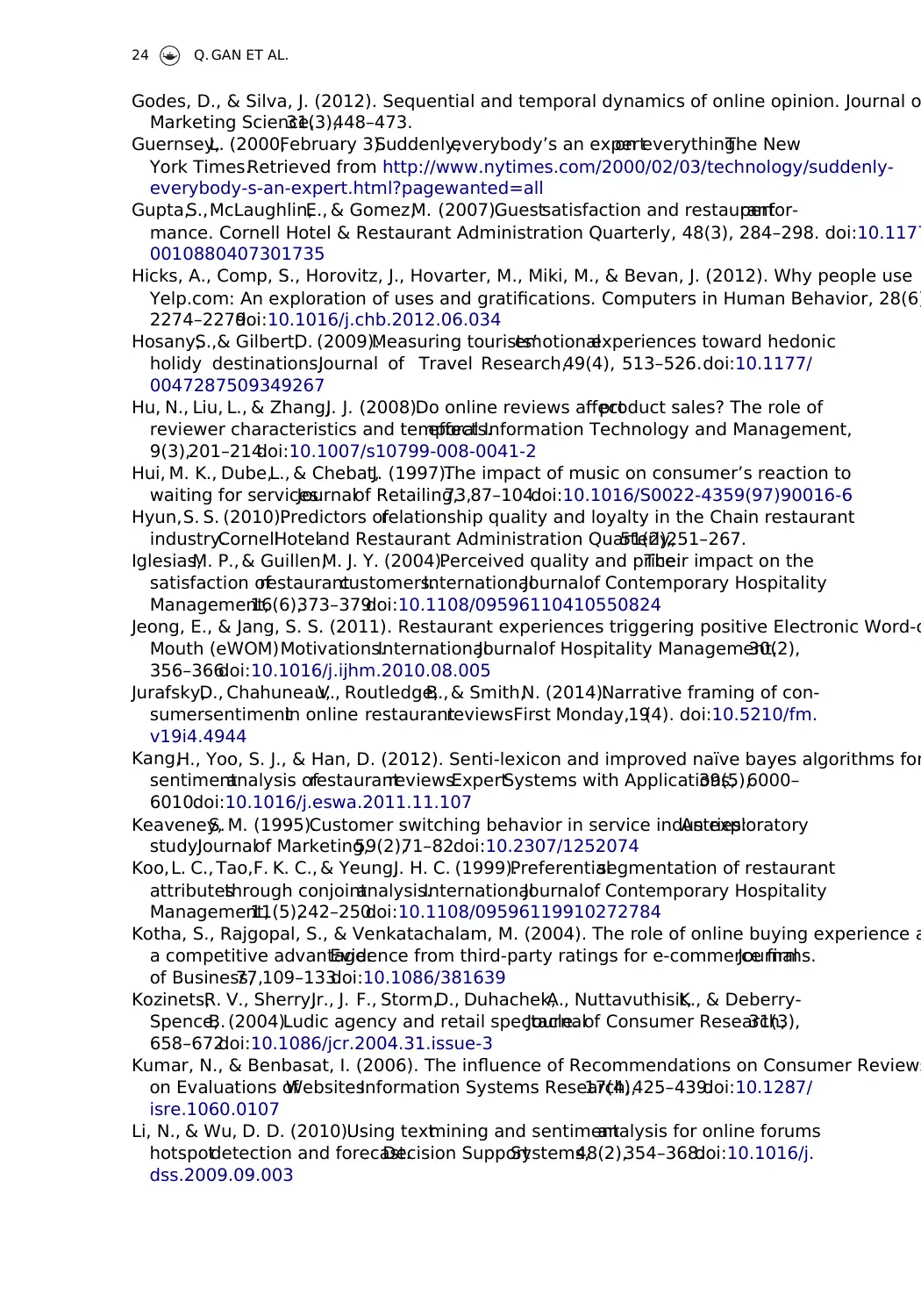
Godes, D., & Silva, J. (2012). Sequential and temporal dynamics of online opinion. Journal o
Marketing Science,31(3),448–473.
Guernsey,L. (2000,February 3).Suddenly,everybody’s an experton everything.The New
York Times.Retrieved from http://www.nytimes.com/2000/02/03/technology/suddenly-
everybody-s-an-expert.html?pagewanted=all
Gupta,S.,McLaughlin,E., & Gomez,M. (2007).Guestsatisfaction and restaurantperfor-
mance. Cornell Hotel & Restaurant Administration Quarterly, 48(3), 284–298. doi:10.1177
0010880407301735
Hicks, A., Comp, S., Horovitz, J., Hovarter, M., Miki, M., & Bevan, J. (2012). Why people use
Yelp.com: An exploration of uses and gratifications. Computers in Human Behavior, 28(6)
2274–2279.doi:10.1016/j.chb.2012.06.034
Hosany,S.,& Gilbert,D. (2009).Measuring tourists’emotionalexperiences toward hedonic
holidy destinations.Journal of Travel Research,49(4), 513–526.doi:10.1177/
0047287509349267
Hu, N., Liu, L., & Zhang,J. J. (2008).Do online reviews affectproduct sales? The role of
reviewer characteristics and temporaleffects.Information Technology and Management,
9(3),201–214.doi:10.1007/s10799-008-0041-2
Hui, M. K., Dube,L., & Chebat,J. (1997).The impact of music on consumer’s reaction to
waiting for services.Journalof Retailing,73,87–104.doi:10.1016/S0022-4359(97)90016-6
Hyun,S. S. (2010).Predictors ofrelationship quality and loyalty in the Chain restaurant
industry.CornellHoteland Restaurant Administration Quarterly,51(2),251–267.
Iglesias,M. P., & Guillen,M. J. Y. (2004).Perceived quality and price:Their impact on the
satisfaction ofrestaurantcustomers.InternationalJournalof Contemporary Hospitality
Management,16(6),373–379.doi:10.1108/09596110410550824
Jeong, E., & Jang, S. S. (2011). Restaurant experiences triggering positive Electronic Word-o
Mouth (eWOM)Motivations.InternationalJournalof Hospitality Management,30(2),
356–366.doi:10.1016/j.ijhm.2010.08.005
Jurafsky,D., Chahuneau,V., Routledge,B., & Smith,N. (2014).Narrative framing of con-
sumersentimentin online restaurantreviews.First Monday,19(4). doi:10.5210/fm.
v19i4.4944
Kang,H., Yoo, S. J., & Han, D. (2012). Senti-lexicon and improved naïve bayes algorithms for
sentimentanalysis ofrestaurantreviews.ExpertSystems with Applications,39(5),6000–
6010.doi:10.1016/j.eswa.2011.11.107
Keaveney,S. M. (1995).Customer switching behavior in service industries:An exploratory
study.Journalof Marketing,59(2),71–82.doi:10.2307/1252074
Koo,L. C., Tao,F. K. C., & Yeung,J. H. C. (1999).Preferentialsegmentation of restaurant
attributesthrough conjointanalysis.InternationalJournalof Contemporary Hospitality
Management,11(5),242–250.doi:10.1108/09596119910272784
Kotha, S., Rajgopal, S., & Venkatachalam, M. (2004). The role of online buying experience a
a competitive advantage:Evidence from third-party ratings for e-commerce firms.Journal
of Business,77,109–133.doi:10.1086/381639
Kozinets,R. V., Sherry,Jr., J. F., Storm,D., Duhachek,A., Nuttavuthisit,K., & Deberry-
Spence,B. (2004).Ludic agency and retail spectacle.Journalof Consumer Research,31(3),
658–672.doi:10.1086/jcr.2004.31.issue-3
Kumar, N., & Benbasat, I. (2006). The influence of Recommendations on Consumer Reviews
on Evaluations ofWebsites.Information Systems Research,17(4),425–439.doi:10.1287/
isre.1060.0107
Li, N., & Wu, D. D. (2010).Using textmining and sentimentanalysis for online forums
hotspotdetection and forecast.Decision SupportSystems,48(2),354–368.doi:10.1016/j.
dss.2009.09.003
24 Q. GAN ET AL.
Marketing Science,31(3),448–473.
Guernsey,L. (2000,February 3).Suddenly,everybody’s an experton everything.The New
York Times.Retrieved from http://www.nytimes.com/2000/02/03/technology/suddenly-
everybody-s-an-expert.html?pagewanted=all
Gupta,S.,McLaughlin,E., & Gomez,M. (2007).Guestsatisfaction and restaurantperfor-
mance. Cornell Hotel & Restaurant Administration Quarterly, 48(3), 284–298. doi:10.1177
0010880407301735
Hicks, A., Comp, S., Horovitz, J., Hovarter, M., Miki, M., & Bevan, J. (2012). Why people use
Yelp.com: An exploration of uses and gratifications. Computers in Human Behavior, 28(6)
2274–2279.doi:10.1016/j.chb.2012.06.034
Hosany,S.,& Gilbert,D. (2009).Measuring tourists’emotionalexperiences toward hedonic
holidy destinations.Journal of Travel Research,49(4), 513–526.doi:10.1177/
0047287509349267
Hu, N., Liu, L., & Zhang,J. J. (2008).Do online reviews affectproduct sales? The role of
reviewer characteristics and temporaleffects.Information Technology and Management,
9(3),201–214.doi:10.1007/s10799-008-0041-2
Hui, M. K., Dube,L., & Chebat,J. (1997).The impact of music on consumer’s reaction to
waiting for services.Journalof Retailing,73,87–104.doi:10.1016/S0022-4359(97)90016-6
Hyun,S. S. (2010).Predictors ofrelationship quality and loyalty in the Chain restaurant
industry.CornellHoteland Restaurant Administration Quarterly,51(2),251–267.
Iglesias,M. P., & Guillen,M. J. Y. (2004).Perceived quality and price:Their impact on the
satisfaction ofrestaurantcustomers.InternationalJournalof Contemporary Hospitality
Management,16(6),373–379.doi:10.1108/09596110410550824
Jeong, E., & Jang, S. S. (2011). Restaurant experiences triggering positive Electronic Word-o
Mouth (eWOM)Motivations.InternationalJournalof Hospitality Management,30(2),
356–366.doi:10.1016/j.ijhm.2010.08.005
Jurafsky,D., Chahuneau,V., Routledge,B., & Smith,N. (2014).Narrative framing of con-
sumersentimentin online restaurantreviews.First Monday,19(4). doi:10.5210/fm.
v19i4.4944
Kang,H., Yoo, S. J., & Han, D. (2012). Senti-lexicon and improved naïve bayes algorithms for
sentimentanalysis ofrestaurantreviews.ExpertSystems with Applications,39(5),6000–
6010.doi:10.1016/j.eswa.2011.11.107
Keaveney,S. M. (1995).Customer switching behavior in service industries:An exploratory
study.Journalof Marketing,59(2),71–82.doi:10.2307/1252074
Koo,L. C., Tao,F. K. C., & Yeung,J. H. C. (1999).Preferentialsegmentation of restaurant
attributesthrough conjointanalysis.InternationalJournalof Contemporary Hospitality
Management,11(5),242–250.doi:10.1108/09596119910272784
Kotha, S., Rajgopal, S., & Venkatachalam, M. (2004). The role of online buying experience a
a competitive advantage:Evidence from third-party ratings for e-commerce firms.Journal
of Business,77,109–133.doi:10.1086/381639
Kozinets,R. V., Sherry,Jr., J. F., Storm,D., Duhachek,A., Nuttavuthisit,K., & Deberry-
Spence,B. (2004).Ludic agency and retail spectacle.Journalof Consumer Research,31(3),
658–672.doi:10.1086/jcr.2004.31.issue-3
Kumar, N., & Benbasat, I. (2006). The influence of Recommendations on Consumer Reviews
on Evaluations ofWebsites.Information Systems Research,17(4),425–439.doi:10.1287/
isre.1060.0107
Li, N., & Wu, D. D. (2010).Using textmining and sentimentanalysis for online forums
hotspotdetection and forecast.Decision SupportSystems,48(2),354–368.doi:10.1016/j.
dss.2009.09.003
24 Q. GAN ET AL.
Paraphrase This Document
Need a fresh take? Get an instant paraphrase of this document with our AI Paraphraser
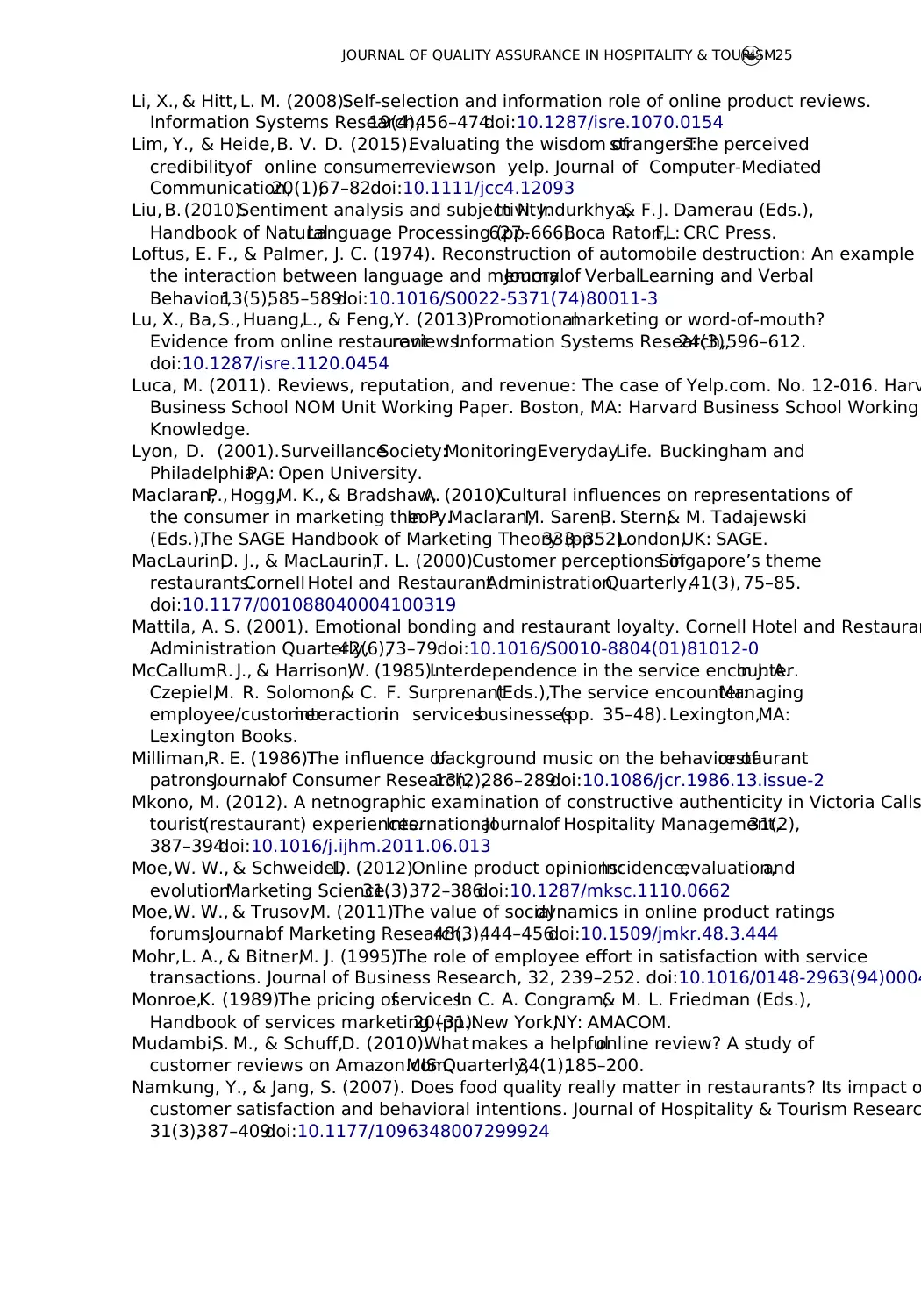
Li, X., & Hitt, L. M. (2008).Self-selection and information role of online product reviews.
Information Systems Research,19(4),456–474.doi:10.1287/isre.1070.0154
Lim, Y., & Heide,B. V. D. (2015).Evaluating the wisdom ofstrangers:The perceived
credibilityof online consumerreviewson yelp. Journal of Computer-Mediated
Communication,20(1),67–82.doi:10.1111/jcc4.12093
Liu, B. (2010).Sentiment analysis and subjectivity.In N. Indurkhya,& F. J. Damerau (Eds.),
Handbook of NaturalLanguage Processing (pp.627–666).Boca Raton,FL: CRC Press.
Loftus, E. F., & Palmer, J. C. (1974). Reconstruction of automobile destruction: An example o
the interaction between language and memory.Journalof VerbalLearning and Verbal
Behavior,13(5),585–589.doi:10.1016/S0022-5371(74)80011-3
Lu, X., Ba, S., Huang,L., & Feng,Y. (2013).Promotionalmarketing or word-of-mouth?
Evidence from online restaurantreviews.Information Systems Research,24(3),596–612.
doi:10.1287/isre.1120.0454
Luca, M. (2011). Reviews, reputation, and revenue: The case of Yelp.com. No. 12-016. Harv
Business School NOM Unit Working Paper. Boston, MA: Harvard Business School Working
Knowledge.
Lyon, D. (2001).SurveillanceSociety:MonitoringEverydayLife. Buckingham and
Philadelphia,PA: Open University.
Maclaran,P., Hogg,M. K., & Bradshaw,A. (2010).Cultural influences on representations of
the consumer in marketing theory.In P. Maclaran,M. Saren,B. Stern,& M. Tadajewski
(Eds.),The SAGE Handbook of Marketing Theory (pp.333–352).London,UK: SAGE.
MacLaurin,D. J., & MacLaurin,T. L. (2000).Customer perceptions ofSingapore’s theme
restaurants.Cornell Hotel and RestaurantAdministrationQuarterly,41(3), 75–85.
doi:10.1177/001088040004100319
Mattila, A. S. (2001). Emotional bonding and restaurant loyalty. Cornell Hotel and Restauran
Administration Quarterly,42(6),73–79.doi:10.1016/S0010-8804(01)81012-0
McCallum,R. J., & Harrison,W. (1985).Interdependence in the service encounter.In J. A.
Czepiel,M. R. Solomon,& C. F. Surprenant(Eds.),The service encounter:Managing
employee/customerinteractionin servicesbusinesses(pp. 35–48). Lexington,MA:
Lexington Books.
Milliman,R. E. (1986).The influence ofbackground music on the behavior ofrestaurant
patrons.Journalof Consumer Research,13(2),286–289.doi:10.1086/jcr.1986.13.issue-2
Mkono, M. (2012). A netnographic examination of constructive authenticity in Victoria Calls
tourist(restaurant) experiences.InternationalJournalof Hospitality Management,31(2),
387–394.doi:10.1016/j.ijhm.2011.06.013
Moe,W. W., & Schweidel,D. (2012).Online product opinions:Incidence,evaluation,and
evolution.Marketing Science,31(3),372–386.doi:10.1287/mksc.1110.0662
Moe,W. W., & Trusov,M. (2011).The value of socialdynamics in online product ratings
forums.Journalof Marketing Research,48(3),444–456.doi:10.1509/jmkr.48.3.444
Mohr,L. A., & Bitner,M. J. (1995).The role of employee effort in satisfaction with service
transactions. Journal of Business Research, 32, 239–252. doi:10.1016/0148-2963(94)0004
Monroe,K. (1989).The pricing ofservices.In C. A. Congram,& M. L. Friedman (Eds.),
Handbook of services marketing (pp.20–31).New York,NY: AMACOM.
Mudambi,S. M., & Schuff,D. (2010).What makes a helpfulonline review? A study of
customer reviews on Amazon.com.MIS Quarterly,34(1),185–200.
Namkung, Y., & Jang, S. (2007). Does food quality really matter in restaurants? Its impact o
customer satisfaction and behavioral intentions. Journal of Hospitality & Tourism Researc
31(3),387–409.doi:10.1177/1096348007299924
JOURNAL OF QUALITY ASSURANCE IN HOSPITALITY & TOURISM25
Information Systems Research,19(4),456–474.doi:10.1287/isre.1070.0154
Lim, Y., & Heide,B. V. D. (2015).Evaluating the wisdom ofstrangers:The perceived
credibilityof online consumerreviewson yelp. Journal of Computer-Mediated
Communication,20(1),67–82.doi:10.1111/jcc4.12093
Liu, B. (2010).Sentiment analysis and subjectivity.In N. Indurkhya,& F. J. Damerau (Eds.),
Handbook of NaturalLanguage Processing (pp.627–666).Boca Raton,FL: CRC Press.
Loftus, E. F., & Palmer, J. C. (1974). Reconstruction of automobile destruction: An example o
the interaction between language and memory.Journalof VerbalLearning and Verbal
Behavior,13(5),585–589.doi:10.1016/S0022-5371(74)80011-3
Lu, X., Ba, S., Huang,L., & Feng,Y. (2013).Promotionalmarketing or word-of-mouth?
Evidence from online restaurantreviews.Information Systems Research,24(3),596–612.
doi:10.1287/isre.1120.0454
Luca, M. (2011). Reviews, reputation, and revenue: The case of Yelp.com. No. 12-016. Harv
Business School NOM Unit Working Paper. Boston, MA: Harvard Business School Working
Knowledge.
Lyon, D. (2001).SurveillanceSociety:MonitoringEverydayLife. Buckingham and
Philadelphia,PA: Open University.
Maclaran,P., Hogg,M. K., & Bradshaw,A. (2010).Cultural influences on representations of
the consumer in marketing theory.In P. Maclaran,M. Saren,B. Stern,& M. Tadajewski
(Eds.),The SAGE Handbook of Marketing Theory (pp.333–352).London,UK: SAGE.
MacLaurin,D. J., & MacLaurin,T. L. (2000).Customer perceptions ofSingapore’s theme
restaurants.Cornell Hotel and RestaurantAdministrationQuarterly,41(3), 75–85.
doi:10.1177/001088040004100319
Mattila, A. S. (2001). Emotional bonding and restaurant loyalty. Cornell Hotel and Restauran
Administration Quarterly,42(6),73–79.doi:10.1016/S0010-8804(01)81012-0
McCallum,R. J., & Harrison,W. (1985).Interdependence in the service encounter.In J. A.
Czepiel,M. R. Solomon,& C. F. Surprenant(Eds.),The service encounter:Managing
employee/customerinteractionin servicesbusinesses(pp. 35–48). Lexington,MA:
Lexington Books.
Milliman,R. E. (1986).The influence ofbackground music on the behavior ofrestaurant
patrons.Journalof Consumer Research,13(2),286–289.doi:10.1086/jcr.1986.13.issue-2
Mkono, M. (2012). A netnographic examination of constructive authenticity in Victoria Calls
tourist(restaurant) experiences.InternationalJournalof Hospitality Management,31(2),
387–394.doi:10.1016/j.ijhm.2011.06.013
Moe,W. W., & Schweidel,D. (2012).Online product opinions:Incidence,evaluation,and
evolution.Marketing Science,31(3),372–386.doi:10.1287/mksc.1110.0662
Moe,W. W., & Trusov,M. (2011).The value of socialdynamics in online product ratings
forums.Journalof Marketing Research,48(3),444–456.doi:10.1509/jmkr.48.3.444
Mohr,L. A., & Bitner,M. J. (1995).The role of employee effort in satisfaction with service
transactions. Journal of Business Research, 32, 239–252. doi:10.1016/0148-2963(94)0004
Monroe,K. (1989).The pricing ofservices.In C. A. Congram,& M. L. Friedman (Eds.),
Handbook of services marketing (pp.20–31).New York,NY: AMACOM.
Mudambi,S. M., & Schuff,D. (2010).What makes a helpfulonline review? A study of
customer reviews on Amazon.com.MIS Quarterly,34(1),185–200.
Namkung, Y., & Jang, S. (2007). Does food quality really matter in restaurants? Its impact o
customer satisfaction and behavioral intentions. Journal of Hospitality & Tourism Researc
31(3),387–409.doi:10.1177/1096348007299924
JOURNAL OF QUALITY ASSURANCE IN HOSPITALITY & TOURISM25
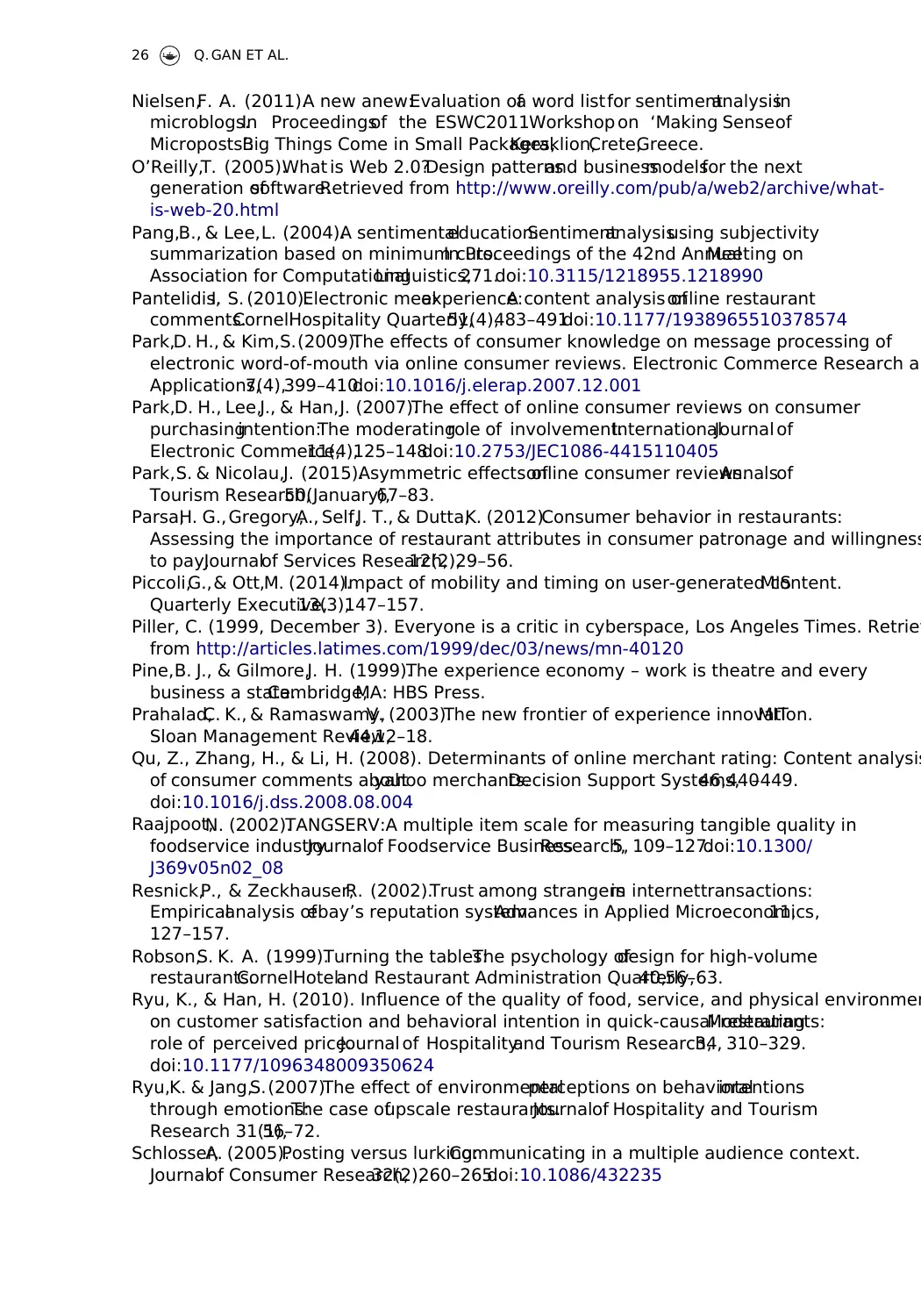
Nielsen,F. A. (2011).A new anew:Evaluation ofa word listfor sentimentanalysisin
microblogs.In Proceedingsof the ESWC2011Workshop on ‘Making Senseof
Microposts’:Big Things Come in Small Packages,Keraklion,Crete,Greece.
O’Reilly,T. (2005).What is Web 2.0?Design patternsand businessmodelsfor the next
generation ofsoftware.Retrieved from http://www.oreilly.com/pub/a/web2/archive/what-
is-web-20.html
Pang,B., & Lee,L. (2004).A sentimentaleducation:Sentimentanalysisusing subjectivity
summarization based on minimum cuts.In Proceedings of the 42nd AnnualMeeting on
Association for ComputationalLinguistics,271.doi:10.3115/1218955.1218990
Pantelidis,I. S. (2010).Electronic mealexperience:A content analysis ofonline restaurant
comments.CornellHospitality Quarterly,51(4),483–491.doi:10.1177/1938965510378574
Park,D. H., & Kim,S.(2009).The effects of consumer knowledge on message processing of
electronic word-of-mouth via online consumer reviews. Electronic Commerce Research an
Applications,7(4),399–410.doi:10.1016/j.elerap.2007.12.001
Park,D. H., Lee,J., & Han,J. (2007).The effect of online consumer reviews on consumer
purchasingintention:The moderatingrole of involvement.InternationalJournal of
Electronic Commerce,11(4),125–148.doi:10.2753/JEC1086-4415110405
Park,S. & Nicolau,J. (2015).Asymmetric effects ofonline consumer reviews.Annalsof
Tourism Research,50(January),67–83.
Parsa,H. G., Gregory,A., Self,J. T., & Dutta,K. (2012).Consumer behavior in restaurants:
Assessing the importance of restaurant attributes in consumer patronage and willingness
to pay.Journalof Services Research,12(2),29–56.
Piccoli,G.,& Ott,M. (2014).Impact of mobility and timing on user-generated content.MIS
Quarterly Executive,13(3),147–157.
Piller, C. (1999, December 3). Everyone is a critic in cyberspace, Los Angeles Times. Retriev
from http://articles.latimes.com/1999/dec/03/news/mn-40120
Pine,B. J., & Gilmore,J. H. (1999).The experience economy – work is theatre and every
business a state.Cambridge,MA: HBS Press.
Prahalad,C. K., & Ramaswamy,V. (2003).The new frontier of experience innovation.MIT
Sloan Management Review,44,12–18.
Qu, Z., Zhang, H., & Li, H. (2008). Determinants of online merchant rating: Content analysis
of consumer comments aboutyahoo merchants.Decision Support Systems,46,440–449.
doi:10.1016/j.dss.2008.08.004
Raajpoot,N. (2002).TANGSERV:A multiple item scale for measuring tangible quality in
foodservice industry.Journalof Foodservice BusinessResearch,5, 109–127.doi:10.1300/
J369v05n02_08
Resnick,P., & Zeckhauser,R. (2002).Trust among strangersin internettransactions:
Empiricalanalysis ofebay’s reputation system.Advances in Applied Microeconomics,11,
127–157.
Robson,S. K. A. (1999).Turning the tables:The psychology ofdesign for high-volume
restaurants.CornellHoteland Restaurant Administration Quarterly,40,56–63.
Ryu, K., & Han, H. (2010). Influence of the quality of food, service, and physical environmen
on customer satisfaction and behavioral intention in quick-causal restaurants:Moderating
role of perceived price.Journal of Hospitalityand Tourism Research,34, 310–329.
doi:10.1177/1096348009350624
Ryu,K. & Jang,S.(2007).The effect of environmentalperceptions on behavioralintentions
through emotions:The case ofupscale restaurants.Journalof Hospitality and Tourism
Research 31(1),56–72.
Schlosser,A. (2005).Posting versus lurking:Communicating in a multiple audience context.
Journalof Consumer Research,32(2),260–265.doi:10.1086/432235
26 Q. GAN ET AL.
microblogs.In Proceedingsof the ESWC2011Workshop on ‘Making Senseof
Microposts’:Big Things Come in Small Packages,Keraklion,Crete,Greece.
O’Reilly,T. (2005).What is Web 2.0?Design patternsand businessmodelsfor the next
generation ofsoftware.Retrieved from http://www.oreilly.com/pub/a/web2/archive/what-
is-web-20.html
Pang,B., & Lee,L. (2004).A sentimentaleducation:Sentimentanalysisusing subjectivity
summarization based on minimum cuts.In Proceedings of the 42nd AnnualMeeting on
Association for ComputationalLinguistics,271.doi:10.3115/1218955.1218990
Pantelidis,I. S. (2010).Electronic mealexperience:A content analysis ofonline restaurant
comments.CornellHospitality Quarterly,51(4),483–491.doi:10.1177/1938965510378574
Park,D. H., & Kim,S.(2009).The effects of consumer knowledge on message processing of
electronic word-of-mouth via online consumer reviews. Electronic Commerce Research an
Applications,7(4),399–410.doi:10.1016/j.elerap.2007.12.001
Park,D. H., Lee,J., & Han,J. (2007).The effect of online consumer reviews on consumer
purchasingintention:The moderatingrole of involvement.InternationalJournal of
Electronic Commerce,11(4),125–148.doi:10.2753/JEC1086-4415110405
Park,S. & Nicolau,J. (2015).Asymmetric effects ofonline consumer reviews.Annalsof
Tourism Research,50(January),67–83.
Parsa,H. G., Gregory,A., Self,J. T., & Dutta,K. (2012).Consumer behavior in restaurants:
Assessing the importance of restaurant attributes in consumer patronage and willingness
to pay.Journalof Services Research,12(2),29–56.
Piccoli,G.,& Ott,M. (2014).Impact of mobility and timing on user-generated content.MIS
Quarterly Executive,13(3),147–157.
Piller, C. (1999, December 3). Everyone is a critic in cyberspace, Los Angeles Times. Retriev
from http://articles.latimes.com/1999/dec/03/news/mn-40120
Pine,B. J., & Gilmore,J. H. (1999).The experience economy – work is theatre and every
business a state.Cambridge,MA: HBS Press.
Prahalad,C. K., & Ramaswamy,V. (2003).The new frontier of experience innovation.MIT
Sloan Management Review,44,12–18.
Qu, Z., Zhang, H., & Li, H. (2008). Determinants of online merchant rating: Content analysis
of consumer comments aboutyahoo merchants.Decision Support Systems,46,440–449.
doi:10.1016/j.dss.2008.08.004
Raajpoot,N. (2002).TANGSERV:A multiple item scale for measuring tangible quality in
foodservice industry.Journalof Foodservice BusinessResearch,5, 109–127.doi:10.1300/
J369v05n02_08
Resnick,P., & Zeckhauser,R. (2002).Trust among strangersin internettransactions:
Empiricalanalysis ofebay’s reputation system.Advances in Applied Microeconomics,11,
127–157.
Robson,S. K. A. (1999).Turning the tables:The psychology ofdesign for high-volume
restaurants.CornellHoteland Restaurant Administration Quarterly,40,56–63.
Ryu, K., & Han, H. (2010). Influence of the quality of food, service, and physical environmen
on customer satisfaction and behavioral intention in quick-causal restaurants:Moderating
role of perceived price.Journal of Hospitalityand Tourism Research,34, 310–329.
doi:10.1177/1096348009350624
Ryu,K. & Jang,S.(2007).The effect of environmentalperceptions on behavioralintentions
through emotions:The case ofupscale restaurants.Journalof Hospitality and Tourism
Research 31(1),56–72.
Schlosser,A. (2005).Posting versus lurking:Communicating in a multiple audience context.
Journalof Consumer Research,32(2),260–265.doi:10.1086/432235
26 Q. GAN ET AL.
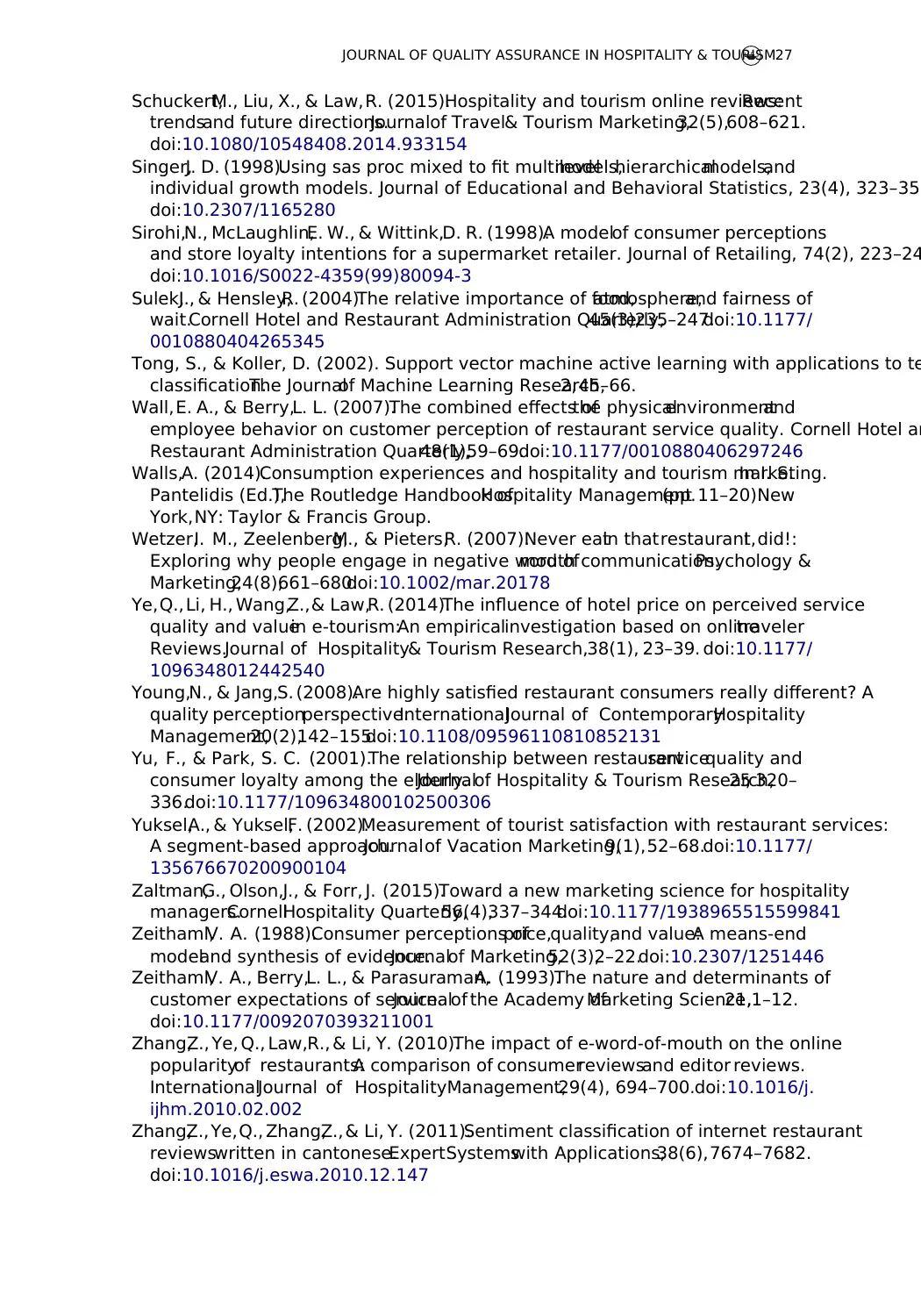
Schuckert,M., Liu, X., & Law,R. (2015).Hospitality and tourism online reviews:Recent
trendsand future directions.Journalof Travel& Tourism Marketing,32(5),608–621.
doi:10.1080/10548408.2014.933154
Singer,J. D. (1998).Using sas proc mixed to fit multilevelmodels,hierarchicalmodels,and
individual growth models. Journal of Educational and Behavioral Statistics, 23(4), 323–355
doi:10.2307/1165280
Sirohi,N., McLaughlin,E. W., & Wittink,D. R. (1998).A modelof consumer perceptions
and store loyalty intentions for a supermarket retailer. Journal of Retailing, 74(2), 223–24
doi:10.1016/S0022-4359(99)80094-3
Sulek,J., & Hensley,R. (2004).The relative importance of food,atmosphere,and fairness of
wait.Cornell Hotel and Restaurant Administration Quarterly,45(3),235–247.doi:10.1177/
0010880404265345
Tong, S., & Koller, D. (2002). Support vector machine active learning with applications to te
classification.The Journalof Machine Learning Research,2,45–66.
Wall,E. A., & Berry,L. L. (2007).The combined effects ofthe physicalenvironmentand
employee behavior on customer perception of restaurant service quality. Cornell Hotel an
Restaurant Administration Quarterly,48(1),59–69.doi:10.1177/0010880406297246
Walls,A. (2014).Consumption experiences and hospitality and tourism marketing.In I. S.
Pantelidis (Ed.),The Routledge Handbook ofHospitality Management(pp.11–20).New
York,NY: Taylor & Francis Group.
Wetzer,I. M., Zeelenberg,M., & Pieters,R. (2007).Never eatin thatrestaurant,I did!:
Exploring why people engage in negative word ofmouth communication.Psychology &
Marketing,24(8),661–680.doi:10.1002/mar.20178
Ye,Q., Li, H., Wang,Z.,& Law,R. (2014).The influence of hotel price on perceived service
quality and valuein e-tourism:An empiricalinvestigation based on onlinetraveler
Reviews.Journal of Hospitality& Tourism Research,38(1), 23–39. doi:10.1177/
1096348012442540
Young,N., & Jang,S. (2008).Are highly satisfied restaurant consumers really different? A
quality perceptionperspective.InternationalJournal of ContemporaryHospitality
Management,20(2),142–155.doi:10.1108/09596110810852131
Yu, F., & Park, S. C. (2001).The relationship between restaurantservicequality and
consumer loyalty among the elderly.Journalof Hospitality & Tourism Research,25, 320–
336.doi:10.1177/109634800102500306
Yuksel,A., & Yuksel,F. (2002).Measurement of tourist satisfaction with restaurant services:
A segment-based approach.Journalof Vacation Marketing,9(1),52–68.doi:10.1177/
135676670200900104
Zaltman,G., Olson,J., & Forr, J. (2015).Toward a new marketing science for hospitality
managers.CornellHospitality Quarterly,56(4),337–344.doi:10.1177/1938965515599841
Zeithaml,V. A. (1988).Consumer perceptions ofprice,quality,and value:A means-end
modeland synthesis of evidence.Journalof Marketing,52(3),2–22.doi:10.2307/1251446
Zeithaml,V. A., Berry,L. L., & Parasuraman,A. (1993).The nature and determinants of
customer expectations of service.Journalof the Academy ofMarketing Science,21,1–12.
doi:10.1177/0092070393211001
Zhang,Z., Ye, Q., Law,R., & Li, Y. (2010).The impact of e-word-of-mouth on the online
popularityof restaurants:A comparison of consumerreviewsand editor reviews.
InternationalJournal of HospitalityManagement,29(4), 694–700.doi:10.1016/j.
ijhm.2010.02.002
Zhang,Z., Ye,Q., Zhang,Z.,& Li, Y. (2011).Sentiment classification of internet restaurant
reviewswritten in cantonese.ExpertSystemswith Applications,38(6),7674–7682.
doi:10.1016/j.eswa.2010.12.147
JOURNAL OF QUALITY ASSURANCE IN HOSPITALITY & TOURISM27
trendsand future directions.Journalof Travel& Tourism Marketing,32(5),608–621.
doi:10.1080/10548408.2014.933154
Singer,J. D. (1998).Using sas proc mixed to fit multilevelmodels,hierarchicalmodels,and
individual growth models. Journal of Educational and Behavioral Statistics, 23(4), 323–355
doi:10.2307/1165280
Sirohi,N., McLaughlin,E. W., & Wittink,D. R. (1998).A modelof consumer perceptions
and store loyalty intentions for a supermarket retailer. Journal of Retailing, 74(2), 223–24
doi:10.1016/S0022-4359(99)80094-3
Sulek,J., & Hensley,R. (2004).The relative importance of food,atmosphere,and fairness of
wait.Cornell Hotel and Restaurant Administration Quarterly,45(3),235–247.doi:10.1177/
0010880404265345
Tong, S., & Koller, D. (2002). Support vector machine active learning with applications to te
classification.The Journalof Machine Learning Research,2,45–66.
Wall,E. A., & Berry,L. L. (2007).The combined effects ofthe physicalenvironmentand
employee behavior on customer perception of restaurant service quality. Cornell Hotel an
Restaurant Administration Quarterly,48(1),59–69.doi:10.1177/0010880406297246
Walls,A. (2014).Consumption experiences and hospitality and tourism marketing.In I. S.
Pantelidis (Ed.),The Routledge Handbook ofHospitality Management(pp.11–20).New
York,NY: Taylor & Francis Group.
Wetzer,I. M., Zeelenberg,M., & Pieters,R. (2007).Never eatin thatrestaurant,I did!:
Exploring why people engage in negative word ofmouth communication.Psychology &
Marketing,24(8),661–680.doi:10.1002/mar.20178
Ye,Q., Li, H., Wang,Z.,& Law,R. (2014).The influence of hotel price on perceived service
quality and valuein e-tourism:An empiricalinvestigation based on onlinetraveler
Reviews.Journal of Hospitality& Tourism Research,38(1), 23–39. doi:10.1177/
1096348012442540
Young,N., & Jang,S. (2008).Are highly satisfied restaurant consumers really different? A
quality perceptionperspective.InternationalJournal of ContemporaryHospitality
Management,20(2),142–155.doi:10.1108/09596110810852131
Yu, F., & Park, S. C. (2001).The relationship between restaurantservicequality and
consumer loyalty among the elderly.Journalof Hospitality & Tourism Research,25, 320–
336.doi:10.1177/109634800102500306
Yuksel,A., & Yuksel,F. (2002).Measurement of tourist satisfaction with restaurant services:
A segment-based approach.Journalof Vacation Marketing,9(1),52–68.doi:10.1177/
135676670200900104
Zaltman,G., Olson,J., & Forr, J. (2015).Toward a new marketing science for hospitality
managers.CornellHospitality Quarterly,56(4),337–344.doi:10.1177/1938965515599841
Zeithaml,V. A. (1988).Consumer perceptions ofprice,quality,and value:A means-end
modeland synthesis of evidence.Journalof Marketing,52(3),2–22.doi:10.2307/1251446
Zeithaml,V. A., Berry,L. L., & Parasuraman,A. (1993).The nature and determinants of
customer expectations of service.Journalof the Academy ofMarketing Science,21,1–12.
doi:10.1177/0092070393211001
Zhang,Z., Ye, Q., Law,R., & Li, Y. (2010).The impact of e-word-of-mouth on the online
popularityof restaurants:A comparison of consumerreviewsand editor reviews.
InternationalJournal of HospitalityManagement,29(4), 694–700.doi:10.1016/j.
ijhm.2010.02.002
Zhang,Z., Ye,Q., Zhang,Z.,& Li, Y. (2011).Sentiment classification of internet restaurant
reviewswritten in cantonese.ExpertSystemswith Applications,38(6),7674–7682.
doi:10.1016/j.eswa.2010.12.147
JOURNAL OF QUALITY ASSURANCE IN HOSPITALITY & TOURISM27
Secure Best Marks with AI Grader
Need help grading? Try our AI Grader for instant feedback on your assignments.

Zhang,Z., Zhang,Z., & Law, R. (2014a).Positive and negative word ofmouth about
restaurants:Exploring theasymmetricimpactof the performanceof attributes.Asia
Pacific Journalof Tourism Research,19(2),162–180.doi:10.1080/10941665.2012.735680
Zhang,Z., Zhang,Z., & Law, R. (2014b).Relative importance and combined effectsof
attributeson customersatisfaction.The ServiceIndustriesJournal, 34(6),550–566.
doi:10.1080/02642069.2014.871537
Zhang, Z., Zhang, Z., Wang, F., Law, R., & Li, D. (2013). Factors influencing the effectivenes
of online group buying in the restaurantindustry.InternationalJournalof Hospitality
Management,35,237–245.doi:10.1016/j.ijhm.2013.06.012
28 Q. GAN ET AL.
restaurants:Exploring theasymmetricimpactof the performanceof attributes.Asia
Pacific Journalof Tourism Research,19(2),162–180.doi:10.1080/10941665.2012.735680
Zhang,Z., Zhang,Z., & Law, R. (2014b).Relative importance and combined effectsof
attributeson customersatisfaction.The ServiceIndustriesJournal, 34(6),550–566.
doi:10.1080/02642069.2014.871537
Zhang, Z., Zhang, Z., Wang, F., Law, R., & Li, D. (2013). Factors influencing the effectivenes
of online group buying in the restaurantindustry.InternationalJournalof Hospitality
Management,35,237–245.doi:10.1016/j.ijhm.2013.06.012
28 Q. GAN ET AL.
1 out of 29
Related Documents
Your All-in-One AI-Powered Toolkit for Academic Success.
+13062052269
info@desklib.com
Available 24*7 on WhatsApp / Email
![[object Object]](/_next/static/media/star-bottom.7253800d.svg)
Unlock your academic potential
© 2024 | Zucol Services PVT LTD | All rights reserved.
